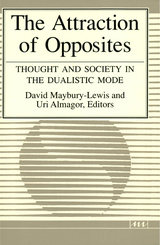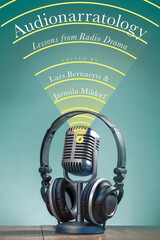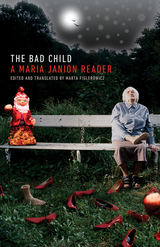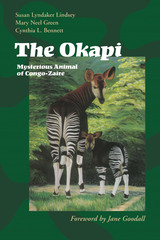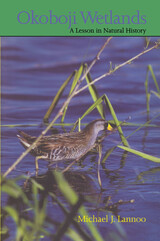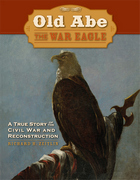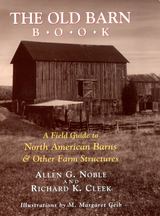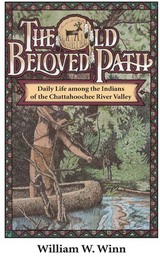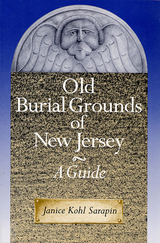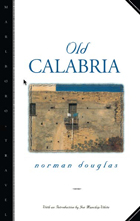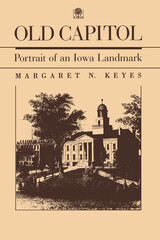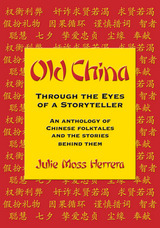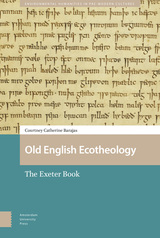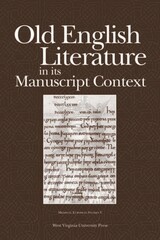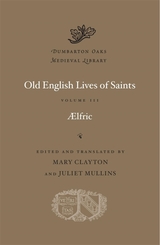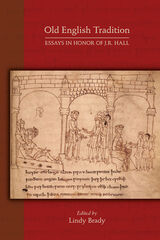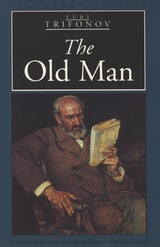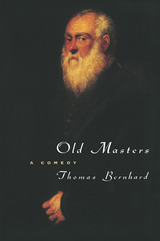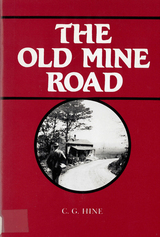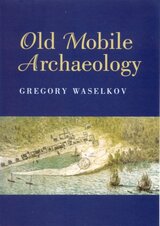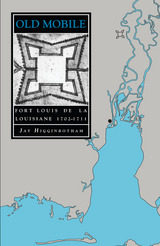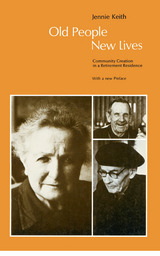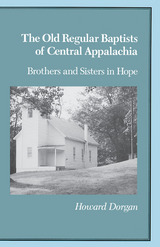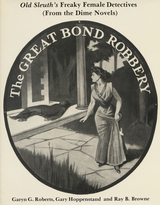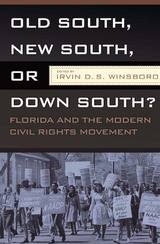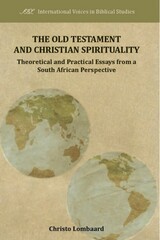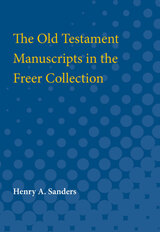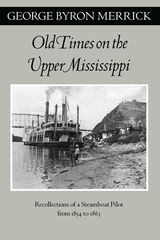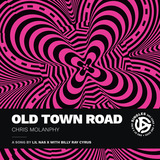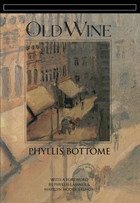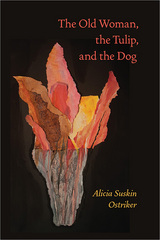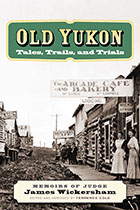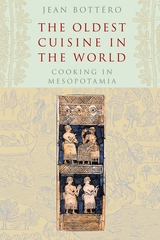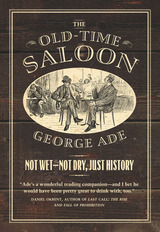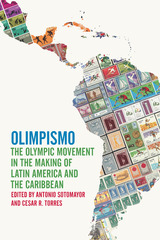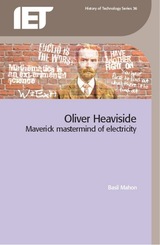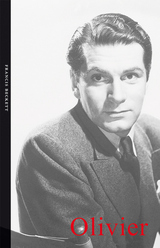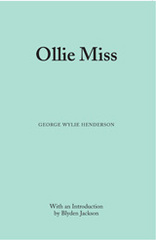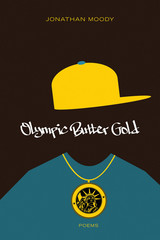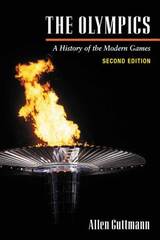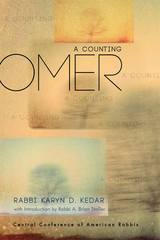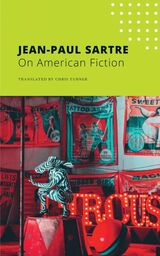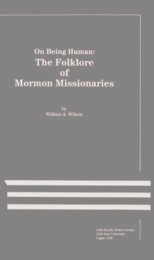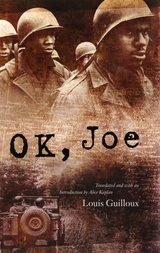 OK, Joe
Louis Guilloux
University of Chicago Press, 2003 "OK, Joe!" the American lieutenant calls out to his driver. He hops into his jeep and heads out through French countryside just liberated from the Nazis. With him is the narrator of this novel, Louis, a Frenchman engaged by the American Army as an interpreter. Louis serves a group of American officers charged with bringing GIs to account for crimes—including rape and murder—against French citizens. The friendly banter of the American soldiers and the beautiful Breton landscape stand in contrast to Louis's task and his growing awareness of the moral failings of the Americans sent to liberate France. For not only must Louis translate the accounts of horrific crimes, he comes to realize that the accused men are almost all African American.
Based on diaries that the author kept during his service as a translator for the U.S. Army in the aftermath of D-Day, OK, Joe follows Louis and the Americans as they negotiate with witnesses, investigate the crimes, and stage the courts-martial. Guilloux has an uncanny ear for the snappy speech of the GIs and a tenderness for the young, unworldly men with whom he spends his days, and, in evocative vignettes and dialogues, he sketches the complex intersection of hope and disillusionment that prevailed after the war. Although the American presence in France has been romanticized in countless books and movies, OK, Joe offers something exceedingly rare: a penetrating French perspective on post-D-Day GI culture, a chronicle of trenchant racism and lost ideals.
The Okapi: Mysterious Animal of Congo-Zaire
By Susan Lyndaker Lindsey, Mary Neel Green, and Cynthia L. Bennett
University of Texas Press, 1999 Congo-Zaire contains Africa's largest remaining tracts of intact rain forest, making it one of the most important regions for biodiversity conservation. Its Ituri Forest is home to plants and animals native to nowhere else on earth, including the elusive and little-known okapi. In this popularly written book, three long-time observers of the okapi present a complete, contemporary natural history of this appealing relative of the giraffe. They recount its discovery by European explorers and describe its appearance and life cycle. They also discuss current efforts to preserve the species, both in the wild and at zoos around the world. Illustrated with charming line drawings, The Okapi will be a valuable resource for conservationists and zoo visitors alike-indeed anyone fascinated by the mysterious animal of Congo-Zaire.
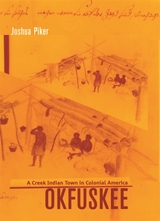 Okfuskee: A Creek Indian Town in Colonial America
Joshua Piker
Harvard University Press, 2004 A work of original scholarship and compelling sweep, Okfuskee is a community-centered Indian history with an explicitly comparativist agenda. Joshua Piker uses the history of Okfuskee, an eighteenth-century Creek town, to reframe standard narratives of both Native and American experiences.
This unique, detailed perspective on local life in a Native society allows us to truly understand both the pervasiveness of colonialism's influence and the inventiveness of Native responses. At the same time, by comparing the Okfuskees' experiences to those of their contemporaries in colonial British America, the book provides a nuanced discussion of the ways in which Native and Euro-American histories intersected with, and diverged from, each other.
Piker examines the diplomatic ties that developed between the Okfuskees and their British neighbors; the economic implications of the Okfuskees' shifting world view; the integration of British traders into the town; and the shifting gender and generational relationships in the community. By both providing an in-depth investigation of a colonial-era Indian town in Indian country and placing the Okfuskees within the processes central to early American history, Piker offers a Native history with important implications for American history.
Okoboji Wetlands: A Lesson in Natural History
Michael J. Lannoo
University of Iowa Press, 1996 Lake Okoboji in northwest Iowa is the jewel of the Iowa Great Lakes. A region of wetlands formed by prairie potholes, the area is rich with lakes, sloughs, fens, creeks, prairies, and kettleholes. In this readable and beautifully illustrated volume, Michael Lannoo presents an extensive natural history of Okoboji and its cherished wetlands that examines that world of our grandparents, compares it to today's world, and extrapolates to the world of our grandchildren.
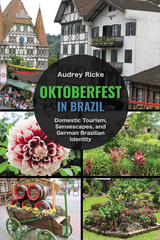 Oktoberfest in Brazil: Domestic Tourism, Sensescapes, and German Brazilian Identity
Audrey Ricke
University of Alabama Press, 2023 Oktoberfest in Brazil: Domestic Tourism, Sensescapes, and German Brazilian Identity is one of the first ethnographies to analyze the tourism industry based on German cultural heritage in southern Brazil. Southern Brazil’s booming domestic tourism industry draws more than 500,000 people to events such as the Oktoberfest in Blumenau. Ricke investigates domestic tourism as sensescapes, focusing on the multiple and layered meanings associated with tourism’s sensory experiences and interactions. The author also introduces the “economy of aesthetics” as a new framework to capture how the sensescapes associated with domestic tourism are intertwined in the negotiation of ethnic, national, and transnational identities. These sensescapes also intersect with discourses on class and race, which are examined as well.
Oktoberfest in Brazil leads readers on a tour through German Brazilian home gardens, folk dance performances, and the largest Oktoberfest in Brazil. These sensory-rich spaces of interaction provide access to different perspectives and types of identity negotiation at multiple levels from the local to the transnational. Ricke illustrates how the emotions and sensory experiences of these sensescapes associated with German cultural heritage function as a means for German Brazilians to negotiate senses of belonging as Brazilians as well as their ethnic and transnational identities.
This book also provides historical and contemporary insights into the politics of citizenship associated with cultural heritage. As politics become more polarized, the need to analyze different ways of communicating through sensory experiences increases. The unique contribution of the economy of aesthetics framework is its ability to capture the influential power of sensory experience in the negotiation of identity and senses of belonging and citizenship more broadly. It provides new insights into how and why some sensory experiences within domestic tourism foster belonging and identity while other experiences reinforce social distinctions and national divisions.
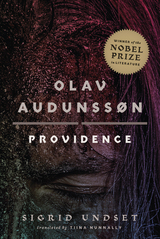 Olav Audunssøn: II. Providence
Sigrid Undset
University of Minnesota Press, 2021 The second volume in the Nobel Prize–winning writer’s epic of medieval Norway, finely capturing Undset’s fluid, natural style in a new English translation, the first in nearly a century
As Norway moves into the fourteenth century, the kingdom continues to be racked by political turmoil and bloody family vendettas that serve as the backdrop for Sigrid Undset’s masterful story about Olav Audunssøn and Ingunn Steinfinnsdatter. Betrothed as children and raised as foster siblings, their unbridled love for each other sets in motion a series of dire events—with a legacy of betrayal, murder, and disgrace that will echo for generations. In Providence, the second of Olav Audunssøn’s four volumes, Olav settles in at his ancestral estate of Hestviken and soon brings Ingunn home as his wife. Both hope to put their troubles behind them as they start a new life together, but the crimes and shameful secrets of the past have a long reach and a tenacious hold. The consequences of sin, suspicion, and familial obligations may prove a greater threat to the pair’s happiness than even their long years of separation. Set in a time when royalty and religion vie for power, and bloodlines and loyalties are effectively law, Providence summons a powerful picture of Northern life in the medieval era, as the Swedish Academy noted in awarding Undset the Nobel Prize. Conveying both the intimate drama of Olav and Ingunn’s marriage and the epic sweep of their story, it is at once a moving and vivid recreation of a vanished world tainted by bloodshed and haunted by sin and retribution. As with her classic Kristin Lavransdatter, Sigrid Undset immersed herself in legal, religious, and historical writings to create in Olav Audunssøn an astoundingly authentic and compelling portrait of Norwegian life in the Middle Ages. And as in her translation of Kristin Lavransdatter, Tiina Nunnally does full justice to Undset’s fluid prose. Undset’s writing style is by turns straightforward and delicately lyrical, conveying the natural world, the complex culture, and the fraught emotional territory against which Olav’s story inexorably unfolds.
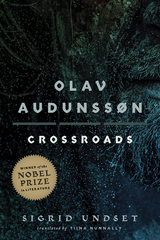 Olav Audunssøn: III. Crossroads
Sigrid Undset
University of Minnesota Press, 2022 The third volume in the Nobel Prize–winning writer’s epic story of medieval Norway, finely capturing Undset’s fluid, natural style in the first English translation in nearly a century
In the early fourteenth century, Norway is a kingdom in political turmoil, struggling with opposing forces within its own borders and drawn into strife with neighboring Sweden and Denmark. Bloody family vendettas and conflicting loyalties sparked by the irrepressible passion of a boy and his foster sister (also his betrothed) have now set in motion a series of terrible consequences—with a legacy of betrayal, murder, and disgrace that will echo down through the generations. Crossroads, the third of Olav Audunssøn’s four volumes, finds Olav heartbroken by loss and further estranged from his son. To escape his grief, Olav leaves his home estate of Hestviken and agrees to serve as captain on a small merchant ship headed to London. There, separated from everything familiar to him, Olav begins a visionary journey that will send him far into the forest and deep into his soul. Questioning past decisions and future plans, Olav must grapple with his own perceptions of love and guilt, sin and penitence, vengeance and forgiveness. Set in a time and place where royalty and religion vie for power, and bloodlines and loyalties are law, Crossroads summons a powerful picture of Northern life in medieval times, as the Swedish Academy noted in awarding Sigrid Undset the Nobel Prize in 1928. Conveying both the intimate drama and epic sweep of Olav’s story as grief and guilt drive him to ever more desperate action, Crossroads is a moving and masterly re-creation of a vanished world tainted by bloodshed and haunted by sin and retribution. As with Kristin Lavransdatter, her earlier medieval epic, Undset immersed herself in the legal, religious, and historical documents of the time while writing Olav Audunssøn to create astoundingly authentic and compelling portraits of Norwegian life in the Middle Ages. And as in her translation of Kristin Lavransdatter, Tiina Nunnally does full justice to Undset’s natural, fluid prose, in a style that delicately and lyrically conveys the natural world, the complex culture, and the fraught emotional territory against which Olav’s story inexorably unfolds.
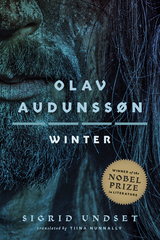 Olav Audunssøn: IV. Winter
Sigrid Undset
University of Minnesota Press, 2023 The fourth and final volume in the Nobel Prize–winning writer’s epic of one man’s fateful life in medieval Norway Set in thirteenth-century Norway, a land racked by political turmoil, bloody family vendettas, and rising tensions between secular powers and an ascendant church, Sigrid Undset’s spellbinding masterpiece now follows the fortunes of Olav Audunssøn to the final, dramatic chapter of his life as it unfolds in Winter, the last volume of the tetralogy. When the orphaned Olav and his foster sister Ingunn became betrothed in their youth, a chain of events was set in motion that eventually led to violence, banishment, and a family separation lasting years. The consequences fracture their marriage and threaten the lineage for generations. Now, at the end of his life, Olav continues to grapple with the guilt of his sins as he watches his children, especially Eirik, make disastrous choices and struggle to find their rightful place in a family haunted by the past. With its precise details and sweeping vision, Olav Audunssøn summons a powerful picture of Northern life in medieval times, as noted by the Swedish Academy in awarding Undset the Nobel Prize in 1928. Conveying both the intimate drama and the epic proportions of Olav’s story at its conclusion, Winter is a moving and masterly recreation of a vanished world tainted by bloodshed and haunted by sin and retribution—yet one that might still offer a chance for redemption. As with Kristin Lavransdatter, her earlier medieval epic, Sigrid Undset wrote Olav Audunssøn after immersive research in the legal, religious, and historical writings of the time to create an astoundingly authentic and compelling portrait of Norwegian life in the Middle Ages. And as in her translation of Kristin Lavransdatter, Tiina Nunnally does full justice to Undset’s natural, fluid prose—in a style by turns plainspoken and delicately lyrical—to convey the natural world, the complex culture, and the fraught emotional territory against which Olav’s story inexorably unfolds.
Old Abe the War Eagle: A True Story of the Civil War And Reconstruction
Richard Zeitlin
Wisconsin Historical Society Press, 1986 The story of Old Abe, the bald eagle that became the mascot of the Eighth Regiment of Wisconsin Volunteer Infantry. It is also the story of the men among whom Old Abe lived: the farmers, loggers, clerks, and immigrants who flocked to the colors in 1861. Reissued in 2012 with a new cover.
 Old Age in a New Age: The Promise of Transformative Nursing Homes
Beth Baker
Vanderbilt University Press, 2007 On investigative visits to nursing homes across the nation, Beth Baker has witnessed profound changes. Culture change leaders are tearing up everything—the floor plans, the flow charts, the schedules, the lousy menus, the attitudes, the rules—and starting from scratch. They are creating extraordinary places where people live in dignity and greet the day with contentment, assisted by employees who feel valued and appreciated. Perhaps most surprising, these homes prove that a high quality of life does not have to cost more. Some of the best homes in the nation serve primarily low-income people who are on Medicaid.
In Old Age in a New Age, Baker tell the story of a better way to live in old age. Although each home is different, they share common values: respecting individual choices; empowering staff; fostering a strong community of elders, staff, family members, and volunteers; redesigning buildings from a hospital model to a home (where pets and children are part of everyday life); and honoring people when they die. Her visits to more than two dozen facilities include those associated with the Eden Alternative, Green House, Kendal, and the Pioneer Network. Whether these transformational homes become the norm or the domain of a lucky few is the question that faces the next generation of elders, the baby boomers.
 Old Age, New Science: Gerontologists and Their Biosocial Visions, 1900-1960
Hyung Wook Park
University of Pittsburgh Press, 2016 Between 1870 and 1940, life expectancy in the United States skyrocketed while the percentage of senior citizens age sixty-five and older more than doubled—a phenomenon owed largely to innovations in medicine and public health. At the same time, the Great Depression was a major tipping point for age discrimination and poverty in the West: seniors were living longer and retiring earlier, but without adequate means to support themselves and their families. The economic disaster of the 1930s alerted scientists, who were actively researching the processes of aging, to the profound social implications of their work—and by the end of the 1950s, the field of gerontology emerged.
Old Age, New Science explores how a group of American and British life scientists contributed to gerontology’s development as a multidisciplinary field. It examines the foundational “biosocial visions” they shared, a byproduct of both their research and the social problems they encountered. Hyung Wook Park shows how these visions shaped popular discourses on aging, directly influenced the institutionalization of gerontology, and also reflected the class, gender, and race biases of their founders.
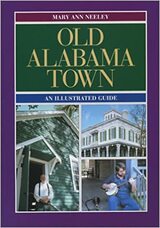 Old Alabama Town: An Illustrated Guide
Mary Ann Neeley
University of Alabama Press, 2002 Old Alabama Town is a visual and historical chronicle of one of the South's important architectural landmarks—four blocks of 19th-century buildings restored to their original condition, collectively forming an educational village that preserves and displays life as it was lived in Alabama from the 1830s through the 1890s. A creation of the Landmarks Foundation of Montgomery, a nonprofit organization developed in 1967, Old Alabama Town displays the lifestyles and environment of the time period through architecture, decorative arts, and living history. The "town" has been made available for students, secondary school educators for field trips, and to tourists for entertainment and family excursions. More than 50 historic structures, all formerly in danger of demolition, have been transported from around central Alabama and restored on site. The Living Block of the village allows visitors to explore a log cabin, dogtrot house, carriage house, "shotgun" house, pole barn, schoolhouse, tavern, grange hall, and grocery. The Working Block allows patrons to visit a blacksmith's shop, drugstore, grist mill, cotton gin, woodcarver's shop, print shop, and cookhouse. Additional regions of the village present some of the most significant historic homes to be preserved in the state: the Cram-Lakin House, Thompson Mansion, and the Ordeman-Mitchell-Shaw House, among others. Designed in full color, this paperback guide is introduced by the author's historical, sociological, and cultural overview of Montgomery. The 45 individual entries detail the history and features of each structure and are supplemented by a map, archival photographs of the buildings, and 60 contempo-rary color photographs. This book will be useful to tourists, preservationists, students and scholars of Alabama history and architecture, and all those interested in an interpretive museum of southern life.
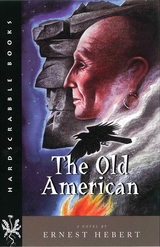 The Old American: A Novel
Ernest Hebert
Dartmouth College Press, 2001 In 1746, Nathan Blake, the first frame house builder in Keene, New Hampshire, was abducted by Algonkians and held in Canada as a slave. Inspired by this dramatic slice of history, novelist Ernest Hebert has written a masterful new novel recreating those years of captivity. Set in New England and Canada during the French and Indian Wars, The Old American is driven by its complex, vividly imagined title character, Caucus-Meteor. By turns shrewd and embittered, ambitious and despairing, inspired and tormented, he is the self-styled "king" of the remnants of the first native tribes that encountered the English. Displaced and ravaged by disease, these refugees have been forced to bargain for land in Canada on which to live. Having hired himself out as interpreter to a raiding party of French and Iroquois, Caucus-Meteor returns from New Hampshire the unexpected possessor of a captive, Nathan Blake. He decides to bring the Englishman to his own village rather than sell him to the French. Ambivalent about his former life, Blake gradually fits into the routine of Conissadawaga. Meanwhile, Caucus-Meteor struggles to protect his people from the rapacious French governor. Constantly plotting and maneuvering, burdened by responsibility, the Old American exhibits cunning and courage. A gifted linguist who was forbidden to learn to read or write; a former slave who is now a king; a native leader who has seen more of London and Paris than his English captive, who knows more of European politics than the French colonial administrators, Caucus-Meteor is a brilliant, cantankerous, visionary figure whom readers will long remember.
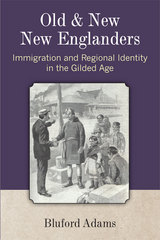 Old and New New Englanders: Immigration and Regional Identity in the Gilded Age
Bluford Adams
University of Michigan Press, 2014 In Old and New New Englanders, Bluford Adams provides a reenvisioning of New England’s history and regional identity by exploring the ways the arrival of waves of immigrants from Europe and Canada transformed what it meant to be a New Englander during the Gilded Age. Adams’s intervention challenges a number of long-standing conceptions of New England, offering a detailed and complex portrayal of the relations between New England’s Yankees and immigrants that goes beyond nativism and assimilation. In focusing on immigration in this period, Adams provides a fresh view on New England’s regional identity, moving forward from Pilgrims, Puritans, and their descendants and emphasizing the role immigrants played in shaping the region’s various meanings. Furthermore, many researchers have overlooked the newcomers’ relationship to the regional identities they found here. Adams argues immigrants took their ties to New England seriously. Although they often disagreed about the nature of those ties, many immigrant leaders believed identification with New England would benefit their peoples in their struggles both in the United States and back in their ancestral lands. Drawing on and contributing to work in immigration history, as well as American, gender, ethnic, and New England studies, this book is broadly concerned with the history of identity construction in the United States while its primary focus is the relationship between regional categories of identity and those based on race and ethnicity. With its interdisciplinary methodology, original research, and diverse chapter topics, the book targets both specialist and nonspecialist readers.
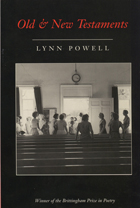 Old And New Testaments
Lynn Powell
University of Wisconsin Press, 1995 The Brittingham Prize in Poetry
Winner of the 1996 Great Lakes Colleges Association New Writers Award
Winner of the 1995 Norma Farber First Book Award
"A radiance and clarity suffuses Lynn Powell's work."
--Carolyn Kizer, Brittingham Prize Citation
--------------------------------------------------------------------------------
"In Lynn Powell's poems we rediscover the meaning of the word 'testament,' for they give us a full testimony of a life, a family, a world. Whether writing of grief, or The Rapture, of a junebug or Aunt Roxy at the age of one hundred, she brings us intense, crafted narratives of selfÂknowledge, of facts so vivid they are painful, becoming signs and also wonders of life. These are poems of the recovery of spiritual desire. This is an extraordinary book, and an extraordinary new talent."--Robert Morgan
"These direct, loving, sober poems are the change we need from most recent verse. The intensity of the opening poems in Old & New Testaments builds throughout the book until, almost intolerable, it transforms into profound acceptance, the quietness that comes of acknowledging both life and death. These images and rhythms need no persuasiveness beyond themselves, brightening our spirits with the clarity of reality."--A. R. Ammons
"Lynn Powell's Old & New Testaments is a reclaiming of spiritual texts and traditions for a woman's life in the body--a life of childhood physicality, female sexuality, procreation, and nurturing love. Playful, tender, and wise, Powell brings her gospel learning down to earth. We can hail her poems in an old phrase with a new meaning: they are full of grace."--Alicia Ostriker
Lynn Powell was raised in East Tennessee and educated at Carson-Newman College and Cornell University. She has worked extensively as a writer in the schools for the Tennessee Arts Commission, the New Jersey State Council for the Arts, the Geraldine R. Dodge Foundation, and currently, the Ohio Arts Council. Her poems have appeared in The Paris Review, Poetry, The Gettysburg Review, and other journals. She lives in Oberlin, Ohio.
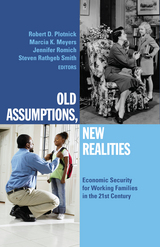 Old Assumptions, New Realities: Ensuring Economic Security for Working Families in the 21st Century
Robert D. Plotnick
Russell Sage Foundation, 2011 The way Americans live and work has changed significantly since the creation of the Social Security Administration in 1935, but U.S. social welfare policy has failed to keep up with these changes. The model of the male breadwinner-led nuclear family has given way to diverse and often complex family structures, more women in the workplace, and nontraditional job arrangements. Old Assumptions, New Realities identifies the tensions between twentieth-century social policy and twenty-first-century realities for working Americans and offers promising new reforms for ensuring social and economic security. Old Assumptions, New Realities focuses on policy solutions for today's workers—particularly low-skilled workers and low-income families. Contributor Jacob Hacker makes strong and timely arguments for universal health insurance and universal 401(k) retirement accounts. Michael Stoll argues that job training and workforce development programs can mitigate the effects of declining wages caused by deindustrialization, technological changes, racial discrimination, and other forms of job displacement. Michael Sherraden maintains that wealth-building accounts for children—similar to state college savings plans—and universal and progressive savings accounts for workers can be invaluable strategies for all workers, including the poorest. Jody Heymann and Alison Earle underscore the potential for more extensive work-family policies to help the United States remain competitive in a globalized economy. Finally, Jodi Sandfort suggests that the United States can restructure the existing safety net via state-level reforms but only with a host of coordinated efforts, including better information to service providers, budget analyses, new funding sources, and oversight by intermediary service professionals. Old Assumptions, New Realities picks up where current policies leave off by examining what's not working, why, and how the safety net can be redesigned to work better. The book brings much-needed clarity to the process of creating viable policy solutions that benefit all working Americans. A West Coast Poverty Center Volume
The Old Barn Book: A Field Guide to North American Barns & Other Farm Structures
Noble, Allen G
Rutgers University Press, 1996 Barns give character to the countryside. Their structures reflect the ethnic heritage of a region's settlers and the nature of the land itself. With The Old Barn Book, you'll be able to spot the difference between a Dutch barn and a Swedish barn, a barn for cows and a barn for tobacco. You'll find out why some barns have hipped roofs and others gables, why some have doors at the end and others have them on the side, why some are wood and some are stone, why some are round. Whether you are nostalgic for farm life or like to drive out in the country or want to join in the barn preservation movement, you will find this book an indispensable guide.
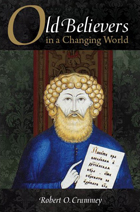 Old Believers in a Changing World
Robert O. Crummey
Northern Illinois University Press, 2011
This important collection of essays by a pioneer in the field focuses on the history and culture of a conservative religious tradition whose adherents have fought to preserve their beliefs and practices from the 17th century through today. Old Belief had its origins in a protest against liturgical reforms in the Russian Orthodox Church in the mid-1600s and quickly grew into a complex torrent of opposition to the Russian state, the official church, and the social hierarchy. For Old Believers, periods of full religious freedom have been very brief—from 1905 to 1917 and since the fall of the Soviet Union.
Crummey examines the ways in which Old Believers defend their core beliefs and practices and adjust their polemical strategies and way of life in response to the changing world. Opening chapters survey the historiography of Old Belief, examine the methodological problems in studying the movement as a Russian example of “popular religion,” and outline the first decades of the history. Particular themes of Old Believer history are the focus of the rest of the book, beginning with two sets of case studies of spirituality, culture, and intellectual life. Subsequent chapters analyze the diverse structures of Old Believer communities and their fate in times of persecution. A final essay examines publications of contemporary scholars in Novosibirsk whose work provides glimpses of the life of traditional believers in the Soviet period.
Old Believers in a Changing World will appeal to scholars and students of Russian history, to those interested in Eastern Orthodoxy, and to those with an interest in the comparative history of religious movements.
 Old Believers in Modern Russia
Roy R. Robson
Northern Illinois University Press, 1995
The schism that split the Russian Orthodox Church in 1667 alienated thousands of devout men and women. These traditional worshipers, who came to be known as the Old Believers, practiced their faith as outsiders for more than two centuries. Denied the Russian Orthodox Church's sacraments, they in turn denied that its "new" ways could lead them to salvation. Always at odds with the established Russian Orthodox Church and the tsar, the Old Believers created a vibrant separate culture within the imperial Russian state.
Old Believers in Modern Russia shows how Russia's most traditional religious group created a "culture of community" distinct from the dominant culture and society. This culture provided a lens through which the faithful could view, interpret, and interact with their world. Focusing especially on imperial Russia's twilight years, Robson explores how the Old Believers adapted to rapid change in the early twentieth century.
Until recently, little has been known about Old Believer faith and culture. Most previous studies have relied upon information provided by outsiders, usually the state or the Russian Orthodox Church. Robson explores Old Believer experience from the inside in this first detailed study of the group in the late imperial period. He integrates historical methods with communication theory and symbolic anthropology to reveal the many facets of Old Believer life.
The Old Beloved Path: Daily Life amond the Indians of the Chattahooche River Valley
William W. Winn
University of Alabama Press, 2008 The Old Beloved Path examines the lifestyles of the native American peoples of the Chattahoochee region of southeast Alabama and southwest Georgia. Organized chronologically, the book describes the region’s cultures in the Early, Middle, and Late Prehistoric periods. Fascinating essays illuminate origin myths, clan structures, townships (or tulwa), spirituality, diseases and medicine, social customs, and sports and games. The Old Beloved Path also describes foodways—native plants gathered and cultivated for food and game animals. Also included is a rich discussion of material culture and natural materials native Americans collected for food, clothing, shelter, and tools.
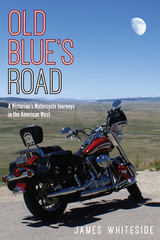 Old Blue's Road: A Historian's Motorcycle Journeys in the American West
James Whiteside
University Press of Colorado, 2014 In Old Blue’s Road, historian James Whiteside shares accounts of his motorcycle adventures across the American West. He details the places he has seen, the people he has met, and the personal musings those encounters prompted on his unique journeys of discovery. In 2005, Whiteside bought a Harley Davidson Heritage Softail, christened it “Old Blue,” and set off on a series of far-reaching motorcycle adventures. Over six years he traveled more than 15,000 miles. Part travelogue and part historical tour, this book takes the reader along for the ride. Whiteside’s travels to the Pacific Northwest, Yellowstone, Dodge City, Santa Fe, Wounded Knee, and many other locales prompt consideration of myriad topics—the ongoing struggle between Indian and mainstream American culture, the meaning of community, the sustainability of the West's hydraulic society, the creation of the national parks system, the Mormon experience in Utah, the internment of Japanese Americans during World War II, and more. Delightfully funny and insightful, Old Blue’s Road links the colorful history and vibrant present from Whiteside’s unique vantage point, recognizing and reflecting on the processes of change that made the West what it is today. The book will interest the general reader and western historian alike, leading to new appreciation for the complex ways in which the American West's past and present come together.
 Old Brick: Charles Chauncy of Boston, 1705-1787
Edward M. Griffin
University of Minnesota Press, 1980 Old Brick was first published in 1980. Minnesota Archive Editions uses digital technology to make long-unavailable books once again accessible, and are published unaltered from the original University of Minnesota Press editions. Charles Chauncy was a powerful and influential figure in his own time, but in historical accounts he has always been overshadowed by his contemporaries Benjamin Franklin and Jonathan Edwards. When he is remembered today, it is usually as Edwards's chief antagonist during the Great Awakening of the 1740s. Yet Chauncy's fellow New Englanders knew that there was more to the man than that. In the course of his 60-year tenure as a pastor of Boston's First Church (the "Old Brick"), Chauncy involved himself in most of the important intellectual, religious, and political issues of the century. Not only did he aggressively oppose the emotional revivalism of the Great Awakening, but he was also a bold pamphleteer and preacher in support of the American Revolution. In theology Chauncy became, as an old man, the leading advocate probably having scandalized his own forebears, but he insisted that he was true to his Protestant tradition and never abandoned his reliance on Scripture and Puritan discipline in favor of rationalist secularism. Old Brick,the first full-scale biography of Charles Chauncy, attempts to recover not only Chauncy the spokesman for the ideas of a great many colonial Americans, but also the complex man who struggled with himself and with the events of his time to arrive at those positions. The portrait of Chauncy that emerges is fuller, more comprehensive, and more balanced than the stereotypes and partial portraits that have thus far represented him in history. This biography now makes it possible to consider Chauncy a figure worthy of study in his own right and to take a fresh look at eighteenth-century New England in light of the tradition Chauncy represents.
Old Burial Grounds of New Jersey: A Guide
Janice Kohl Sarapin
Rutgers University Press, 1994 This illustrated guidebook to New Jersey's old burial grounds is unique, not just for New Jersey, but for anywhere in America. Janice Kohl Sarapin introduces you to the history and lore of old graveyards. She shows you how to read epitaphs, how to date gravestones by style, how to restore an abandoned graveyard, and how to find out the stories of the people buried there. She describes more than 120 fascinating old burial grounds throughout the state (including the cemeteries of African-Americans, Jewish communities, and other ethnic and religious groups). She provides full directions and details about what makes each one special as well as suggestions for planning your visit and for educational activities to use with children and adults.
Old Calabria
Norman Douglas
Northwestern University Press, 1996 First published in 1915, Old Calabria is a comprehensive and exciting account of adventure travel. Captivated by the pagan quality of the mezzogiorno, Norman Douglas plunged into Calabria, the southernmost and most backward part of Italy (a province that was still largely devoid of any form of modern amenity). He endured extremes of climate, scaled mountains, rode in carriages driven by villainous coachmen, and traversed remote stretches of country where murderous groups of banditti were known to roam. As Jon Manchip White points out in his introduction, it "makes good reading, but it must have constituted a protracted and frightening ordeal--frightening, that is, to anyone except someone like Douglas, possessed of a more than normal share of guts and fortitude."
Old Capitol: Portrait of an Iowa Landmark
Margaret N. Keyes
University of Iowa Press, 1988 Built between 1839 and 1842, the domed structure of Iowa City's Old Capitol served as the third territorial capitol and the first state capitol of Iowa. In 1857, when the state government was moved to Des Moines, Old Capitol became the first building of the new University of Iowa. It remains today the centerpiece of this handsome campus. The story of its history and restoration, told in this elegantly illustrated book, is an intriguing account of historical architectural detection. Using primary sources, including manuscripts, vouchers, account books, newspaper stories, correspondence, and documents from the National Archives and Iowa repositories, Margaret Keyes portrays the major events of the total history of Old Capitol since its site was determined.
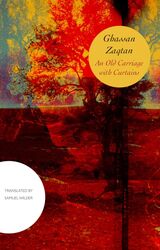 An Old Carriage with Curtains
Ghassan Zaqtan
Seagull Books, 2023 The concluding novel in a trilogy that has become a landmark of Palestinian fiction.
An Old Carriage with Curtains is the third and final book in a masterful trilogy of novels encompassing the history of the people of the Palestinian village of Zakariyya. The novels trace the wandering trajectories and inner lives of characters connected to this village across decades, as well as the vicissitudes of historical change and displacement in the land. Through the return of a middle-aged man to the site of an ancient monastery in the hills near Jericho that he once visited as a boy, the incredibly vivid and surprising stories of Hind, a stage actress and brilliant storyteller, the stories of tortuous routes of checkpoints and bureaucratic blockages, and decades of Occupation, Zaqtan creates a narrative of personal reckoning and reflection.
The vectors of memory and historical reflection interweave in this dreamlike narrative, which delivers a singularly powerful depiction of subjective and collective experience in the face of devastating and sweeping historical change.
Old China Through the Eyes of a Storyteller
Julie Moss Herrera
Parkhurst Brothers, Inc., 2012 An American storyteller’s immersion In the Chinese folktale tradition “Having traveled on the same People to People Ambassador journey to China with Julie, I have seen Julie's anthology from inception to fruition. It is a masterful, engaging, informative and scholarly addition to our understanding and appreciation of Chinese culture, particularly storytelling and folk traditions, from ancient days to today. Practicing storytellers will especially appreciate her tips for telling and context clues at the end of each story.”
--Judith Heineman, storyteller, producer and Illinois Humanities Road Scholar
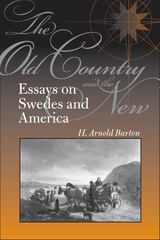 The Old Country and the New: Essays on Swedes and America
H. Arnold Barton
Southern Illinois University Press, 2006 Documenting a rich Scandinavian American culture and ethnic perspective This notable collection of seventeen essays and six editorials by renowned Swedish American historian H. Arnold Barton was compiled from writings published between 1974 and 2005. The result of three decades of extensive research in the United States and Sweden, The Old Country and the New: Essays on Swedes and America, covers Swedish emigration to North America as well as the history and culture of Swedes in their new country. In this rich mosaic of American ethnicity and cultural history, Barton analyzes the multifaceted Swedish emigration/immigration story. Essays include a survey of the historiography of emigration from the Scandinavian countries and the Scandinavian immigration to North America, Swedish emigration before 1846, and the Eric-Janssonist religious sect and its colony at Bishop Hill, Illinois. Because Swedish immigrants were highly literate people, they wrote numerous letters describing their experiences to relatives and friends at home. What these letters related—or omitted—is the subject of another essay. Barton discusses Swedish immigrants who returned permanently to their homeland, affecting both the old country and the new. He also traces relations between the United States and Sweden, post—World War II Swedish immigration, and genealogy as history. Offering a broad Scandinavian American ethnic perspective, The Old Country and the New appeals to both scholars and lay readers. Sixteen illustrations and a complete bibliography of Barton’s publications on Swedish American history and culture enhance the volume.
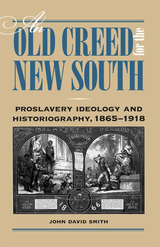 An Old Creed for the New South: Proslavery Ideology and Historiography, 1865-1918
John David Smith, With a New Preface by the Author
Southern Illinois University Press, 1985 An Old Creed for the New South:Proslavery Ideology and Historiography, 1865–1918 details the slavery debate from the Civil War through World War I. Award-winning historian John David Smith argues that African American slavery remained a salient metaphor for how Americans interpreted contemporary race relations decades after the Civil War. Smith draws extensively on postwar articles, books, diaries, manuscripts, newspapers, and speeches to counter the belief that debates over slavery ended with emancipation. After the Civil War, Americans in both the North and the South continued to debate slavery’s merits as a labor, legal, and educational system and as a mode of racial control. The study details how white Southerners continued to tout slavery as beneficial for both races long after Confederate defeat. During Reconstruction and after Redemption, Southerners continued to refine proslavery ideas while subjecting blacks to new legal, extralegal, and social controls. An Old Creed for the New South links pre– and post–Civil War racial thought, showing historical continuity, and treats the Black Codes and the Jim Crow laws in new ways, connecting these important racial and legal themes to intellectual and social history. Although many blacks and some whites denounced slavery as the source of the contemporary “Negro problem,” most whites, including late nineteenth-century historians, championed a “new” proslavery argument. The study also traces how historian Ulrich B. Phillips and Progressive Era scholars looked at slavery as a golden age of American race relations and shows how a broad range of African Americans, including Booker T. Washington and W. E. B. Du Bois, responded to the proslavery argument. Such ideas, Smith posits, provided a powerful racial creed for the New South. This examination of black slavery in the American public mind—which includes the arguments of former slaves, slaveholders, Freedmen's Bureau agents, novelists, and essayists—demonstrates that proslavery ideology dominated racial thought among white southerners, and most white northerners, in the five decades following the Civil War.
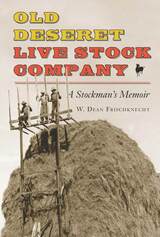 Old Deseret Live Stock Company: A Stockman's Memoir
W. Dean Frischknecht
Utah State University Press, 2008 In the high country of the northern Wasatch Mountains, lies what is left of one of the West’s largest ranches. Deseret Live Stock Company was reputed at various times to be the largest private landholder in Utah and the single biggest producer of wool in the world. The ranch began as a sheep operation, but as it found success, it also ran cattle. Incorporated in the 1890s by a number of northern Utah ranchers who pooled their resources, the company was at the height of successful operations in the mid-twentieth century when a young Dean Frischknecht, bearing a recent degree in animal science, landed the job of sheep foreman. In his memoir he recounts in detail how Deseret managed huge herds of livestock, vast lands, and rich wildlife and recalls through lively anecdotes how stockmen and their families lived and worked in the Wasatch Mountains and Skull Valley’s desert wintering grounds.
 The Old English and Anglo-Latin Riddle Tradition
Andy Orchard
Harvard University Press, 2021 What offers over seven hundred witty enigmas in several languages? Answer: The Old English and Anglo-Latin Riddle Tradition. Riddles, wordplay, and inscrutable utterances have been at the heart of Western literature for many centuries. Often brief and always delightful, medieval riddles provide insights into the extraordinary and the everyday, connecting the learned and the ribald, the lay and the devout, and the familiar and the imported. Many solutions involve domestic life, including “butter churn” and “chickens.” Others like “the harrowing of hell” or “the Pleiades” appeal to an educated elite. Still others, like “the one-eyed seller of garlic,” are too absurd to solve: that is part of the game. Riddles are not simply lighthearted amusement. They invite philosophical questions about language and knowledge.
Most riddles in this volume are translated from Old English and Latin, but it also includes some from Old Norse–Icelandic. The Old English and Anglo-Latin Riddle Tradition assembles, for the first time ever, an astonishing array of riddles composed before 1200 CE that continue to entertain and puzzle.
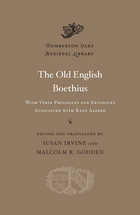 The Old English Boethius: with Verse Prologues and Epilogues Associated with King Alfred
Susan Irvine
Harvard University Press, 2012 The Old English Boethius boldly refashions in Anglo-Saxon guise a great literary monument of the late-antique world, The Consolation of Philosophy. Condemned to death for treason around 525 ce, the Roman scholar Boethius turned to philosophy to transform his personal distress into a powerful meditation on fate, free will, and the human capacity for virtue in a flawed, fallen world. Boethius's Latin dialogues found a receptive audience in Anglo-Saxon England, where they were translated into Old English some time around 900. The translator (traditionally identified with King Alfred) freely adapts the Latin for a new audience: the Roman Fabricius, for example, becomes the Germanic weapon-smith Weland. The translation replicates Boethius’s alternation of prose and verse—only in this case Old English prose alternates with alliterative verse.
In later centuries Chaucer and Queen Elizabeth each turned The Consolation of Philosophy into English, but the Old English translation was the first to bring it to a wider vernacular audience. Verse prologues and epilogues for works traditionally associated with King Alfred fill out the volume, offering readers a fascinating glimpse of the moment when English confidently claimed its birthright as a literature capable of anything, from sublime ideas to subtle poetry.
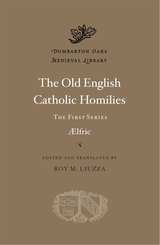 The Old English Catholic Homilies
Aelfric
Harvard University Press, 2024 A contemporary edition and translation of one of the great monuments of Old English literary and religious culture.
The homilies of the monk Ælfric, written in the last decade of the tenth century, offer some of the most important prose writing in Old English. They convey mainstream Christian thought, a distillation of the spiritual inheritance of the English Church before the Norman Conquest and during a time of monastic reform. The homilies cover a broad range of topics, from biblical exegesis to saints’ lives to general Christian history, with a strong focus on the gospel reading at Mass, explained in language that laypeople could understand. Ælfric is famous for his lucid prose, which he later developed into a rhythmical and alliterative style that has often been likened to verse.
In his first series of Catholic Homilies, Ælfric drew on the works of Church Fathers such as Augustine, Gregory, and Bede to create forty sermons for use throughout the church year. This is the first complete translation of the Catholic Homilies since 1844, presented alongside the newly edited Old English text.
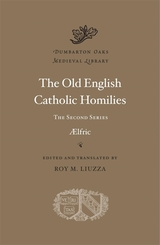 The Old English Catholic Homilies
Aelfric
Harvard University Press, 2026 A contemporary edition and translation of one of the great monuments of Old English literary and religious culture.
The homilies of the monk Ælfric, written in the last decade of the tenth century, offer some of the most important prose writing in Old English. They convey contemporary Christian doctrine shaped during a period of monastic reform. Taken together, the homilies offer a distillation of the spiritual inheritance of the English Church before the Norman Conquest. They cover a broad range of topics, from biblical exegesis to saints’ lives to general Christian history, with a strong focus on the gospel reading at Mass, explained in language that laypeople could understand. Ælfric is famous for his lucid prose, which he later developed into a rhythmical and alliterative style that has often been likened to verse.
In the second series of Catholic Homilies, Ælfric continues his project with an additional forty sermons, sometimes multiple for the same occasion, and relies again on the works of Church Fathers such as Augustine, Gregory, and Bede. This is the first complete translation of the Catholic Homilies since 1844, presented alongside the newly edited Old English text.
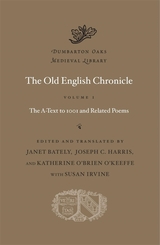 The Old English Chronicle
Janet Bately, Joseph C. Harris, and Katherine O'Brien O'Keeffe
Harvard University Press A thousand years of English history, encapsulating invasions, the rise and fall of kings, and religious events
Among the vernacular historical writings of early medieval England, the Old English Chronicle holds a prominent place, providing not only a backbone of English history from the fifth through the twelfth centuries but also a record of language development and geography. The seven texts in the Chronicle, known as manuscripts A through G, offer a brief year-by-year summary of important national events.
The Old English Chronicle: The A-Text to 1001 is the earliest and most interesting of these manuscripts. It covers more than a thousand years, with entries written throughout the tenth century by different scribes. Although many entries are spare, noting only the death of a king or church official, others offer detailed accounts and interpretations of events such as the movement of viking armies against King Alfred or the narrative of treachery, retribution, and loyalty widely known today as “Cynewulf and Cyneheard.” In addition to the A-Text, this edition contains two highly political poems, The Death of Alfred and The Death of Edward, as well as The Battle of Maldon, a brilliant verse rendering of a defeat against Scandinavian invaders in 991.
The Old English Chronicle, Volume I contains newly edited Old English texts and expert translations of key works of medieval historical writing.
Old English Ecotheology: The Exeter Book
Courtney Barajas
Amsterdam University Press, 2021 Old English Ecotheology examines the impact of environmental crises on early medieval English theology and poetry. Like their modern counterparts, theologians at the turn of the first millennium understood the interconnectedness of the Earth community, and affirmed the independent subjectivity of other-than-humans. The author argues for the existence of a specific Old English ecotheology, and demonstrates the influence of that theology on contemporaneous poetry. Taking the Exeter Book as a microcosm of the poetic corpus, she explores the impact of early medieval apocalypticism and environmental anxiety on Old English wisdom poems, riddles, elegies, and saints' lives.
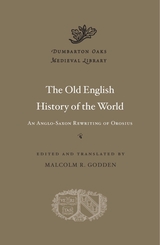 The Old English History of the World: An Anglo-Saxon Rewriting of Orosius
Malcolm R. Godden
Harvard University Press, 2016 The Old English History of the World is a translation and adaptation of the Latin history known as the Seven Books of History against the Pagans, written by the Spanish cleric Paulus Orosius at the prompting of Saint Augustine after the sack of Rome in 410. To counter the pagan and republican narratives of Livy and other classical historians, Orosius created an account of the ancient world from a Christian and imperial viewpoint. His work was immensely popular throughout Europe in succeeding centuries, down to the end of the Middle Ages. Around the year 900, an Old English version was produced by an anonymous writer, possibly encouraged or inspired by King Alfred. The translator actively transformed Orosius’s narrative: cutting extraneous detail, adding explanations and dramatic speeches, and supplying a long section on the geography of the Germanic world. This volume offers a new edition and modern translation of an Anglo-Saxon perspective on the ancient world.
 Old English Legal Writings
Wulfstan
Harvard University Press, 2020 Archbishop Wulfstan of York (d. 1023) was a powerful clergyman and the most influential political thinker of pre-Conquest England. An advocate for the rights and privileges of the Church, he authored the laws of King Aethelred and King Cnut in prose that combined the rhetorical flourishes of a master homilist with the language of law. Some works forged a distinctive style by adding rhythm and alliteration drawn from Old English poetry. In the midst of Viking invasions and cultural upheaval, Wulfstan articulated a complementary relationship between secular and ecclesiastical law that shaped the political world of eleventh-century England. He also pushed the clergy to return to the ideals of their profession. Old English Legal Writings is the first publication to bring together Wulfstan’s works on law, church governance, and political reform. When read together, they reveal the scope and originality of his thought as it lays out the mutual obligations of the church, the state, and the common people. This volume presents new editions of the Old English texts alongside new English translations.
OLD ENGLISH LITERATURE IN ITS MANUSCRIPT CONTEXT
JOYCE T. LIONARONS
West Virginia University Press, 2004 In Old English Literature in its Manuscript Context, editor Joyce Tally Lionarons has developed a multifaceted collection examining the issues facing the textual transmission of Anglo-Saxon writings. Eight established scholars consider the ideas of textual identity, authorship and translation, and editorial standards and obligations. This work also features a scholarly exchange of ideas and photographs of the original Anglo-Saxon manuscripts, making this essential reading for anyone interested in the history of Old English literature. The essays published in this text were originally composed at an NEH summer seminar conducted by Paul Szarmach and Timothy Graham at the Parker Library of Corpus Christi College, Cambridge in 1997.
Old English Lives of Saints
Aelfric
Harvard University Press, 2019 Old English Lives of Saints, a series composed in the 990s by the Benedictine monk Aelfric in his distinctive alliterative prose, portrays an array of saints—including virgin martyrs, married virgins, aristocrats, kings, soldiers, and bishops—for a late Anglo-Saxon audience. At a turbulent time when England was under increasingly severe Viking attack, the examples of these saints modeled courageous faith, self-sacrifice, and individual and collective resistance. The Lives also covers topics as diverse as the four kinds of war, the three orders of society, and whether the unjust can be exempt from eternal punishment. Aelfric intended this series to complement his Catholic Homilies, two important and widely disseminated collections used for preaching to lay people and clergy. The translation is presented alongside a new edition of Lives of Saints, for which all extant manuscripts have been collated afresh.
Old English Lives of Saints
Aelfric
Harvard University Press, 2019 Old English Lives of Saints, a series composed in the 990s by the Benedictine monk Aelfric in his distinctive alliterative prose, portrays an array of saints—including virgin martyrs, married virgins, aristocrats, kings, soldiers, and bishops—for a late Anglo-Saxon audience. At a turbulent time when England was under increasingly severe Viking attack, the examples of these saints modeled courageous faith, self-sacrifice, and individual and collective resistance. The Lives also covers topics as diverse as the four kinds of war, the three orders of society, and whether the unjust can be exempt from eternal punishment. Aelfric intended this series to complement his Catholic Homilies, two important and widely disseminated collections used for preaching to lay people and clergy. The translation is presented alongside a new edition of Lives of Saints, for which all extant manuscripts have been collated afresh.
Old English Lives of Saints
Aelfric
Harvard University Press, 2019 Old English Lives of Saints, a series composed in the 990s by the Benedictine monk Aelfric in his distinctive alliterative prose, portrays an array of saints—including virgin martyrs, married virgins, aristocrats, kings, soldiers, and bishops—for a late Anglo-Saxon audience. At a turbulent time when England was under increasingly severe Viking attack, the examples of these saints modeled courageous faith, self-sacrifice, and individual and collective resistance. The Lives also covers topics as diverse as the four kinds of war, the three orders of society, and whether the unjust can be exempt from eternal punishment. Aelfric intended this series to complement his Catholic Homilies, two important and widely disseminated collections used for preaching to lay people and clergy. The translation is presented alongside a new edition of Lives of Saints, for which all extant manuscripts have been collated afresh.
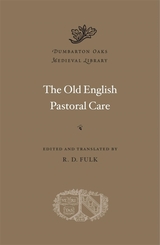 The Old English Pastoral Care
R. D. Fulk
Harvard University Press, 2021 The Book of Pastoral Rule, or Liber regulae pastoralis, by Pope Gregory the Great—the pontiff responsible for the conversion of the English to Christianity beginning in 597—is a guide for aspiring bishops. Pope Gregory explains who ought and who ought not seek such a position and advises on what sort of spiritual guidance a bishop should provide to those under his direction.
The Old English Pastoral Care, a translation of Gregory’s treatise completed between 890 and 896, is described in a prefatory letter by King Alfred the Great as his own work, composed with the assistance of his bishops and chaplains. It appears to be the first of the Alfredian translations into Old English of Latin texts deemed necessary for the revitalization of the English Church, which had been ravaged by the depredations of Scandinavian invaders during the ninth century and by the decline of clerical competence in Latin.
This new edition and translation into modern English is the first to appear in a century and a half.
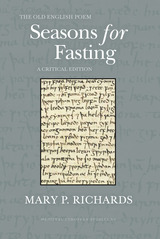 The Old English Poem Seasons for Fasting: A Critical Edition
Mary P. Richards
West Virginia University Press, 2014 Seasons for Fasting, a late Old English poem probably composed in the early eleventh century, focuses on proper fasting observances in England. This poem, composed in eight-line stanzas, survives only in a sixteenth-century transcript made by the antiquary Laurence Nowell. With its topics, vocabulary, sources, and style derived from those of contemporary ecclesiastical prose, it belongs to a school of late tenth/early eleventh century poetry that only now is coming to be recognized and defined. The Old English Poem Seasons for Fasting: A Critical Edition provides a new text and translation of the poem, accompanied by an extensive introduction, commentary, and glossary. The introduction includes analyses of the poem’s manuscript origins, sources, language, meter, style, and structure. The text is collated with all previous editions. The commentary elucidates points of grammar and style, and justifies all editorial decisions. The glossary covers every instance of each word in the poem. Since its discovery among the papers of Laurence Nowell in 1934, the poem has had only four editions, two of the text with basic notes, and two in doctoral theses with more commentary and analysis. This new edition brings the latest resources on manuscript study, lexicon (through the Concordance and Dictionary of Old English A-G), poetics, and cultural milieu to bear on this fascinating poem. The apparatus, including the glossary, will allow fellow scholars to extend these findings through links to their own work.
 Old English Poems of Christ and His Saints
Mary Clayton
Harvard University Press, 2013 Religious piety has rarely been animated as vigorously as in Old English Poems of Christ and His Saints. Ranging from lyrical to dramatic to narrative, the individual poems show great inventiveness in reimagining perennial Christian topics. In different poems, for example, Christ expels Lucifer from heaven, resists the devil's temptation on earth, mounts the cross with zeal to face death, harrows hell at the urging of John the Baptist, appears in disguise to pilot a ship, and presides over the Last Judgment. Satan and the fallen angels lament their plight in a vividly imagined hell and plot against Christ and his saints.
In Andreas the poet relates, in language reminiscent of Beowulf, the tribulations of the apostles Andrew and Matthew in a city of cannibals. In The Vision of the Cross (also known as The Dream of the Rood), the cross speaks as a Germanic warrior intolerably torn between the imperative to protect his Lord and the duty to become his means of execution. In Guthlac A, an Anglo-Saxon warrior abandons his life of violence to do battle as a hermit against demons in the fens of Lincolnshire. As a collection these ten anonymous poems vividly demonstrate the extraordinary hybrid that emerges when traditional Germanic verse adapts itself to Christian themes.
Old English Poems of Christ and His Saints complements the saints' lives found in The Old English Poems of Cynewulf, DOML 23.
 The Old English Poems of Cynewulf
Cynewulf
Harvard University Press, 2013 The Old English poems attributed to Cynewulf, who flourished some time between the eighth and tenth centuries, are unusual because most vernacular poems in this period are anonymous. Other than the name, we have no biographical details of Cynewulf, not even the most basic facts of where or when he lived. Yet the poems themselves attest to a powerfully inventive imagination, deeply learned in Christian doctrine and traditional verse-craft.
Runic letters spelling out the name Cynewulf appear in four poems: Christ II (or The Ascension), Juliana, The Fates of the Apostles, and Elene. To these a fifth can be added, Guthlac B, because of similarities in style and vocabulary, but any signature (if one ever existed) has been lost because its ending lines are missing. What characterizes Cynewulf’s poetry? He reveals an expert control of structure as shown from the changes he makes to his Latin sources. He has a flair for extended similes and dramatic dialogue. In Christ II, for example, the major events in Christ’s life are portrayed as vigorous leaps. In Juliana the force of the saint’s rhetoric utterly confounds a demon sent to torment her.
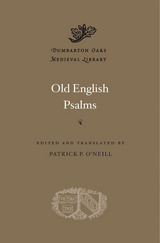 Old English Psalms
Patrick P. O'Neill
Harvard University Press, 2016 The Latin psalms figured prominently in the lives of the Anglo-Saxons, whether sung in the Divine Office by clerics, studied as a textbook for language learning by students, or recited in private devotion by lay people. They were also translated into Old English, first in prose and later in verse. Sometime in the middle of the eleventh century, the prose and verse translations were brought together and organized in a complementary sequence in a manuscript now known as the Paris Psalter. The prose version, traditionally attributed to King Alfred (d. 899), combines literal translation with interpretative clarification. In contrast, the anonymous Old English verse translation composed during the tenth century approaches the psalms in a spirit of prayer and devotion. Despite their differences, both reflect earnest attempts to capture the literal meaning of the psalms.
The complete text of all 150 prose and verse psalms is available here in contemporary English for the first time. With this translation readers encounter the beginnings and the continuation of a long tradition of psalm renderings in English.
 Old English Shorter Poems
Christopher A. Jones
Harvard University Press, 2012 Alongside famous long works such as Beowulf, Old English poetry offers a large number of shorter compositions, many of them on explicitly Christian themes. This volume of the Dumbarton Oaks Medieval Library presents twenty-nine of these shorter religious poems composed in Old and early Middle English between the seventh and twelfth centuries. Among the texts, which demonstrate the remarkable versatility of early English verse, are colorful allegories of the natural world, poems dedicated to Christian prayer and morality, and powerful meditations on death, judgment, heaven, and hell.
Previously edited in many different places and in some instances lacking accessible translations, many of these poems have remained little known outside scholarly circles. The present volume aims to offer this important body of texts to a wider audience by bringing them together in one collection and providing all of them with up-to-date translations and explanatory notes. An introduction sets the poems in their literary-historical contexts, which are further illustrated by two appendices, including the first complete modern English translation of the so-called Old English Benedictine Office.
 Old English Shorter Poems
Robert E. Bjork
Harvard University Press, 2014 The twenty-five poems and eleven metrical charms in this Old English volume offer tantalizing insights into the mental landscape of the Anglo-Saxons. The Wanderer and The Seafarer famously combine philosophical consolation with introspection to achieve a spiritual understanding of life as a journey. The Wife’s Lament, The Husband’s Message, and Wulf and Eadwacer direct a subjective lyrical intensity on the perennial themes of love, separation, and the passion for vengeance. From suffering comes wisdom, and these poems find meaning in the loss of fortune and reputation, exile, and alienation. “Woe is wondrously clinging; clouds glide,” reads a stoic, matter-of-fact observation in Maxims II on nature’s indifference to human suffering. Another form of wisdom emerges in the form of folk remedies, such as charms to treat stabbing pain, cysts, childbirth, and nightmares of witch-riding caused by a dwarf. The enigmatic dialogues of Solomon and Saturn combine scholarly erudition and proverbial wisdom. Learning of all kinds is celebrated, including the meaning of individual runes in The Rune Poem and the catalog of legendary heroes in Widsith.
This book is a welcome complement to the previously published DOML volume Old English Shorter Poems, Volume I: Religious and Didactic.
Old English Tradition: Essays in Honor of J. R. Hall
Edited by Lindy Brady
Arizona Center for Medieval and Renaissance Studies, 2021 Old English Tradition contains eighteen new essays by leading scholars in the field of Old English literary studies. The collection is centered around five key areas of research—Old English poetics, Anglo-Saxon Christianity, Beowulf, codicology, and early Anglo-Saxon studies—on which the work of scholar J. R. Hall, the volume’s honorand, has been influential over the course of his career. The volume’s contents range from fresh insights on individual Old English poems such as The Wife’s Lament and Beowulf; new studies in Old English metrics and linguistics; codicological examinations of individual manuscripts; fresh editions of understudied texts; and innovative examinations of the role of early antiquarians in shaping the field of Old English literary studies as we know it today.
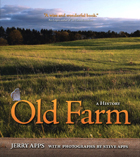 Old Farm: A History
Jerry Apps
Wisconsin Historical Society Press, 2013 One of the Midwest's best-loved authors tells the story of his land, from the last great glacier that dug out its valleys and formed its hills, to his own family's 40 year relationship with the beloved farm they call Roshara. In this quiet but epic tale, Apps describes the Native Americans who lived on the land for hundreds of years, tapping the maple trees and fishing the streams and lakes, as well as the first white settlers who tilled its sandy acres, plowing the native grasses that grew taller than their teams of oxen. For all their work, the farm proved tough to tame. Hardscrabble farming methods and hard luck often brought failure. "From land that provided only a marginal living for its early owners, this place we call Roshara has provided much for my family and me," writes Apps. He and his wife and their children have cared for the farm not so much to make a living as to enhance their lives. Apps chronicles the family's efforts — always earnest, if sometimes ill-advised — to restore an old granary into living space, develop a productive vegetable garden, manage the woodlots, reestablish a prairie, and enjoy nature's sounds and silences. Breathtakingly beautiful color photographs by Apps's son, Steve (a professional photographer), highlight the ever-changing beauty of the land in every season and hint at the spiritual gifts that are the true bounty this family reaps from Roshara. Central to Apps' work is his belief that the land is something to cherish and revere. Like Aldo Leopold before him, Apps sounds an inspirational call to readers to preserve wild and rural places, leaving them in better condition than we found them for future generations.
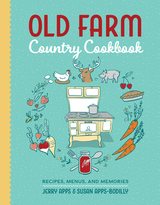 Old Farm Country Cookbook: Recipes, Menus, and Memories
Jerry Apps
Wisconsin Historical Society Press, 2017 When Jerry Apps was growing up on a Wisconsin farm in the 1930s and 1940s, times were tough. Yet most folks living on farms had plenty to eat. Preparing food from scratch was just the way things were done, and people knew what was in their food and where it came from. Delicious meals were at the center of every family and social affair, whether it be a threshing-day dinner with all the neighbors, the end-of-school-year picnic, or just a hearty supper after chores were done. As Jerry writes, "For me food will always be associated with times of good eating, storytelling, laughter, and good-hearted fun."
Inspired by the dishes made by his mother, Eleanor, and featuring recipes found in her well-worn recipe box, Jerry and his daughter, Susan, take us on a culinary tour of life on the farm during the Depression and World War II. Seasoned with personal stories, menus, and family photos, Old Farm Country Cookbook recalls a time when electricity had not yet found its way to the farm, when making sauerkraut was a family endeavor, and when homemade ice cream tasted better than anything you could buy at the store.
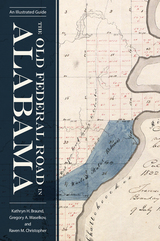 The Old Federal Road in Alabama: An Illustrated Guide
Kathryn H. Braund, Gregory A. Waselkov, and Raven M. Christopher
University of Alabama Press, 2019 A concise illustrated guidebook for those wishing to explore and know more about the storied gateway that made possible Alabama's development
Forged through the territory of the Creek Nation by the United States federal government, the Federal Road was developed as a communication artery linking the east coast of the United States with Louisiana. Its creation amplified already tense relationships between the government, settlers, and the Creek Nation, culminating in the devastating Creek War of 1813–1814, and thereafter it became the primary avenue of immigration for thousands of Alabama settlers.
Central to understanding Alabama’s territorial and early statehood years, the Federal Road was both a physical and symbolic thoroughfare that cut a swath of shattering change through the land and cultures it traversed. The road revolutionized Alabama’s expansion, altering the course of its development by playing a significant role in sparking a cataclysmic war, facilitating unprecedented American immigration, and enabling an associated radical transformation of the land itself.
The first half of The Old Federal Road in Alabama: An Illustrated Guide offers a narrative history that includes brief accounts of the construction of the road, the experiences of historic travelers, and descriptions of major changes to the road over time. The authors vividly reconstruct the course of the road in detail and make use of a wealth of well-chosen illustrations. Along the way they give attention to the very terrain it traversed, bringing to life what traveling the road must have been like and illuminating its story in a way few others have ever attempted.
The second half of the volume is divided into three parts—Eastern, Central, and Southern—and serves as a modern traveler’s guide to the Federal Road. This section includes driving tours and maps, highlighting historical sites and surviving portions of the old road and how to visit them.
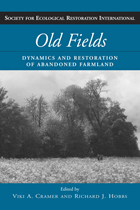 Old Fields: Dynamics and Restoration of Abandoned Farmland
Edited by Viki A. Cramer and Richard J. Hobbs
Island Press, 2007 Old Fields explores one of the most underexamined yet ecologically significant phenomena in landscape change: land abandonment. As farming and land use practices shift around the globe, vast areas are being left to regenerate on their own. This book offers a rare and timely synthesis of what happens next—ecologically, socially, and practically.
Bringing together a global team of experts, Old Fields provides a comprehensive look at how abandoned lands recover, what factors shape that recovery, and how these insights inform broader ecological theory and the applied practice of restoration. Readers will gain a deeper understanding of why agricultural lands are abandoned, how different ecosystems respond over time, and what old field dynamics reveal about resilience, succession, and biodiversity.
With twelve richly detailed case studies—from the Brazilian Amazon to the New Jersey piedmont to South African shrublands—the book gives a comparative perspective on old field recovery across climate zones, land uses, and ecological contexts. Final chapters tie these examples together to highlight patterns, key variables, and lessons that can guide future restoration efforts.
Ideal for restoration practitioners, researchers, land managers, and policymakers, Old Fields serves as both a scientific reference and a practical guide for navigating the challenges and opportunities of regenerating abandoned landscapes.
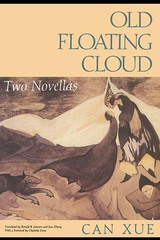 Old Floating Cloud: Two Novellas
Can Xue
Northwestern University Press, 1991 Old Floating Cloud brings together two of Can Xue’s early novellas, Yellow Mud Street and the titular Old Floating Cloud.
Yellow Mud Street tells of a street, its people, and a strange event that happens there. The street is dilapidated, though it once saw better times. The “S” Machinery Factory, which used to run day and night, is rusty and decaying, though people still deceive themselves into thinking this factory is a fine place, the envy of “foreign devils” and an important connection with “the authorities.” One day, “a thing” appears. No one is sure if it is a person, a flash of light, or a cloud of will-o'-the-wisp. It prompts rumor, superstition, political slogans, and an investigation by the authorities. A chorus of paranoid preoccupations wind up and down Yellow Mud Street, in a series of muttered refrains that build to a screaming frenzy.
Old Floating Cloud is the ruthlessly unsentimental story of a man who has an affair with his neighbor's wife. Can Xue describes the damage people do to each other, their obsessions, their lack of connection, and their attempts to exert power over one another. Lovers are not the only targets of Can Xue’s biting humor. Resentment flares between parents and children, in-laws spy, and employees abase themselves before their bosses. Like Yellow Mud Street, this novella teems with insects, excrement, and distorted bodies—visceral reminders of our earthbound state.
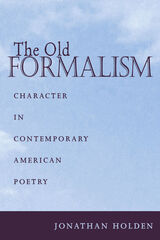 The Old Formalism: Character and Contemporary American Poetry
Jonathan Holden
University of Arkansas Press, 1999 Our appreciation of American poetry is as influenced by the personas presented in the poems as by public perception of the poets themselves. Emily Dickinson peeking from behind a doorway with large dark eyes is an indelible image superimposed over her spare, enigmatic poems. The grand gestures of Walt Whitman's voice have much to do with our reading of "Song of Myself." And we cannot hear "Mending Wall" or "Mowing" without thinking of the image of the rustic, sly farmer-poet that Robert Frost so carefully cultivated. The moral authority of the poet reveals itself through the poems as well, and it is crucial to the meaning of the poem, Holden argues, if art is to elevate life. Part 1 of The Old Formalism,"The Practice," is a close study of some of the conventions and developments in contemporary American poetry, with such topics as "sex and poetry" "rhetoricity," and "sensibility." Holden shows lucidly how character—or lack of it—is revealed in poetry. In "Personae," the second part, he gives a studied reading of a group of several admired poets, such as Richard Hugo, Mary Kinzie, Ted Kooser, and William Stafford. Holden uses biographical references and personal contacts with the poets to strengthen the notion of character revealed in poetry. This book takes a decided stand in the ongoing debate of the past two decades about the relationship of American poetry to American culture. In an age when image dominates word, and the business of poetry is nearly as celebrity-laden as Hollywood, Holden takes us past the media glitz, backstage where the poems are waiting to be read. Quite simply, in a clear, incisive manner, he teaches us how to read well again.
 The Old French Lives of Saint Agnes and Other Vernacular Versions of the Middle Ages
Alexander Joseph Denomy
Harvard University Press This volume presents an edition of a hitherto unpublished Old French Life of Saint Agnes, ms. B.N. Fr. 1553, accompanied by a study of the language and dialect of the poem. It presents a mixture of Picard and Francian forms, and linguistic evidence points to the middle of the thirteenth century as the time of composition. The Introduction reviews the scholarship dealing with the origin and growth of the St. Agnes legend. Appendices present for the first time four other versions of the legend: another Old French version preserved in the Bibliotheque Inguimbertine, ms. 106; an Anglo-French version by Nicole Bozon, preserved in ms. Cotton, Domitian XI, of the British Museum; an Irish version, ms. 23L29 of the Royal Irish Academy; and two Old French prose versions. A further section of the book studies some eleven versions of the legend in the vernacular languages of mediaeval Western Europe. Philologists, hagiologists, and students of mediaeval literature will find this a work of unusual importance.
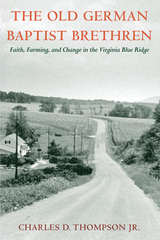 The Old German Baptist Brethren: Faith, Farming, and Change in the Virginia Blue Ridge
Charles D. Thompson Jr.
University of Illinois Press, 2006 Since arriving nearly 250 years ago in Franklin County, Virginia, German Baptists have maintained their faith and farms by relying on their tightly knit community for spiritual and economic support. Today, with their land and livelihoods threatened by the encroachment of neighboring communities, the construction of a new highway, and competition from corporate megafarms, the German Baptists find themselves forced to adjust.
Charles D. Thompson Jr.'s The Old German Baptist Brethren combines oral history with ethnography and archival research--as well as his own family ties to the Franklin County community--to tell the story of the Brethren's faith on the cusp of impending change. The book traces the transformation of their operations from frontier subsistence farms to cash-based enterprises, connecting this with the wider confluence of agriculture and faith in colonial America. Using extensive interviews, Thompson looks behind the scenes at how individuals interpret their own futures in farming, their hope for their faith, and how the failure of religiously motivated agriculture figures in the larger story of the American farmer.
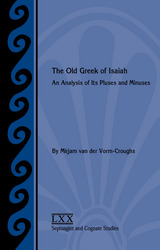 The Old Greek of Isaiah: An Analysis of Its Pluses and Minuses
Mirjam van der Vorm-Croughs
SBL Press, 2014 A concise study of a large number of examples of pluses and minus providing insight into translation from Hebrew to Greek
Van der Vorm-Croughs focuses this translation study on the processes leading to pluses and minuses including linguistic and stylistic aspects (i.e., cases in which elements have been added or omitted for the sake of a proper use of the Greek language), literary aspects (additions and omissions meant to embellish the Greek text), translation technical aspects (e.g., the avoidance of redundancy), and contextual and intertextual exegesis and harmonization. This work also covers the relation between the Greek Isaiah and its possible Hebrew Vorlage to try to determine which pluses and minuses may have been the result of the translator’s use of a different Hebrew text.
Features:
- Eleven categories for the pluses and minuses of the Greek Isaiah
- Examination of translation techniques and translator errors
- Use of Joseph Ziegler’s critical edition
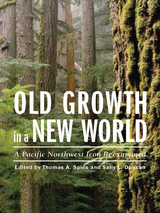 Old Growth in a New World: A Pacific Northwest Icon Reexamined
Edited by Thomas A. Spies and Sally L. Duncan
Island Press, 2008 Old-growth forests represent a lofty ideal as much as an ecosystem—an icon of unspoiled nature, ecological stability, and pristine habitat. These iconic notions have actively altered the way society relates to old-growth forests, catalyzing major changes in policy and management. But how appropriate are those changes and how well do they really serve in reaching conservation goals? Old Growth in a New World untangles the complexities of the old growth concept and the parallel complexity of old-growth policy and management. It brings together more than two dozen contributors—ecologists, economists, sociologists, managers, historians, silviculturists, environmentalists, timber producers, and philosophers—to offer a broad suite of perspectives on changes that have occurred in the valuing and management of old-growth forests in the Pacific Northwest over the past thirty years. The book • introduces the issues and history of old-growth values and conservation in the Pacific Northwest;
• explores old growth through the ideas of leading ecologists and social scientists;
• addresses the implications for the future management of old-growth forests and considers how evolving science and social knowledge might be used to increase conservation effectiveness. By confronting the complexity of the old-growth concept and associated policy and management challenges, Old Growth in a New World encourages productive discussion on the future of old growth in the Pacific Northwest and offers options for more effective approaches to conserving forest biodiversity.
 The Old Guard and the Avant-Garde: Modernism in Chicago, 1910-1940
Edited by Sue Ann Prince
University of Chicago Press, 1990 "The Old Guard and the Avant-Garde: Modernism in Chicago, 1910-1940 brings together the history and the critical reaction to the new developments in art and design, places them in the context of conservative yet innovative Chicago at the turn of the century, and explores the tensions between tradition and innovation. The individual essays present the best in specialized current research, yet one can clearly understand the impact of modernism on the broader intellectual and cultural life of the city. I eagerly await as cohesive and thorough an analysis of the subject for New York."—David Sokol, University of Chicago
"This is fresh and fascinating research about the ups and downs of modernism in Chicago, a city where art students reportedly once hung Matisse in effigy. Regional studies like this one broaden our understanding of how the art world has worked outside of New York and gives depth to a story we know too narrowly. Applause all the way around."—Wanda M. Corn, Stanford University
 Old Hatreds and Young Hopes: The French Carbonari against the Bourbon Restoration
Alan B. Spitzer
Harvard University Press, 1971 After the defeat and exile of Napoleon and the restoration of the Bourbons, the political climate of France was one of seething unrest, intrigue, and dissent. A clandestine and conspiratorial movement known as the Carbonari, or Charbonnerie, arose in the early 1820's with the aim of overthrowing the monarchy of Louis XVIII. Modeling itself after the Italian Carbonari, this coalition of young French republicans--bonapartists, retired army officers, junior and non-commissioned officers, and leaders of the extreme liberal wing of the Chamber of Deputies--set up cells throughout France, hoping in particular to infiltrate vulnerable army units. Old Hatreds and Young Hopes follows the movement from its beginnings to its ultimate failure, from plots to trials.
Sources of information about secret societies and political conspiracies are always scattered and complex, and often unreliable. Spitzer demonstrates that the secrets of a conspiracy and its place in the broader history of a nation can nevertheless be brought to light by evaluating one kind of evidence against another, by checking and testing government sources, particularly police documents, against such other materials as the memoirs and letters of conspirators and contemporary journalistic accounts. His book is much more than the story of the conspirators. In showing why the conspiracy developed and how it was handled, the author has illuminated the workings of the politicalsystem of the Restoration--the structure and organization of its administration and political police and the operation of political justice in its courts. He also situates the French Carbonari in the history of secret societies and radical movements in the first half of the nineteenth century and works out links with similar groups in other countries.
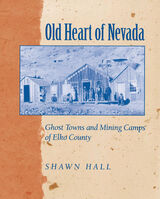 Old Heart Of Nevada: Ghost Towns And Mining Camps Of Elko County
Shawn Hall
University of Nevada Press, 1998 Elko County, in the old heart of Nevada, is rich in historic sites, many of them hitherto uncharted and some verging on disappearing. For the first time, historian Shawn Hall identifies and locates the ghost towns and old mining camps of Elko County and recounts their colorful histories. Following a guidebook format, Hall divides the county into five easily accessible regions, then lists the historic sites within each region and provides directions to reach them. He offers a brief history of each site as well as a description of its extant structures and their present condition. The result is a lively compilation of local history and mining and ranching lore that records the dramatic past of Nevada’s northeast corner, its pioneers and prospectors, its towns and mines, its outlaws, ranchers, merchants, mining concerns, and civic leaders. The book offers never-before available information about the old heart of Nevada and the people who settled there. It will be of enduring value to tourists and weekend explorers, historic preservationists, and all those interested in the history and artifacts of this region.
The Old Land and the New: The Journals of Two Swiss Families in America in the 1820s
Robert H. Billigmeier and Fred Altschuler Picard, EditorsTranslated by Robert H. Billigmeier and Fred Altschuler PicardIllustrations by Hans Erni
University of Minnesota Press, 1965
The Old Land and the New was first published in 1965. Minnesota Archive Editions uses digital technology to make long-unavailable books once again accessible, and are published unaltered from the original University of Minnesota Press editions.
These are the journals in English translation of two early Swiss immigrants to America who provided an intriguing picture of life as they saw it in New York, Maryland, Pennsylvania, and Ohio. The book is illustrated with sketches by the Swiss artist, Hans Erni.
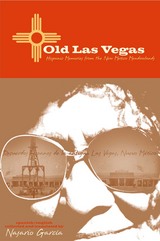 Old Las Vegas: Hispanic Memories from the New Mexico Meadowlands
Nasario García
Texas Tech University Press, 2005 2005 Southwest Book Award“The stories are charmingly frank, unexpectedly humorous, sometimes sad, all reminiscent of a simpler, though not always uncomplicated time. . . . The book brims with anecdotes, folklore, and oral history that help define one of New Mexico’s most fascinating pockets of enchantment.” —Albuquerque Journal.“Garcia presents stories on life in the countryside, education, folk healing, witchcraft, superstitions, religion, politics, folk sayings, and riddles. . . . All Hispanic Americans with an interest in their cultural heritage should identify with many of the stories told by the viejitos—the old folks. . . Recommended.” —Choice.“A veritable buffet of reminiscences . . . An outstanding contribution to the folklore and history of Hispanic New Mexico.” —New Mexico Historical Review. “There is a rich and engaging text in two languages, humor and intelligence mixed in just the right proportion; what else could be desired? Photos! Ancianos, penitentes, cowboys: Welcome faces smile out of almost every page at the beginning of the book. . . . In this book many, many stories will live to be enjoyed and appreciated by generations of new readers.” —Southwest BookViews.Nasario García, a native New Mexican and leading folklorist in his state, has produced many works on New Mexican literature and folklore, including Pláticas: Conversations with Hispano Writers of New Mexico (Texas Tech 2000).
The Old Man
Yuri Trifonov
Northwestern University Press, 1999 The Old Man veers between a contemporary effort to buy a dacha and the memories of an incident in the Civil War. A questionable action in the past haunts the present and throws into relief the materialism that has come to replace revolutionary idealism; suggesting this idealism may have been tainted in the first place. While the setting and situation are very Soviet, the quandary Trifonov describes has universal significance.
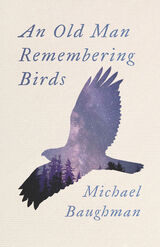 An Old Man Remembering Birds
Michael Baughman
Oregon State University Press, 2021 In a series of short, engaging essays, Michael Baughman reflects on his lifelong fascination with birds—on his deck in southern Oregon, at the end of a shotgun, on the beaches of Hawaii and Baja California.
Birders are dedicated and passionate, and, like anglers, they all have their stories. But Baughman tells more than simple accounts of birds spotted in the field. He reflects on human-animal relations, why humans seek closeness with nature, how a dedicated birder can also be a dedicated hunter. He explores how environmental change has altered the rhythms of bird life: the ospreys that resurged after DDT was banned, the waxwings and juncos that appear rarely now as climate change takes a toll on bird populations. Baughman also describes encounters with wildfires and smoke and discusses how they shape the landscape and wildlife of contemporary Oregon.
In his eighty-plus years around birds, Michael Baughman has learned one immutable lesson: as long as you remain alive and human, the closer you get to birds, and the more time you spend among them, the more you love them.
Old Masters: A Comedy
Thomas Bernhard
University of Chicago Press, 1992 In this exuberantly satirical novel, the tutor Atzbacher has been summoned by his friend Reger to meet him in a Viennese museum. While Reger gazes at a Tintoretto portrait, Atzbacher—who fears Reger's plans to kill himself—gives us a portrait of the musicologist: his wisdom, his devotion to his wife, and his love-hate relationship with
art. With characteristically acerbic wit, Bernhard exposes the pretensions and aspirations of humanity in a novel at once pessimistic and strangely exhilarating.
"Bernhard's . . . most enjoyable novel."—Robert Craft, New York Review of Books.
"Bernhard is one of the masters of contemporary European fiction."—George Steiner
The Old Mine Road
Hine, C. G.
Rutgers University Press, 1963 The Old Mine Road, considered the first road in America designed for wheeled vehicles, was built three hundred years ago by Dutch settlers for access to the mines of the Minisink country. It began in Kingston, New York, wove through Sussex and Warren counties in New Jersey, and ended near the Delaware Water Gap. Many changes have taken place in these regions since C. G. Hine recorded his observations and printed The Old Mine Road for his friends in 1908. Bulldozers have obliterated much of what he saw as he took his readers along the length of the road, describing the natural beauty of the countryside and relating the history and legends linked with the road and the people who lived on its route. This new printing is a facsimile of the first 1908 edition. Henry Charlton Beck's introduction gives a publishing history of the book and provides a biographical sketch about Hine.
Old Mobile Archaeology
Gregory A. Waselkov
University of Alabama Press, 2005 An archaeological guide to the earliest French settlement on the northern Gulf Coast. Archaeological excavations since 1989 have uncovered exciting evidence of the original townsite of Mobile, first capital of the Louisiana colony, and remnants of the colony's port on Dauphin Island.
Old Mobile: Fort Louis de la Louisiane, 1702-1711
Jay Higginbotham
University of Alabama Press, 1991 “Higginbotham has given to American historiography a microcosmic view of one of the earliest and most important outposts in the colonial new world. The Latin South can henceforth not be ignored.” —Alabama Historical Quarterly “The definitive account . . . superbly recounted.” —Journal of Southern History “Meticulously documented. . . . Recommended for libraries interested in the colonial period.” —Choice “Mind-boggling . . . a stupendous job of research. It is amazing that Higginbotham can recreate in such detail the lives of these people. All history books should be written like this.” —BirminghamMagazine
Old Norse Mythology—Comparative Perspectives
Pernille Hermann
Harvard University Press, 2017 Old Norse mythology is elusive: it is the label used to describe the religious stories of the pre-Christian North, featuring such well-known gods as Odin and Thor, yet most of the narratives have come down to us in manuscripts from the Middle Ages mainly written by Christians. Our view of the stories as they were transmitted in oral form in the pre-Christian era is obscured.
To overcome these limitations, this book assembles comparisons from a range of theoretical and analytical perspectives—across media, cultures, and disciplines. Fifteen scholars from a wide range of fields examine the similarities of and differences of the Old Norse mythologies with the myths of other cultures. The differences and similarities within the Old Norse corpus itself are examined to tease out the hidden clues to the original stories.
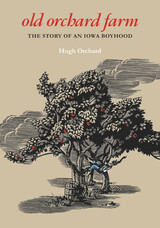 Old Orchard Farm: The Story of an Iowa Boyhood
Hugh Orchard
University of Iowa Press, 2010 “I have often wondered what city boys find to do for fun. All cluttered up with houses and laid out in streets with no horses or mules or dogs . . . it must be pretty dull.” That sums up Hugh Orchard’s philosophy—and makes Old Orchard Farm a delightful reading experience. Return to an Iowa farm of the 1880s, seen through the impressionable eyes of a lively young boy. There in Des Moines County, not far from Burlington, Hugh Orchard grew up when the farm was the center of life in rural America. A broken binder was a major crisis. A violent prairie storm was a terrifying experience. A trip to the county seat town was a thrilling adventure. There were peculiar neighbors, traveling peddlers, an excursion to the mill to grind wheat for bread, hunting expeditions for the prairie chicken and wild geese. Progressive farming in those bygone days meant that Hugh’s father had the first windmill, the first top buggy, and the first barbed wire fence. There was also the pricey purebred cow who refused to allow anyone to milk her. From these homely, everyday events, Orchard crafts engaging tales of long-ago days—when both America and agriculture were simple, innocent, and untroubled by the complexities of modern life.
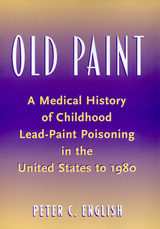 Old Paint: A Medical History of Childhood Lead-Paint Poisoning in the United States to 1980
English, Peter C.
Rutgers University Press, 2001 In the early twentieth century lead had many domestic uses: in solder for cans, as a gasoline additive to prevent “knocking” in engines, in water pipes, and, most prominently, in interior paint prized for its durability and ability to hold color. Far from being the toxic hazard we recognize today, lead was a valuable commodity. However, by the end of the century, lead had largely disappeared from our environment as physicians discovered the threat it posed to children’s health and mental development.
Old Paint documents the history of lead-paint poisoning in the United States and the evolving responses of public health officials and the lead-paint industry to this hazard up to 1980, by which time lead had been banned from gasoline and paint. Peter C. English traces lead poisoning from a rare, but acute problem confined to a small group of children to the discovery by the end of the 1940s of the dangers of the crumbling lead-painted interiors of inner-city dwellings. He draws on a wide range of primary materials not only to illuminate our understanding of how this health hazard changed over time, but also to explore how diseases are constructed and evolve.
Old People, New Lives: Community Creation in a Retirement Residence
Jennie Keith
University of Chicago Press, 1982 "An American anthropologist, Jennie Keith . . . went to live for twelve months in a French housing scheme for retired people and as a participant observer conducted a study in community creation. This book, in which she describes and analyses her experience, is a delight. It is scholarly and draws on a wide range of studies of similar residences and other collectives; it is also vivid, funny, sad and entertaining."—Marie Borland, British Journal of Social Work
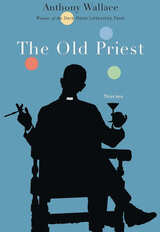 The Old Priest
Anthony Wallace
University of Pittsburgh Press, 2013 The Old Priest is a book of transformations. From the cigar-smoke-and-mirrors world of casino life, to the collection’s title character morphing into a goat-man before the narrator’s eyes, to a family drama upended by a miniature dinosaur in the backyard, Anthony Wallace writes about life-changing events. The characters seek to escape their earthly boundaries through artifice and fantasy, and those boundaries can be as elegant and fragile as a martini glass or as hardscrabble as an Indian reservation. In these eight vividly detailed short stories we encounter cheating husbands, neurotic housewives, out-of-control teenagers, desperate gamblers, deluded alcoholics, and a host of others who would like a chance at something more. Some face the consequences of their actions, while others simply begin to see what they’ve been missing all along. Through wry, ironic prose—and what feels like firsthand experience—Wallace describes a comic and often misguided search for self-knowledge in the most unlikely locations—like the Emerald City, a low-rent gambling den where a cocktail waitress dressed as an X-rated Dorothy offers gamblers more than a Scotch on the rocks; or the Bastille Hotel-Casino, where a dealer dressed as an eighteenth century footman deals five-dollar blackjack to a reminiscing Holocaust survivor. Occasionally a real demon appears, but the collection is mostly about personal demons and the possibility of exorcising them. The stories in The Old Priest have to do with time and memory, and they convincingly open out beyond ordinary daily time to reveal something else—the present moment, perhaps, but a larger, more mysterious conception of it.
Old Province of Quebec
Alfred Leroy Burt
University of Minnesota Press, 1933 Old Province of Quebec was first published in 1933. Minnesota Archive Editions uses digital technology to make long-unavailable books once again accessible, and are published unaltered from the original University of Minnesota Press editions.
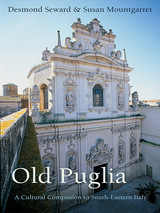 Old Puglia: A Cultural Companion to South-Eastern Italy
Desmond Seward and Susan Mountgarret
Haus Publishing, 2016 Apulia (or Puglia) is the heel of Italy, stretching down from the spur of the Italian boot. Its landscape is often very beautiful and it has wonderful old cities with Romanesque cathedrals, Gothic castles and a great wealth of Baroque architecture, together with 'rupestrian' churches that contain Byzantine frescoes. But, although far from inaccessible, until quite recently it was seldom visited by Anglo Saxons. Today, however, Apulia is becoming fashionable, 'an alternative to Tuscany'. It is featured on radio and television; travel supplements describe its beaches and its cooking, supermarkets stock Apulian wine, oil, bread and pasta. Yet almost nothing about the region has been published in English since the days of Norman Douglas and the Sitwells. One can find 'holiday histories' of Tuscany, but there is no popular introduction to Apulian history, not even in Italian. Our book, which grew out of what was originally intended as a travel book, has been written to fill the gap by providing a simple, readable account.
The Old Regime and the Revolution, Volume I: The Complete Text
Alexis de Tocqueville
University of Chicago Press, 1998 The Old Regime and the Revolution is Alexis de Tocqueville's great meditation on the origins and meanings of the French Revolution. One of the most profound and influential studies of this pivotal event, it remains a relevant and stimulating discussion of the problem of preserving individual and political freedom in the modern world. Alan Kahan's translation provides a faithful, readable rendering of Tocqueville's last masterpiece, and includes notes and variants which reveal Tocqueville's sources and include excerpts from his drafts and revisions. The introduction by France's most eminent scholars of Tocqueville and the French Revolution, Françoise Mélonio and the late François Furet, provides a brilliant analysis of the work.
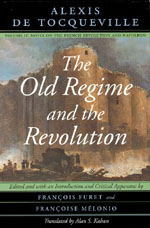 The Old Regime and the Revolution, Volume II: Notes on the French Revolution and Napoleon
Alexis de Tocqueville
University of Chicago Press, 2001 The continuation of Alexis de Tocqueville’s great meditation on the origins and meanings of the French Revolution. With his monumental work The Old Regime and the Revolution, Alexis de Tocqueville (1805–59)—best known for his classic Democracy in America—envisioned a multivolume philosophical study of the origins of modern France that would examine the implications of French history on the nature and development of democratic society. Volume I, which covered the eighteenth-century background to the Revolution, was published to great acclaim in 1856. On the continuation of this project, he wrote: "When this Revolution has finished its work, [this volume] will show what that work really was, and what the new society which has come from that violent labor is, what the Revolution has taken away and what it has preserved from that old regime against which it was directed." Tocqueville died in the midst of this work. Here in Volume II is all that he had completed, including the chapters he started for a work on Napoleon, notes and analyses he made in the course of researching and writing the first volume, and his notes on his preparation for his continuation. More than ever before, readers will be able to glean how Tocqueville's account of the Revolution would have come out, had he lived to finish it. This handsomely produced volume completes the set and is essential reading for anyone interested in the French Revolution or in Tocqueville’s thought.
The Old Regular Baptists of Central Appalachia: Brothers and Sisters in Hope
Howard Dorgan
University of Tennessee Press, 2002 Using the techniques of anthropology, ethnography, and communications, Dorgan brings to life the faith and practices of the Old Regular Baptists. This little-studied group has adherents in the Appalachian heartland of Kentucky, West Virginia, and Virginia.
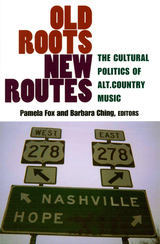 Old Roots, New Routes: The Cultural Politics of Alt.Country Music
Pamela Fox and Barbara Ching, editors
University of Michigan Press, 2008 Old Roots, New Routes takes an in-depth look at the many influences, meanings, and identities of this contemporary music form. Because the definition of the term alt.country changes continually, even the genre's own mouthpiece, the Web site nodepression.com, declared its terrain to be "alternative country (whatever that is)." Despite alt.country's murky parameters, its origins, indeed, its patron saints, are generally acknowledged to range from the Carter Family and Hank Williams---as interpreters of traditional American country---to the country-rock fusions of Gram Parsons and Steve Earle. Just as other musical genres before it have distanced themselves from the popular and commercial center, from the start alt.country has positioned itself as a different kind of music than the slick country sounds emanating from Nashville hit machines such as Garth Brooks and Shania Twain. And yet alt.country's embrace of authenticity and disdain for commercialism---while simultaneously injecting into a traditional, working-class music form an often cosmopolitan flavor and "Generation X" values---has resulted in a fascinating hybrid full of contradictions. In Old Roots, New Routes, Pamela Fox and Barbara Ching bring together a range of scholars to investigate as never before this significant contemporary music form, providing in addition new ways to approach the worlds of country and alternative music more generally. Individual essays explore the work of a variety of artists, including Neko Case, Jay Farrar, Justin Treviño, and alt.country "hero" Gram Parsons, along with promotional rhetoric, album art, advertising, and fan Web sites, to offer readers a comprehensive understanding of how alt.country functions as a distinct musical form. Pamela Fox is Associate Professor of English and currently the Director of the Women's and Gender Studies Program at Georgetown University. She is the author of Class Fictions: Shame and Resistance in the British Working-Class Novel, 1890–1945. Barbara Ching is Associate Professor at the University of Memphis. Her previous books include Wrong's What I Do Best: Hard Country Music and Contemporary Culture and Knowing Your Place: Rural Identity and Cultural Hierarchy, coedited with Gerald Creed.
 The Old South Frontier: Cotton Plantations and the Formation of Arkansas Society, 1819–1861
Donald P. Mcneilly
University of Arkansas Press, 2000 In this deeply researched and well-written study, Donald P. McNeilly examines how moderately wealthy planters and sons of planters immigrated into the virtually empty lands of Arkansas, seeking their fortune and to establish themselves as the leaders of a new planter aristocracy west of the Mississippi River. These men, sometimes alone, sometimes with family, and usually with slaves, sought the best land possible, cleared it, planted their crops, and erected crude houses and other buildings. Life was difficult for these would-be leaders of society and their families, and especially hard for the slaves who toiled to create fields in which they labored to produce a crop. McNeilly argues that by the time of Arkansas's statehood in 1836, planters and large farmers had secured a hold over their frontier home, and that between 1840 and the Civil War, planters solidified their hold on politics, economics, and society in Arkansas. The author takes a topical approach to the subject, with chapters on migration, slavery, non-planter whites, politics, and the secession crisis of 1860–1861. McNeilly offers a first-rate analysis of the creation of a white, cotton-based society in Arkansas, shedding light not only on the southern frontier, but also on the established Old South before the Civil War.
Old South, New South, or Down South?: Florida and the Modern Civil Rights Movement
Edited by Irvin D. S. Winsboro
West Virginia University Press, 2009 How does a state, tarnished with a racist, violent history, emerge from the modern civil rights movement with a reputation for tolerance and progression? Old South, New South, or Down South?: Florida and the Modern Civil Rights Movement exposes the image, illusion, and reality behind Florida’s hidden story of racial discrimination and violence. By exploring multiple perspectives on racially motivated events, such as black agency, political stonewalling, and racist assaults, this collection of nine essays reconceptualizes the civil rights legacy of the Sunshine State. Its dissection of local, isolated acts of rebellion reveals a strategic, political concealment of the once dominant, often overlooked, old south attitude towards race in Florida.
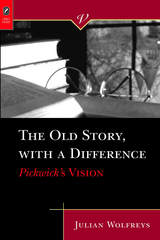 The OLD STORY, WITH A DIFFERENCE: Pickwick’s Vision
Julian Wolfreys
Ohio State University Press, 2006 The Old Story, with a Difference: Pickwick’s Vision explores in radically different ways from most approaches to nineteenth-century studies the tropes and metaphors of vision in Dickens’ first novel, The Pickwick Papers. Julian Wolfreys provides a close reading of Dickens’ Pickwick Papers and argues that this novel is an exemplary text for the re-consideration of concepts such as literature, history, the novel, and the whole notion of Victorian studies. True to the purpose of the Victorian Critical Interventions Series, Wolfreys challenges scholars to rethink the use of a canonical text in Victorian literature. Challenging the commonplaces of historicist criticism, and demonstrating the need for a return to close reading, The Old Story, with a Difference presents a reading of the novel grounded in the twinned rigors of materialist historiography and theoretical inflections tending toward attentiveness to epistemological and linguistic concerns. Through such an orientation, Wolfreys unpacks the relation between the tropes of visuality and matters of memory, history, and the necessity of fiction to bear witness to the cultures, past and present, from which literature becomes generated and which it mediates. In doing so, he situates an argument for rethinking Dickens’ novel as the inaugural novel of Victorian fiction par excellence, in that novel’s efforts to remain open to the traces of the past in particular ways. The Old Story, with a Difference holds profound implications for the study not only of Dickens’ works but Victorian literature and culture in general. Provocative and inventive, this ambitious analysis will challenge, goad, and invite the reader to return to acts of materialist reading informed by ethical and ideological urgency, rather than relapsing into the commonplaces of humanist cliché.
The Old Testament and Christian Spirituality: Theoretical and Practical Essays from a South African P
Christo Lombaard
SBL Press, 2012 An engaging anthology that deals with both theory and practice
The emerging discipline of biblical spirituality considers how faith finds expression within the biblical texts and how modern expressions of faith interact with those texts. This volume represents Christo Lombaard’s reflective, analytical, and exegetical contributions to the field in order to explore how biblical texts mediate faith, both ancient and contemporary. It reflects on aspects of the interaction of faith and Scripture, critically approaching both dimensions.
Features:
- Seven previously published papers drawn predominately from South African journals
- Explorations of how biblical texts mediate faith
- Close examination of the discipline of biblical spirituality as part of spirituality studies
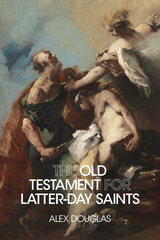 The Old Testament for Latter-day Saints
Douglas, Alex
Signature Books, 2023 In The Old Testament for Latter-day Saints, Alex Douglas explores the Old Testament from various perspectives: as a believer, a skeptic, a secular scholar, and a member of the Latter-day Saint community. He delves deep into biblical scholarship, incorporating insights from disciplines such as ancient Near Eastern archaeology and the rich mythic traditions of Israel’s neighboring cultures. By doing so, Douglas helps the reader appreciate the profound significance the Old Testament held for its earliest readers.
This book also explores the intriguing ways in which Latter-day Saints have interpreted and engaged with this ancient text and the author navigates their diverse interpretations of it. He examines how individuals have alternately embraced the Old Testament as myth or history, law or legend, wise counsel or sacred scripture. He shows where many traditional interpretations have come from, and offers many ways to encourage a more nuanced understanding of the text.
Drawing from a wealth of scholarly research and his own unique perspective, Douglas presents a compelling and multidimensional analysis of the Old Testament. However readers approach the text, this book sheds light on the complex nature of the Old Testament and its enduring relevance to the Latter-day Saint tradition.
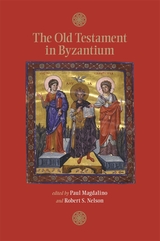 The Old Testament in Byzantium
Paul Magdalino
Harvard University Press, 2010 This volume contains selected papers from a December 2006 Dumbarton Oaks symposium that complemented an exhibition of early Bible manuscripts at the Freer Gallery and Sackler Gallery of Art titled "In the Beginning: Bibles before the Year 1000." Speakers were invited to examine the use of the Greek Old Testament as a text, social practice, and cultural experience in the Byzantine Empire. Not only are reminiscences of the Old Testament ubiquitous in Byzantine literature and art, but the Byzantine people also revered and identified with Old Testament role models. The Old Testament connected Byzantium not only with its Christian neighbors but with Jewish and Muslim peoples as well. This widespread phenomenon has never received systematic investigation. The Old Testament in Byzantium considers the manifestations of the holy books in Byzantine manuscript illustration, architecture, and government, as well as in Jewish Bible translations and the construction of Muhammad's character.
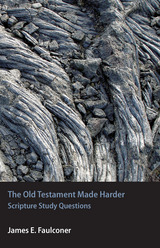 The Old Testament Made Harder
James E. Faulconer
Neal A. Maxwell Institute for Religious Scholarship, 2014 Latter-day Saint philosopher James E. Faulconer’s Made Harder series raises many more questions than it answers. And that is precisely the point. Faulconer wrote The Old Testament Made Harder on the premise that our scripture study is only as good as the questions we bring to the endeavor. While many books about the Old Testament provide useful shortcuts, chapter synopses, timelines, and memorizable bullet points, this book consists almost entirely of challenging questions (with occasional commentary for clarity’s sake) because, in Faulconer’s experience, questions themselves are the key to reflective and deep scripture study. This book is intended to make reading harder—and therefore fresher—by priming your pondering pump with insightful study questions. The Old Testament Made Harder is the perfect tool to improve personal and family scripture study, sacrament meeting talks, or Sunday School lessons. So much of modern life is geared to finding faster and easier ways to do the same old things. The Made Harder series is proof that making things easier does not always make them better.
Old Testament Manuscripts in the Freer Collection
Henry A. Sanders
University of Michigan Press, 1917 A publication of the Washington Manuscripts of Deuteronomy, Joshua, and the Psalms, The Old Testament Manuscripts in the Freer Collection offers copies of the relevant texts, an analysis of the materials used to create the manuscripts, the hands, and textual problems. Extensive plates of the manuscripts are included.
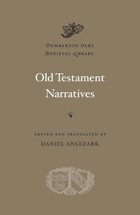 Old Testament Narratives
Daniel Anlezark
Harvard University Press, 2011 The Old English poems in this volume are among the first retellings of scriptural texts in a European vernacular. More than simple translations, they recast the familiar plots in daringly imaginative ways, from Satan's seductive pride (anticipating Milton), to a sympathetic yet tragic Eve, to Moses as a headstrong Germanic warrior-king, to the lyrical nature poetry in Azarias.
Whether or not the legendary Caedmon authored any of the poems in this volume, they represent traditional verse in all its vigor. Three of them survive as sequential epics in a manuscript in the Bodleian Library at Oxford. The first, the Old English Genesis, recounts biblical history from creation and the apocryphal fall of the angels to the sacrifice of Isaac; Abraham emerges as the central figure struggling through exile toward a lasting covenant with God. The second, Exodus, follows Moses as he leads the Hebrew people out of Egyptian slavery and across the Red Sea. Both Abraham and Moses are transformed into martial heroes in the Anglo-Saxon mold. The last in the triad, Daniel, tells of the trials of the Jewish people in Babylonian exile up through Belshazzar's feast. Azarias, the final poem in this volume (found in an Exeter Cathedral manuscript), relates the apocryphal episode of the three youths in Nebuchadnezzar's furnace.
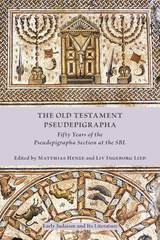 The Old Testament Pseudepigrapha: Fifty Years of the Pseudepigrapha Section at the SBL
Matthias Henze
SBL Press, 2019 A history of research that changed scholarly perceptions of early Judaism
This collection of essays by some of the most important scholars in the fields of early Judaism and Christianity celebrates fifty years of the study of the Old Testament Pseudepigrapha at the Society of Biblical Literature and the pioneering scholars who introduced the Pseudepigrapha to the Society. Since its early days as a breakfast meeting in 1969, the Pseudepigrapha Section has provided a forum for a rigorous discussion of these understudied texts and their relevance for Judaism and Christianity. Contributors recount the history of the section's beginnings, critically examine the vivid debates that shaped the discipline, and challenge future generations to expand the field in new interdisciplinary directions.
Features:
- Reflections from early members of the Pseudepigrapha Group
- Essays that examine a methodological shift from capturing and preserving traditions to exploring the intellectual and social world of Jewish antiquity
- Evaluations of past interactions with adjacent fields and the larger academic world
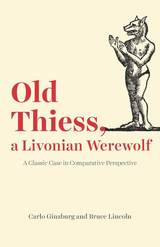 Old Thiess, a Livonian Werewolf: A Classic Case in Comparative Perspective
Carlo Ginzburg and Bruce Lincoln
University of Chicago Press, 2020 In 1691, a Livonian peasant known as Old Thiess boldly announced before a district court that he was a werewolf. Yet far from being a diabolical monster, he insisted, he was one of the “hounds of God,” fierce guardians who battled sorcerers, witches, and even Satan to protect the fields, flocks, and humanity—a baffling claim that attracted the notice of the judges then and still commands attention from historians today.
In this book, eminent scholars Carlo Ginzburg and Bruce Lincoln offer a uniquely comparative look at the trial and startling testimony of Old Thiess. They present the first English translation of the trial transcript, in which the man’s own voice can be heard, before turning to subsequent analyses of the event, which range from efforts to connect Old Thiess to shamanistic practices to the argument that he was reacting against cruel stereotypes of the “Livonian werewolf” a Germanic elite used to justify their rule over the Baltic peasantry. As Ginzburg and Lincoln debate their own and others’ perspectives, they also reflect on broader issues of historical theory, method, and politics. Part source text of the trial, part discussion of historians’ thoughts on the case, and part dialogue over the merits and perils of their different methodological approaches, Old Thiess, a Livonian Werewolf opens up fresh insight into a remarkable historical occurrence and, through it, the very discipline of history itself.
Old Times on the Upper Mississippi: Recollections of a Steamboat Pilot from 1854 to 1863
George Byron Merrick
University of Minnesota Press, 2001 A long-awaited new edition of the steamboating classic. George Byron Merrick chronicles the entire panorama of steamboat life he experienced in the mid-1800s, where he started as a cabin boy and worked up to cub pilot on the mighty Mississippi. Originally published in 1909, Merrick’s narrative matches lively stories about gamblers, shipwrecks, and steamboat races with rich descriptions of river life and steamboat operations. Fesler-Lampert Minnesota Heritage Series
Old Town Road: A Song by Lil Nas X with Billy Ray Cyrus
Chris Molanphy
Duke University Press, 2023 In Old Town Road, Chris Molanphy considers Lil Nas X’s debut single as pop artifact, chart phenomenon, and cultural watershed. “Old Town Road” was more than a massive hit, with the most weeks at No. 1 in Billboard Hot 100 history. It is also a prism through which to track the evolution of popular music consumption and the ways race influences how the music industry categorizes songs and artists. By both lionizing and satirizing genre tropes—it’s a country song built from an alternative rock sample, a hip-hop song in which nobody raps, a comical song that transcends novelty, and a queer anthem—Lil Nas X troubles the very idea of genre. Ultimately, Molanphy shows how “Old Town Road” channeled decades of Americana to point the way toward our cultural future.
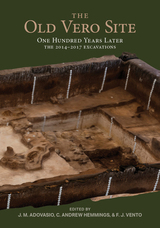 The Old Vero Site (8IR009): One Hundred Years Later, The 2014 - 2017 Excavations
James M. Adovasio, C. Andrew Hemmings, and F. J. Vento
University of Utah Press, 2023 A century ago, the Old Vero Site was brought to prominence by Elias Sellards, who claimed that the human remains discovered there were contemporary with Pleistocene fauna. It was the first serious challenge to the belief, widely accepted until the Folsom discoveries in 1926, that humans had not entered Florida before the current Holocene geological epoch. The argument made by Sellards, that early human occupants of North America lived alongside late Ice Age animals, stirred enduring controversy. Recent construction near the site resulted in new archaeological work being completed from 2014 to 2017.
The Old Vero Site details the course of the recent re-excavations of the site while also summarizing the original excavations from a century ago. The volume lays out the sequence and results of the recent project, using new data to conclude that Sellards’s claims are not supported by the evidence. Adovasio, Hemmings, and Vento provide the data to settle the matter definitively: human remains at the site were intrusive from a later time horizon, as critics of the original work had vociferously argued.
Old Wine
Phyllis Bottome
Northwestern University Press, 1998
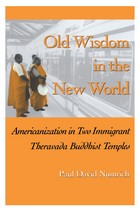 Old Wisdom in the New World: Americanization in Two Immigrant Theravada Buddhist Temples
Paul David Numrich
University of Tennessee Press, 2000 Focusing on two well-established institutions—one in Chicago, the other in Los Angeles—Old Wisdom in the New World is the first systematic examination of the growing presence of Theravada Buddhist temples in the United States.
Paul David Numrich's socio-historical analysis highlights a number of classic Americanization themes of establishment, growth, and adaptation. These have surfaced, the author shows, in debates over the retention of Old World culture and language, the "problem" of the second generation, and the role of the laity in religious institutions. Going beyond such familiar themes, Numrich also uncovers the intriguing phenomenon of ethnically defined "parallel congregations" in these temples, as he reveals the ways in which Asian-immigrant Buddhists and American converts pursue substantively different expressions of the Theravada tradition under the direction of a shared clerical leadership, the resident monks.
In the author's view, these Theravada case studies underline the complexity of the present Americanization process. By examining the intersection of two important trends—the steady growth of Asian immigration and an increasing indigenous interest in new religious movements, especially those of Asian origin—this book points to some fascinating new directions for the study of religious and cultural diversity in the United States.
The Author: Paul David Numrich is a research associate in the Religion in Urban America Program at the University of Illinois at Chicago.
Old Wives' Tales
Susan M. Dodd
University of Iowa Press, 1984 In these ten varied and keenly rendered tales, Susan Dodd explores the levels of the human heart by leading us through a gallery of feelings, insights, characters, and emotions. Whether writing about a 100-year-old woman in South America, a teenage suicide in Winnetka, a divorced couple meeting by chance, or a pair of lovers listening to the family on the other side of their apartment wall, Dodd places us in a world full of subdued conflict where bonds between loved ones and strangers are tested, broken, and sometimes renewed. Her themes range beyond the regional or contemporary, embracing those moments of loneliness and self-knowledge that confront us all. As the characters meet and separate, wonder and react, we travel with them, exploring the forms of our existence, and the substance of our hearts.
The Old Woman, the Tulip, and the Dog
Alicia Suskin Ostriker
University of Pittsburgh Press, 2014 This book by a major American poet is for poetry readers at all levels, academic and non-academic. It is a sequence of poems that will surprise and delight readers—in the voices of an old woman full of memories, a glamorous tulip, and an earthy dog who always has the last word.
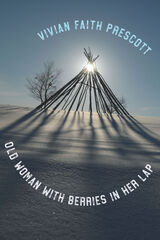 Old Woman with Berries in Her Lap
Vivian Faith Prescott
University of Alaska Press, 2022 Through a single descendant’s voice that speaks to the Sámi diaspora, this collection of poems is a journey through colonialism, transgenerational trauma, and identity. Many have heard of the Sámi reindeer herders brought to Alaska by Sheldon Jackson in the 1800s, but not much is known about the Sámi diaspora experiences in the state and beyond. The poems in Old Woman with Berries in Her Lap use the North Sámi language as well as graphics and various types of poetry to tell these stories of migration and diaspora. Vivian Faith Prescott’s use of language is both a celebration of the richness of the Sámi languages and a mourning of the loss of language that occurs when a population is displaced and forced to exist in a totally foreign language space. According to Sámilinguist, professor, and politician Ole Henrik Magga, the Sámi languages have “very easily . . . one thousand lexemes with connections to snow, ice, freezing, and melting.” These lexemes frame many of Prescott’s poems, introducing ideas and feelings around the loss of language and culture. A compelling insight into the Sámi culture from a contemporary poet’s eye, Old Woman with Berries in Her Lap juxtaposes past and present in an act of reclamation.
 Old World
Fabienne Kanor
Seagull Books, 2024 Traversing heritage across three continents, this poignant coming-of-age novel chronicles the enduring presence of systemic racism and the resistance to it.
Born in Cameroon and raised in the suburbs of Paris, Nathan feels unmoored, as if he does not belong in France. His mother tells him about his great-grandfather who left Cameroon for New Orleans to seek his fortune shortly after World War II. Nathan travels there to search for the vestiges of his ancestor’s passage in America. To him, New Orleans is the promised land for the Black man.
However, renting a room in a shotgun house in the Tremé district, he discovers a different reality. This storied neighborhood testifies to the strength of a people who have survived slavery, segregation, and the struggle for civil rights with a strong sense of community. But the relentless inequities, capped by Hurricane Katrina and its aftermath, have taken a toll. As Nathan comes to understand this fraught history, he also plumbs his own past, including his sense of abandonment by his father in Cameroon. In this coming-of-age novel, Nathan is coming to be.
The evocative, poetic language of Fabienne Kanor’s novel confers a brutal beauty in incidents of violence and moments of joy, holding the reader in a constant state of tension. Peopled by flawed human beings trying to find their way and grow a life under the constant threat of violence, Old World chronicles the deep trauma and long-term effects of systemic racism in the United States and people’s efforts to rise above it.
 Old World, New Horizons: Britain, Europe, and the Atlantic Alliance
Edward Heath
Harvard University Press The effort to achieve greater European unity has absorbed the interests and energies of a number of Europeans and Americans since the end of World War II. Edward Heath, who led Britain's earliest attempt to join the European Economic Community, first made this comprehensive statement of the philosophy and purpose behind the movement for European unity in a series of lectures he gave at Harvard University in March 1967. In discussing the future development of Europe, Mr. Heath considered factors relating to domestic and foreign politics, economics, and defense, presenting a complete picture of Europe and suggesting a course that might bring about a successful unity.
"The lectures," writes Mr. Heath in 1970, "...were an attempt to look behind the immediate headlines and examine in greater depth the stage which Europe had reached in its search for unity. I was particularly concerned to trace the development of the European Economic Community and to deduce from its history the direction of its future development. At the same time I examined Britain's attitude towards the EEC and how British aspirations in Europe fitted into a general concept of Britain's place in the world..."
"Much has happened since March 1967, but insofar as they concern Europe, events have in a curious way brought us full circle. Now, as in 1967, we in Europe are in the middle of a lively debate about our future. This debate has two main facets. It is partly a debate throughout our continent on the meaning and content of the search for European unity. It is partly a debate within Britain on the likelihood and wisdom of Britain's entry into the EEC and on the effect which such entry would have upon our future prosperity, security, and national identity."
Mr. Heath has updated the lectures in his introduction, although his lucid and intelligent analysis remains extremely far-sighted even in the context of subsequent political changes and events. His consideration of Europe's future is not merely theoretical--Mr. Heath speaks from the standpoint of one who has had direct and continuous practical experience with the problems of Europe. His frank recognition of Britain's loss of power in the world and his belief that through Europe his country may win new influence and play a new political role attest to his great insight. These lectures are thus an important political statement by one of Europe's outstanding leaders.
Old Yukon: Tales, Trails, and Trials
James Wickersham
University of Alaska Press, 2009 In this humorous and upbeat memoir, James Wickersham describes his career as a pioneer judge and later as a congressional representative assigned to a vast, snow-covered district, extending over 300,000 square miles in the undeveloped Alaska Territory. Wickersham’s many adventures include traveling by dogsled over hundreds of miles through snow-covered mountains; serving as judge for the trials of many famous outlaws in the midst of the gold strikes; and hunting, mining, and climbing in his local Alaska wilderness. Though he was instrumental in the early history of Alaska, and his legacy is evident throughout the state—for example, he named the city of Fairbanks—this is the first and only work to focus on Wickersham’s life during this pivotal time in Alaska’s history.
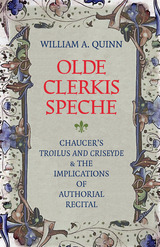 Olde Clerkis Speche: Chaucer's Troilus and Criseyde and the Implications of Authorial Recital
William A. Quinn
Catholic University of America Press, 2013 Olde Clerkis Speche affirms both the historical legitimacy and the interpretive benefits of reading Troilus and Criseyde as if the text were initially composed for Chaucers own recital before a familiar audience. Proposing a qualification rather than contradiction of the "persona" as a reading premise, Quinn revitalizes the interpretive context of Chaucers original performance milieu. The central five chapters offer a "close hearing" of the possible tonal strategies of each book of Troilus and Criseyde during actual recital. Particular attention is given to expressions now normally overlooked, phrasing that does not advance the modern readers appreciation of plot or character development or theme; such "filler" did, however, once offer Chaucer's own "reader response" (or ennaratio) during the recital event. These five chapters simultaneously evaluate the probability that Chaucer himself revised each recital installment for subsequent manuscript circulation. All together, these chapters provide a sustained case study of the interplay between the author's anticipations of recital presence and textual absence. Although this study does not pretend to detail an inaugural staging of Troilus and Criseyde , it does attend to the histrionic potential of Chaucer's own "speche/ In poetrie" (T&C V. 1854-5). The final chapter discusses how such a recital premise impacts several current controversies among Chaucerians, including the dating of Chaucer's individual acts of composition, the underlying assumptions regarding the "publication" of each text, the editorial imposition of punctuation on the manuscript record, and the poets increasing anxiety regarding his future absence from the reading event. Olde Clerkis Speche will be of interest to all readers of Chaucer as well as everyone interested in performance theory and the history of reading.
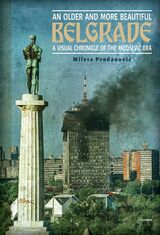 An Older and More Beautiful Belgrade: A Visual Chronicle of the Milo.evic Era
Mileta Prodanovic
Central European University Press, 2023 This substantial essay depicts urban collapse in an exceptionally difficult period of the Serbian capital. The author has marshalled facts, reflections, photographs and other imagesto demonstrate the transformation of Belgrade during the Milošević years. With the theoretical grounding of cultural anthropology, history studies, culture of memory, history of art, and urbanism, Mileta Prodanović considers changes to the built environment and urban landscape in the city in the 1990s. He covers many visual aspects of life with great ingenuity: shopping centers, unregulated construction and “wild” modifications of buildings, new buildings (broadcasting studios, shops, homes) that do not fit the surroundings, bad taste in home furnishings (camp, kitsch), boondoggles such as the international art center, problematic historical markers like the obelisk of the eternal flame, billboards, store displays, electoral propaganda, graffiti, grave-markers and cemetery memorials, coins and paper money, calendars, beer labels, and even religious icons (and more). All this information is provided with some critique and much implied comparison to past standards.
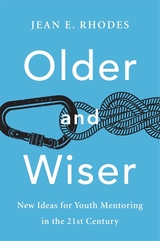 Older and Wiser: New Ideas for Youth Mentoring in the 21st Century
Jean E. Rhodes
Harvard University Press, 2020 Youth mentoring programs must change in order to become truly effective. The world’s leading expert shows how.
Youth mentoring is among the most popular forms of volunteering in the world. But does it work? Does mentoring actually help young people succeed? In Older and Wiser, mentoring expert Jean Rhodes draws on more than thirty years of empirical research to survey the state of the field. Her conclusion is sobering: there is little evidence that most programs—even renowned, trusted, and long-established ones—are effective. But there is also much reason for hope.
Mentoring programs, Rhodes writes, do not focus on what young people need. Organizations typically prioritize building emotional bonds between mentors and mentees. But research makes clear that effective programs emphasize the development of specific social, emotional, and intellectual skills. Most mentoring programs are poorly suited to this effort because they rely overwhelmingly on volunteers, who rarely have the training necessary to teach these skills to young people. Moreover, the one-size-fits-all models of major mentoring organizations struggle to deal with the diverse backgrounds of mentees, the psychological effects of poverty on children, and increasingly hard limits to upward mobility in an unequal world.
Rhodes doesn’t think we should give up on mentoring—far from it. She shows that evidence-based approaches can in fact create meaningful change in young people’s lives. She also recommends encouraging “organic” mentorship opportunities—in schools, youth sports leagues, and community organizations.
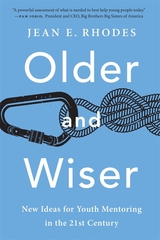 Older and Wiser: New Ideas for Youth Mentoring in the 21st Century
Jean E. Rhodes
Harvard University Press Winner of the Eleanor Maccoby Book Award
“This engaging and well-written book is a significant advance in our understanding of when and how mentoring matters…[It] lays the foundations for an approach to mentoring that is both rigorous and rich in new ideas.”
—Robert D. Putnam, author of Our Kids: The American Dream in Crisis
“Rhodes forces us to slam the brakes on ineffective practices and improve an industry that is devoted to the potential of our nation’s children…The author’s concrete recommendations will create new pathways to opportunity for youth in greatest need.”
—Michael D. Smith, Executive Director, My Brother’s Keeper Alliance
“A powerful assessment of what is needed to best help young people today.”
—Pam Iorio, President and CEO, Big Brothers Big Sisters of America
Youth mentoring is one of the most popular forms of volunteering in the world today, but does it work? Drawing on over thirty years of research and her own experience in the field, Jean Rhodes reveals that most mentoring programs fail to deliver what young people actually need. Many prioritize building emotional bonds between mentors and mentees. But research shows that effective programs go far beyond this, developing specific social, emotional, and intellectual skills.
Most mentoring programs rely on volunteers, who rarely have the training to teach these skills. Their one-size-fits-all models struggle to meet the diverse needs of mentees, and rarely take account of the psychological effects of poverty on children. Rhodes doesn’t think we should give up on mentoring—far from it. Instead, she recommends “organic” mentorship opportunities—in schools, youth sports leagues, and community organizations—and shares specific approaches that can spark meaningful change in young people’s lives.
Older Veterans: Linking VA and Community Resources
Terrie Wetle, Ph.D.
Harvard University Press, 1984 The Veterans Administration has assumed a leadership role in the development of geriatric programs for older veterans, particularly those from World War II. Increased demands for VA care and for new services have led to an exploration of improved integration of VA and community resources. This book begins with an overview of geriatric care including the special illness behaviors of elders and the attitudes of their care providers, followed by a description of geriatric and extended care and the legislative mandate of the VA. Analysis of current patterns of utilization and descriptions of innovative programs for service coordination and case management lead to suggested options for improving integration of VA and non VA services. The book will be of great interest to policy makers, program planners, and service providers.
 The Oldest Constitutional Question: Enumeration and Federal Power
Richard Primus
Harvard University Press, 2025 A groundbreaking challenge to a core principle of constitutional law, arguing that congressional action is not limited by the legislative branch’s textually enumerated powers.
Every law student learns that the federal government is constrained to act only according to its enumerated powers, meaning that Congress can do what the Constitution expressly authorizes it to and nothing more. Yet Richard Primus contends that this longstanding orthodoxy—allegedly required by the text of the Constitution, the Framers’ vision, and the logic of federalism—is fundamentally flawed.
Through careful analysis of constitutional text and history, and of the structure of American federalism, The Oldest Constitutional Question builds a powerful argument for broad congressional authority. In particular, Primus shows that the primary function of enumeration is to rule listed powers in, not to rule other powers out. The Framers were more worried that the federal government might be fragile and anemic than that it would be overwhelmingly strong. Enumerating congressional powers is thus best understood as a way of ensuring that the federal legislature has an incontestable warrant to exercise the powers specified there, not as an exhaustive description of all that Congress can do.
In practice, the enumeration of powers does little to limit Congress. But most constitutional lawyers—including many Supreme Court justices—think this means something has gone wrong, such that the courts must aggressively strike down federal laws exceeding Congress’s enumerated powers. Primus’s meticulous examination explodes the prevailing view, revealing its underlying errors. The constitutional system does place limits on Congress, and crucially so, but the enumeration of powers is not, and never has been, a sensible means for creating and enforcing those limits.
The Oldest Cuisine in the World: Cooking in Mesopotamia
Jean Bottéro
University of Chicago Press, 2004 In this intriguing blend of the commonplace and the ancient, Jean Bottéro presents the first extensive look at the delectable secrets of Mesopotamia. Bottéro’s broad perspective takes us inside the religious rites, everyday rituals, attitudes and taboos, and even the detailed preparation techniques involving food and drink in Mesopotamian high culture during the second and third millennia BCE, as the Mesopotamians recorded them. Offering everything from translated recipes for pigeon and gazelle stews, the contents of medicinal teas and broths, and the origins of ingredients native to the region, this book reveals the cuisine of one of history’s most fascinating societies. Links to the modern world, along with incredible recreations of a rich, ancient culture through its cuisine, make Bottéro’s guide an entertaining and mesmerizing read.
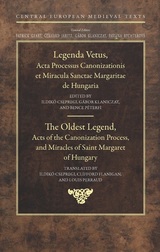 The Oldest Legend: Acts of the Canonization Process, and Miracles of Saint Margaret of Hungary
Bence Péterfi
Central European University Press, 2018 This bilingual volume (Latin text with English translation) is the second in the series presenting hagiographical narratives from medieval Central Europe. It contains the most important hagiographical corpus of medieval Hungarian history: that of Saint Margaret (1242–1270), daughter of King Béla IV, who lived her life as a Dominican nun. Margaret’s cult started immediately after her death and the demand to examine her sanctity was first formulated in 1272. The canonization process recommenced in 1276, followed by further initiatives across the centuries. Margaret was eventually canonized only in 1943. Besides the full Latin text and the English translation of her oldest legend, written between 1272 and 1275, this volume contains the acts of the 110 testimonies of the papal investigation concerning her sainthood, recorded between July and October 1276 and prepared from existing source editions. In addition, the editors include a series of recently discovered documents, including a petition by the bishop of Várad (Oradea) to promote the cause, and the notarial records of a set of miracles that occurred at Margaret's grave in the second half of the fifteenth century. The annotated bilingual text is complemented by a select bibliography on Saint Margaret and her hagiography.
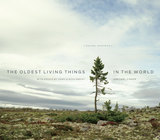 The Oldest Living Things in the World
Rachel Sussman
University of Chicago Press, 2014 The Oldest Living Things in the World is an epic journey through time and space. Over the past decade, artist Rachel Sussman has researched, worked with biologists, and traveled the world to photograph continuously living organisms that are 2,000 years old and older. Spanning from Antarctica to Greenland, the Mojave Desert to the Australian Outback, the result is a stunning and unique visual collection of ancient organisms unlike anything that has been created in the arts or sciences before, insightfully and accessibly narrated by Sussman along the way.
Her work is both timeless and timely, and spans disciplines, continents, and millennia. It is underscored by an innate environmentalism and driven by Sussman’s relentless curiosity. She begins at “year zero,” and looks back from there, photographing the past in the present. These ancient individuals live on every continent and range from Greenlandic lichens that grow only one centimeter a century, to unique desert shrubs in Africa and South America, a predatory fungus in Oregon, Caribbean brain coral, to an 80,000-year-old colony of aspen in Utah. Sussman journeyed to Antarctica to photograph 5,500-year-old moss; Australia for stromatolites, primeval organisms tied to the oxygenation of the planet and the beginnings of life on Earth; and to Tasmania to capture a 43,600-year-old self-propagating shrub that’s the last individual of its kind. Her portraits reveal the living history of our planet—and what we stand to lose in the future. These ancient survivors have weathered millennia in some of the world’s most extreme environments, yet climate change and human encroachment have put many of them in danger. Two of her subjects have already met with untimely deaths by human hands.
Alongside the photographs, Sussman relays fascinating – and sometimes harrowing – tales of her global adventures tracking down her subjects and shares insights from the scientists who research them. The oldest living things in the world are a record and celebration of the past, a call to action in the present, and a barometer of our future.
The Old-Time Saloon: Not Wet - Not Dry, Just History
George Ade
University of Chicago Press, 2016 Fancy a tipple? Then pull up a stool, raise a glass, and dip into this delightful paean to the grand old saloon days of yore. Written by Chicago-based journalist, playwright, and all-round wit George Ade in the waning years of Prohibition, The Old-Time Saloon is both a work of propaganda masquerading as “just history” and a hilarious exercise in nostalgia. Featuring original, vintage illustrations along with a new introduction and notes from Bill Savage, Ade's book takes us back to the long-gone men’s clubs of earlier days, when beer was a nickel, the pretzels were polished, and the sardines were free.
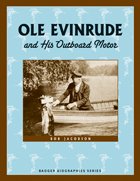 Ole Evinrude and His Outboard Motor
Bob Jacobson
Wisconsin Historical Society Press, 2009 Wisconsin entrepreneur Ole Evinrude will inspire children in this addition to the Badger Biographies series for young readers, where the story of Ole's invention, from drawing board to factory floor, is told in a reader-friendly format that includes historic images, a glossary of terms, and sidebars explaining how an outboard motor works. Ole Evinrude was born in Norway in 1877 and immigrated to the United States when he was five years old. The Evinrude family settled in Wisconsin and began farming, but it was clear from a very young age that Ole would not follow the family tradition. Ole Evinrude was meant to work with boats. Building an outboard motor was not easy, though - Ole suffered numerous mechanical and financial setbacks along the way. After years of hard work and persistence, the Evinrude motor company was founded and Ole's outboard motors were an instant hit around the world. Ole continued to improve the design of his motor and attracted other entrepreneurs to the area, making Wisconsin the center of the outboard motor industry for decades.
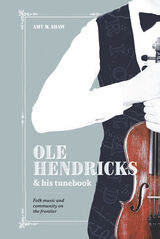 Ole Hendricks and His Tunebook: Folk Music and Community on the Frontier
Amy M. Shaw
University of Wisconsin Press, 2020 Ole Hendricks was an immigrant both representative and exceptional—a true artistic talent who nevertheless lived a familiar immigrant experience. By day, he was a farmer. But at night, his fiddle lit up dance halls, bringing together all manner of neighbors in rural Minnesota. Each tune in his repertoire of waltzes, reels, polkas, quadrilles, and more were copied neatly into his commonplace book.
Such tunebooks, popular during the nineteenth century, rarely survive and are often overlooked by folk scholars in favor of commercially produced recordings, published sheet music, or oral tradition. Based on extensive historical and genealogical research, Amy Shaw presents a grounded picture of a musician, his family, and his community in the Upper Midwest, revealing much about music and dance in the area. This notable contribution to regional music and folklore includes more than one hundred of Ole's dance tunes, transcribed into modern musical notation for the first time. Ole Hendricks and His Tunebook will be valuable to readers and scholars interested in ethnomusicology and the Norwegian American immigrant experience.
Olesha's "Envy": A Critical Companion
Rimgaila Salys
Northwestern University Press, 1999 This book, part of the acclaimed AATSEEL Critical Companions series, is designed to guide readers through Envy, Yury Olesha's humorous look at the individual's struggle with an increasingly industrialized society. This companion acquaints the reader with the history, biographical context, critical reception, and interpretation problems related to the novel. It also helps the reader decipher the book's difficult features, including its shifting narrators and fluid boundaries between dream and reality.
In addition, this critical companion presents documents from the period pertaining to the novel, excerpts from Olesha's memoirs, and a listing of important criticism.
 Olfactory Rhetoric: Sniffing Out Environmental Problems
Lisa L. Phillips
Ohio State University Press, 2025 Human senses have the potential to play a significant role in inspiring action to combat climate change. When we smell pollutants in the air, for example, or feel the blast of a polar vortex, we are more likely to act in response to these changes in environmental conditions. However, the sensorium—and particularly our sense of smell—is often downplayed when we consider the rhetorics of environmental crises. In Olfactory Rhetoric, Lisa L. Phillips argues that how we sense the world around us should be a crucial piece of rhetorical evidence when evaluating environmental injustices. Specifically, Phillips elevates olfaction (what we smell) and olfactory rhetoric (how we talk about and experience what we smell) when discussing three contemporary environmental crises set in historically marginalized communities: the Sriracha sauce factory controversy, the Salton Sea scent events, and the Blue Ridge Landfill emissions problem. On a broader scale, Phillips develops an intersectional ecofeminist sensory-rhetorical approach for evaluating how olfactory and sensory persuasions work and how they can be used to advocate for environmental justice and a more breathable future.
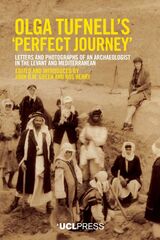 Olga Tufnell's “Perfect Journey”: Letters and Photographs of an Archaeologist in the Levant and Mediterranean
Edited by John D.M. Green and Henry Ros
University College London, 2021 A fascinating personal account of archaeology and travel in the interwar era in Palestine.
Olga Tufnell was a British archaeologist working in Egypt, Cyprus, and Palestine in the 1920s and 1930s—a period often described as a golden age of archaeological discovery. For the first time, this book presents Tufnell’s account of her experiences in her own words. Based largely on letters, the text is accompanied by dozens of photographs that shed light on her personal experiences of travel and dig life at this extraordinary time. Introductory material by John D.M. Green and Ros Henry provides the social, historical, biographical, and archaeological context, as the letters offer new insights into the social and professional networks and history of archaeological research in Palestine under the British Mandate. They provide insights into the role of foreign archaeologists, relationships with local workers and inhabitants, and the colonial framework within which they operated during turbulent times. This book will be an important resource for those studying the history of archaeology in the Eastern Mediterranean, particularly for the sites of Qau el-Kebir, Tell Fara, Tell el-‘Ajjul and Tell ed-Duweir (ancient Lachish). Moreover, Tufnell’s lively style makes this a fascinating personal account of archaeology and travel in the interwar era.
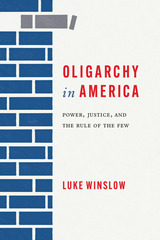 Oligarchy in America: Power, Justice, and the Rule of the Few
Luke Winslow
University of Alabama Press, 2024 Roderick P. Hart Outstanding Book Award for the National Communication Association's Political Communication Division A fascinating survey of the history of political and economic ideas in the US that have led to an increasingly entrenched ultra-rich class of oligarchs. To an American, oligarchy is something that happens somewhere else. In Oligarchy in America, Luke Winslow reveals oligarchy’s deep intellectual roots and alarming growth in America. The book provides conceptual tools the lack of which have prevented Americans from recognizing oligarchy at home. Winslow argues that generic labels like “billionaires” for a class of ultra-rich masks the pervasive structures that entrench their power. He introduces instead the concept of democratic oligarchy—an institutional arrangement in which the ultra-rich form a class consciously creating and leveraging state power to accumulate wealth. Like a master class in political ideas, Winslow traces the intellectual lineage of oligarchy in the US. His lively and compulsively readable survey examines key rhetorical sources such as Herbert Spencer, Andrew Carnegie, Friedrich Hayek, Lewis Powell, Milton Friedman, Charles Koch, Donald Trump, Tucker Carlson, and others. Oligarchy in America maps the connective web of oligarchic ideas uniting these disparate figures. By offering a lucid framework through which to view oligarchic ideas ambient in American culture, Winslow makes a vital contribution to readers and scholars of communication and rhetorical studies, public address, economics, and political science.
Olimpismo: The Olympic Movement in the Making of Latin America and the Caribbean
Antonio Sotomayor
University of Arkansas Press, 2020 The Olympic Games are a phenomenon of unparalleled global proportions. This book examines the rich and complex involvement of Latin America and the Caribbean peoples with the Olympic Movement, serving as an effective medium to explore the making of this region. The nine essays here investigate the influence, struggles, and contributions of Latin American and Caribbean societies to the Olympic Movement. By delving into nationalist political movements, post-revolutionary diplomacy, decolonization struggles, gender and disability discourses, and more, they define how the nations of this region have shaped and been shaped by the Olympic Movement.
Oliver Heaviside: Maverick Mastermind of Electricity
Basil Mahon
The Institution of Engineering and Technology, 2009 Oliver Heaviside (1850-1925) was one of the great pioneers of electrical science. His ideas led to huge advances in communications and now form much of the bedrock of electrical engineering - every textbook and every college course bears his stamp.
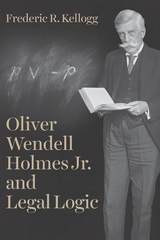 Oliver Wendell Holmes Jr. and Legal Logic
Frederic R. Kellogg
University of Chicago Press, 2018 With Oliver Wendell Holmes, Jr. and Legal Logic, Frederic R. Kellogg examines the early diaries, reading, and writings of Justice Oliver Wendell Holmes, Jr. (1841–1935) to assess his contribution to both legal logic and general logical theory. Through discussions with his mentor Chauncey Wright and others, Holmes derived his theory from Francis Bacon’s empiricism, influenced by recent English debates over logic and scientific method, and Holmes’s critical response to John Stuart Mill’s 1843 A System of Logic.
Conventional legal logic tends to focus on the role of judges in deciding cases. Holmes recognized input from outside the law—the importance of the social dimension of legal and logical induction: how opposing views of “many minds” may converge. Drawing on analogies from the natural sciences, Holmes came to understand law as an extended process of inquiry into recurring problems.
Rather than vagueness or contradiction in the meaning or application of rules, Holmes focused on the relation of novel or unanticipated facts to an underlying and emergent social problem. Where the meaning and extension of legal terms are disputed by opposing views and practices, it is not strictly a legal uncertainty, and it is a mistake to expect that judges alone can immediately resolve the larger issue.
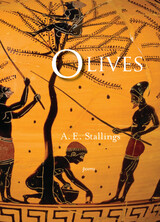 Olives: Poems
A.E. Stallings
Northwestern University Press, 2012 Finalist, 2012 NBCC Award in the Poetry category
Recipient, 2011 MacArthur Fellowship and Guggenheim Fellowship A. E. Stallings has established herself as one of the best American poets of her generation. In addition to a lively dialogue with both the contemporary and ancient culture of her adopted homeland, Greece, this new collection features poems that, in her inimitable voice, address the joys and anxieties of marriage and motherhood. This collection builds on previous accomplishments with some longer poems and sequences of greater philosophical scope, such as “On Visiting a Borrowed Country House in Arcadia.” Stallings possesses the rare ability to craft precise poems that pulsate with deeply felt emotion. Like the olives of the title, the book embraces the bitter but savory fruits of the ancient tree, and the tears and sweetness we harvest in our temporary lives. These poems show Stallings in complete command of her talent, able to suggest the world in a word.
 Olivi and the Interpretation of Matthew in the High Middle Ages
Kevin Madigan
University of Notre Dame Press, 2003 “Olivi and the Interpretation of Matthew in the High Middle Ages is an excellent contribution to the growing bibliography on the study of the Bible in the Middle Ages. Kevin Madigan reads the difficult Franciscan texts with skill and shows the complex ways in which exegesis and apocalypticism intersect. It is especially interesting to see the importance of these controversial texts in a larger medieval context.” —E. Ann Matter, University of Pennsylvania
“Olivi and the Interpretation of Matthew in the High Middle Ages is a wonderfully clear and original study of the primary forms of high medieval gospel exegesis.” —Amy Hollywood, Dartmouth College
“. . .A truly excellent book, one that places Olivi’s commentary within a long, developing exegetical tradition and makes good sense of it in the process. Madigan writes well, too, a rare gift in historians.” —David Burr, Virginia Tech
Kevin Madigan studies the development and union of scholastic, apocalyptic, and Franciscan interpretations of the Gospel of Matthew from 1150 to 1350. These interpretations are placed within the context of high-medieval religious life and shifting attitudes of the papacy toward the Franciscan Order. Madigan uses the fortunes of the Franciscan Peter Olivi (d. 1298) and his commentary on Matthew as a lens through which to observe the larger theological and ecclesiastical developments of this era.
Olivier
Francis Beckett
Haus Publishing, 2006 In the 1930s he established himself as a wide-ranging Shakespearean actor. His marriage in 1940 to Vivien Leigh (his second wife) seemed to complete the image of the romantic star. From the mid-40s he excelled in directing himself in Shakespeare on film, such as his dramatically-shot Henry V (1944), with its timely excesses of patriotism. When the new wave of British drama began in the late 1950s, Olivier was immediately part of it. As an actor of such wide range, and a successful producer and director, Olivier was a natural choice to bring the National Theatre into existence in 1963. Together with his new wife Joan Plowright (they had married in 1961), he built up a brilliant company and repertoire at the Old Vic. Olivier became the first actor to be given a peerage.
Ollie Miss
George Wylie Henderson
University of Alabama Press, 2007 Ollie Miss is a folk novel of Southern backwoods and rural, poor black life in Alabama's recent past. The novel serves as an important social record of a past society, time, and circumstance that would evolve into an era of social change, namely the civil rights movement. Ollie Miss is also a love story that speaks of personal loneliness and the need for fulfillment in a young black woman, poor and ignorant, and unattached. It is a story of Ollie Miss's personal struggle to "become" a person in her own right, to be independent, and to find some small measure of happiness in life.
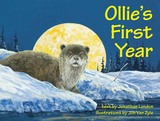 Ollie's First Year
Jonathan London
University of Alaska Press, 2014 It’s easy to find joy in a playful, agile creature that enjoys sliding on its belly. River otters are among the most adorable, charismatic animals in North America, and with a territory that spans the continent, they’re a far-reaching favorite. Ollie’s First Year is a lively wildlife adventure that captures the wonder and delight elicited by the playful otter.
The book follows Ollie the Otter through a year of new experiences, from swimming lessons to foraging practice, and through capers with his littermates. His budding knowledge of the world is put to the test when he is separated from his family and must travel through the forest alone. Luckily, a joyful reunion with his family awaits.
Longtime children’s book author Jonathan London and well-known Alaska illustrator Jon Van Zyle team up again to bring Ollie’s story to life with vibrant illustrations and text perfect for ages two to six. Notes about otter biology and habitat along with tips for keeping their environment safe will not only teach younger readers about wildlife but inspire them to protect it as well.
The Olmec and Their Neighbors: Essays in Memory of Matthew W. Stirling
Elizabeth P. Benson
Harvard University Press, 1981 Matthew Williams Stirling (1896–1975) was an American pioneer archaeologist and ethnologist, best known for his discoveries and work relating to the Olmec civilization. This book contains twenty-one essays on the Olmec, written for this volume in tribute to Stirling, and carefully compiled and edited by Elizabeth Benson.
 Olmec Art at Dumbarton Oaks
Karl A. Taube
Harvard University Press, 2004 Olmec Art at Dumbarton Oaks presents the Olmec portion of the Robert Woods Bliss Collection of Pre-Columbian Art. It illustrates all thirty-nine Olmec art objects in color plates and includes many complementary and comparative black-and-white illustrations and drawings. The body of Pre-Columbian art that Robert Bliss carefully assembled over a half-century between 1912 and 1963, amplified only slightly since his death, is a remarkably significant collection. In addition to their aesthetic quality and artistic significance, the objects hold much information regarding the social worlds and religious and symbolic views of the people who made and used them before the arrival of Europeans in the New World.
This volume is the second in a series of catalogues that will treat objects in the Bliss Pre-Columbian Collection. The majority of the Olmec objects in the collection are made of jade, the most precious material for the peoples of ancient Mesoamerica from early times through the sixteenth century. Various items such as masks, statuettes, jewelry, and replicas of weapons and tools were used for ceremonial purposes and served as offerings.
Karl Taube brings his expertise on the lifeways and beliefs of ancient Mesoamerican peoples to his study of the Olmec objects in teh Bliss collection. His understanding of jade covers a broad range of knowledge from chemical compositions to geological sources to craft technology to the symbolic power of the green stone. Throughout the book the author emphasizes the role of jade as a powerful symbol of water, fertility, and particularly, of the maize plant which was the fundamental source of life and sustenance for the Olmec. The shiny green of the stone was analogous to the green growth of maize. This fundamental concept was elaborated in specific religious beliefs, many of which were continued and elaborated by later Mesoamerican peoples, such as the Maya. Karl Taube employs his substantial knowledge of Pre-Columbian cultures to explore and explicate Olmec symbolism in this catalogue.
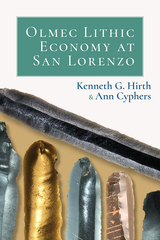 Olmec Lithic Economy at San Lorenzo
Kenneth Hirth
University Press of Colorado, 2020 Olmec Lithic Economy at San Lorenzo examines the specialized craft production, manufacturing, adoption, and spread of obsidian cutting tools at San Lorenzo, Mexico, the first major Olmec center to develop in the southern Gulf Coast region of Mesoamerica. Through the systematic analysis of this single commodity, Kenneth Hirth and Ann Cyphers reconstruct the importation of raw material and the on-site production and distribution of finished goods from a specialized workshop engaged in the manufacture of obsidian blades.
The obsidian blade was the cutting tool of choice across Mesoamerica and used in a wide range of activities, from domestic food preparation to institutional ritual activities. Hirth and Cyphers conducted a three-decade investigation of obsidian artifacts recovered at Puerto Malpica, the earliest known workshop, and seventy-six other sites on San Lorenzo Island, where these tools were manufactured for local and regional distribution. Evidence recovered from these excavations provides some of the first information on how early craft specialists operated and how the specialized technology used to manufacture obsidian blades spread across Mesoamerica. The authors use geochemical analyses to identify thirteen different sources for obsidian during San Lorenzo’s occupation. This volcanic glass, not locally available, was transported over great distances, arriving in nodular and finished blade form.
Olmec Lithic Economy at San Lorenzo offers a new way to analyze the Preclassic lithic economy—the procurement, production, distribution, and consumption of flaked stone tools—and shows how the study of lithics aids in developing a comprehensive picture of the internal structure and operation of Olmec economy. The book will be significant for Mesoamericanists as well as students and scholars interested in economy, lithic technology, and early complex societies.
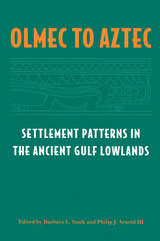 Olmec to Aztec: Settlement Patterns in the Ancient Gulf Lowlands
Barbara L. Stark
University of Arizona Press, 1997 Archaeological settlement patterns—the ways in which ancient people distributed themselves across a natural and cultural landscape—provide the central theme for this long-overdue update to our understanding of the Mexican Gulf lowlands Olmec to Aztec offers the only recent treatment of the region that considers its entire prehistory from the second millennium B.C. to A.D. 1519. The editors have assembled a distinguished group of international scholars, several of whom here provide the first widely available English-language account of ongoing research. Several studies present up-to-date syntheses of the archaeological record in their respective areas. Other chapters provide exciting new data and innovative insights into future directions in Gulf lowland archaeology. Olmec to Aztec is a crucial resource for archaeologists working in Mexico and other areas of Latin America. Its contributions help dispel long-standing misunderstandings about the prehistory of this region and also correct the sometimes overzealous manner in which cultural change within the Gulf lowlands has been attributed to external forces. This important book clearly demonstrates that the Gulf lowlands played a critical role in ancient Mesoamerica throughout the entirety of pre-Columbian history.
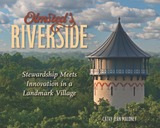 Olmsted's Riverside: Stewardship Meets Innovation in a Landmark Village
Cathy Jean Maloney
Southern Illinois University Press, 2024 WINNER, Certificate of Excellence in “Scholarly Publications” from the Illinois State Historical Society’s 2025 Best of Illinois History Awards!
Honorable Mention, 2025 Society of Midland Authors Award in History!
The challenge to preserve Chicagoland’s unique haven
Just outside the bustling metropolis of Chicago lies the unlikely green oasis of Riverside, Illinois, a small village that has continued to directly influence American landscapes and suburbs since the 1870s. Once farmland, the location provided a blank canvas for preeminent designers Fredrick Law Olmsted and Calvert Vaux’s manifestation of a truly democratic society. Olmsted’s Riverside details the village’s historical significance, harmony with nature, and its nearly 150-year impact on American suburbs today.
Cathy Jean Maloney explores how Riverside’s layout and design presaged today’s urban planning goals of walkability, green space, public transportation access, sustainability, and resiliency. Houses in Riverside are set back from the road, sidewalks meander along gently curving roads, and public green spaces abound. Maloney shows how Riverside’s leaders and residents struggled with stewardship of Olmsted’s ideals by balancing competing interests in suburban development and Chicago sprawl from the 1870s to the 2020s. She details in chronological chapters how the village adapted to tragedies such as the Great Fire of 1871 and the Panic of 1873, as well as advancements in transportation, local civic life, urban policy, and environmental thought, all while staying true to the framework inherited from Olmsted and Vaux.
Olmsted’s Riverside provides engaging examples of how citizen involvement can protect a community’s ideals. This richly illustrated volume combines landscape architecture, regional history, and urban design to show how audacious civic planning and thoughtful conservation can provide a model for future American suburbs.
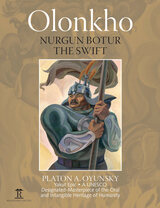 Olonkho: Nurgun Botur the Swift
Platon Oyunski
Amsterdam University Press, 2015 Olonkho is the general name for the entire Yakut heroic epic that consists of many long legends – one of the longest being ‘Nurgun Botur the Swift’ consisting of some 36,000 lines of verse, published here. Like Homer’s Iliad and Odyssey, the Finnish Kalevala, the Buryat Geser, and the Kirghiz Manas, the Yakut Olonkho is an epic of a very ancient origin dating back to the period – possibly as early as the eighth or ninth centuries – when the ancestors of the present-day Yakut peoples lived on their former homeland and closely communicated with the Turkic and Mongolian peoples living in the Altay and Sayan regions. As with all Olonkho stories the hero – in this story Nurgun Botur the Swift – and his tribe are heaven-born, hence his people are referred to as ‘Aiyy kin’ (the deity’s relatives). Naturally, too, on account of his vital role (in saving his people from destruction and oblivion by evil, many-legged, fire-breathing, one-armed, one legged Cyclops-type monsters – the Devil’s relatives representing all possible sins), he is depicted not only as strong, but also a handsome, remarkably athletic and incredibly brave and well-built man ‘as swift as an arrow’, but also with an uncontrollable temper when required.
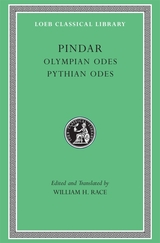 Olympian Odes. Pythian Odes
Pindar
Harvard University Press, 1997 The preeminent lyric poet of ancient Greece.
Of the Greek lyric poets, Pindar (ca. 518–438 BC) was “by far the greatest for the magnificence of his inspiration” in Quintilian’s view; Horace judged him “sure to win Apollo’s laurels.” The esteem of the ancients may help explain why a good portion of his work was carefully preserved. Most of the Greek lyric poets come down to us only in bits and pieces, but nearly a quarter of Pindar’s poems survive complete. William H. Race now brings us, in two volumes, a new edition and translation of the four books of victory odes, along with surviving fragments of Pindar’s other poems.
Like Simonides and Bacchylides, Pindar wrote elaborate odes in honor of prize-winning athletes for public performance by singers, dancers, and musicians. His forty-five victory odes celebrate triumphs in athletic contests at the four great Panhellenic festivals: the Olympic, Pythian (at Delphi), Nemean, and Isthmian games. In these complex poems, Pindar commemorates the achievement of athletes and powerful rulers against the backdrop of divine favor, human failure, heroic legend, and the moral ideals of aristocratic Greek society. Readers have long savored them for their rich poetic language and imagery, moral maxims, and vivid portrayals of sacred myths.
Race provides brief introductions to each ode and full explanatory footnotes, offering the reader invaluable guidance to these often difficult poems. His Loeb Pindar also contains a helpfully annotated edition and translation of significant fragments, including hymns, paeans, dithyrambs, maiden songs, and dirges.
Olympic Butter Gold: Poems
Jonathan Moody
Northwestern University Press, 2015 Jonathan Moody grew up during the Golden Ages of hip-hop and listened to rap that was as adventurous and diverse as his military upbringing. When rap’s Golden Ages expired, the music’s innovativeness and variety diminished. Moody’s second book, Olympic Butter Gold, winner of the 2014 Cave Canem Northwestern University Press Poetry Prize, responds to Chuck D’s claim that "if there was a HIP-HOP or Rap Olympics, I really don’t think the United States would get Gold, Silver or Brass." From the poem "Opening Ceremony," in the voice of a heroin addict struggling to use Lady Liberty’s torch to cook "The American Dream," to "Dear 2Pac," an autobiographical account of teaching Tupac Shakur’s poetry to engage high school students indifferent to literature, Moody shares a worldview that is simultaneously apocalyptic and promising.
 Olympic Dreams: China and Sports, 1895–2008
Xu Guoqi
Harvard University Press, 2008 Already the world has seen the political, economic, and cultural significance of hosting the 2008 Olympics in Beijing—in policies instituted and altered, positions softened, projects undertaken. But will the Olympics make a lasting difference? This book approaches questions about the nature and future of China through the lens of sports—particularly as sports finds its utmost international expression in the Olympics.
Drawing on newly available archival sources to analyze a hundred-year perspective on sports in China, Olympic Dreams explores why the country became obsessed with Western sports at the turn of the twentieth century, and how it relates to China’s search for a national and international identity. Through case studies of ping-pong diplomacy and the Chinese handling of various sporting events, the book offers unexpected details and unusual insight into the patterns and processes of China’s foreign policymaking—insights that will help readers understand China’s interactions with the rest of the world.
Among the questions Xu Guoqi brings to the fore are: Why did Mao Zedong choose competitive ping-pong to manipulate world politics? How did the two-China issue nearly kill the 1976 Montreal Olympic Games? And why do the 2008 Olympics present Beijing with unprecedented dangers and opportunities? In exploring these questions, Xu brilliantly articulates a fresh and surprising perspective on China as an international sport superpower as well as a new “sick man of East Asia.” In Olympic Dreams, he presents an eloquent argument that in the deeply unsettled China of today, sport, as a focus of popular interest, has the capacity to bring about major social changes.
Olympic-Caliber Cybersecurity: Lessons for Safeguarding the 2020 Games and Other Major Events
Cynthia Dion-Schwarz
RAND Corporation, 2018 Understanding the cybersecurity threat landscape is critical to mitigating threats, apportioning limited resources, and hosting a resilient, safe, and secure Olympic Games. To support the security goals of Tokyo 2020, this report characterizes the cybersecurity threats that are likely to pose a risk to the games, visualizes a threat actor typology, and presents a series of policy options to guide cybersecurity planning.
The Olympics: A History of the Modern Games
Allen Guttmann
University of Illinois Press, 1992 The classic account of the modern Olympic movement
This second edition of Guttmann's critically acclaimed history discusses the intended and actual effects of the modern Olympic Games from 1896 to 2000. The glories and fiascoes, the triumphs and tragedies--Guttmann weaves them all into a vivid and entertaining social history. As Guttmann shows, politics has always been one of the Olympics' major events. He also delves into the colorful history of the athletics, from the Paris marathon course that invited French runners to take shortcuts to the odyssey of Egyptian gym teacher Youssef Nagui Assad, who made three different Olympic teams only to be recalled home each time due to boycotts. Guttmann also provides insight into the byzantine maneuvering involved in site selection, as well as little known facts about the Games' history and figures like longtime Olympics czar Avery Brundage.
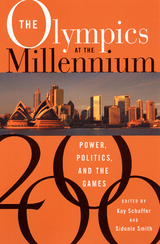 The Olympics at the Millennium: Power, Politics, and the Games
Edited by Kay Schaffer
Rutgers University Press, 2000 The Olympics thrill the world with spectacle and drama. They also carry a cultural and social significance that goes beyond the stadium, athletes, and fans. The Games are arenas in which individual and team athletic achievement intersect with the politics of national identity in a global context.
The Olympics at the Millennium offers groundbreaking essays that explore the cultural politics of the Games. The contributors investigate such topics as the emergence of women athletes as cultural commodities, the orchestrated spectacles of the opening and closing ceremonies, and the alternative sport culture offered via the Gay Games. Unforgettable events and decisions are discussed: Native American athlete Jim Thorpe winning—and losing—his two gold medals in 1912. Why America was one of the few countries to actually send Jewish athletes to the “Nazi Olympics.” The disqualification of champion Ewa Klobukowska from competing as a woman, due to chromosomal testing in 1967.
With the 2000 Sydney Games imminent, several essays address concerns with which every host country must contend, such as the threat of terrorism. Highlighting the difficult issues of racism and nationalism, another article explores the efforts of this country’s aboriginal people to define a role for themselves in the 2000 Games, as they struggle with ongoing discrimination. And with the world watching, Sydney faces profound pressure to implement a successful Olympics, as a matter of national pride.
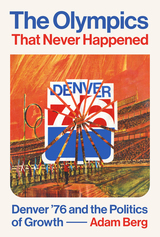 The Olympics that Never Happened: Denver '76 and the Politics of Growth
Adam Berg
University of Texas Press, 2023 A look back at how powerful politicians, business leaders, and a diverse cast of activists used a thwarted Olympics to shape the state of Colorado and the city of Denver.
If you don’t recall the 1976 Denver Olympic Games, it’s because they never happened. The Mile-High City won the right to host the winter games and then was forced by Colorado citizens to back away from its successful Olympic bid through a statewide ballot initiative. Adam Berg details the powerful Colorado regime that gained the games for Denver and the grassroots activism that brought down its Olympic dreams, and he explores the legacy of this milestone moment for the games and politics in the United States. The ink was hardly dry on Denver’s host agreement when Mexican American and African American urbanites, white middle-class environmentalists, and fiscally concerned local politicians realized opposition to the Olympics provided them new political openings. The Olympics quickly became a platform for taking stands on a range of issues, from conservation to urban livability to the very idea of growth, which for decades had been unquestioned in Colorado. The Olympics That Never Happened argues that hostility to the Olympics galvanized and empowered diverse citizens in a major US city, with long-term ramifications for Colorado and political activism elsewhere. The Olympics themselves were changed forever, compelling organizers to take seriously competing interests from subgroups within their communities.
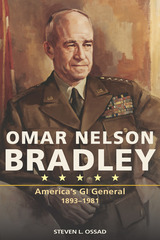 Omar Nelson Bradley: America's GI General, 1893-1981
Steven L. Ossad
University of Missouri Press, 2017 When Omar Nelson Bradley began his military career more than a century ago, the army rode horses into combat and had less than 200,000 men. No one had heard of mustard gas. At the height of his career, Bradley (known as “Brad” and “The GI’s General”) led 1.23 million men as commander of 12 Army Group in the Western Front to bring an end to World War II.
Omar Nelson Bradley was the youngest and last of nine men to earn five-star rank and the only army officer so honored after World War II. This new biography by Steven L. Ossad gives an account of Bradley’s formative years, his decorated career, and his postwar life.
Bradley’s decisions shaped the five Northwest European Campaigns from the D-Day landings to VE Day. As the man who successfully led more Americans in battle than any other in our history, his long-term importance would seem assured. Yet his name is not discussed often in the classrooms of either civilian or military academies, either as a fount of tactical or operational lessons learned, or a source of inspiration for leadership exercised at Corps, Army, Group, Army Chief, or Joint Chiefs of Staff levels.
The Bradley image was tailor-made for the quintessential homespun American heroic ideal and was considered by many to be a simple, humble country boy who rose to the pinnacle of power through honesty, hard work, loyalty and virtuous behavior. Even though his classmates in both high school and at West Point made remarks about his looks, and Bradley was always self-conscious about smiling because of an accident involving his teeth, he went on to command 12 Army Group, the largest body of American fighting men under a single general.
Bradley’s postwar career as administrator of the original GI Bill and first Chairman of the Joint Chiefs of Staff during the Korean War ensures his legacy. These latter contributions, as much as Bradley’s demonstrable World War II leadership, shaped U.S. history and culture in decisive, dramatic, and previously unexamined ways.
Drawing on primary sources such as those at West Point, Army War College and Imperial War Museum, this book focuses on key decisions, often through the eyes of eyewitness and diarist, British liaison officer Major Thomas Bigland. The challenges our nation faces sound familiar to his problems: fighting ideologically-driven enemies across the globe, coordinating global strategy with allies, and providing care and benefits for our veterans.
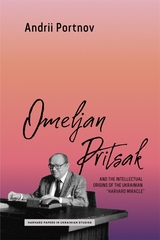 Omeljan Pritsak and the Intellectual Origins of the Ukrainian "Harvard Miracle"
Andrii Portnov
Harvard University Press Omeljan Pritsak and the Intellectual Origins of the Ukrainian “Harvard Miracle” is the first English-language intellectual biography of Omeljan Pritsak, the co-founder of the Harvard Ukrainian Research Institute and the first professor of Ukrainian history at Harvard. Andrii Portnov places Pritsak’s life and legacy in the context of Ukrainian and world historiography and illuminates the development of his scholarly interests, which emerged in interwar Poland and developed through the Sovietization of Western Ukraine and the perturbations of World War II. His scholarship ranged from German Oriental Studies in the 1940s and 1950s to North American Slavic studies to the international studies of the origins of Rus´. Pritsak’s trajectory unfolds as he faces the challenges of establishing the field of Ukrainian studies in North America while engaging with influential scholars such as Dmytro Čyževskyj, Roman Jakobson, Ivan Krypiakevych, Oleksandr Ohloblyn, and Natalia Polonska-Vasylenko.
Based on unique materials Portnov uncovered in several German archives, this concise study serves as an invitation to reassess the intellectual history of Ukrainian history. Containing unique, previously unpublished photographs from Pritsak’s personal collection at the Kyiv-Mohyla Academy, this book sheds light on the life and work of the enigmatic figure of Omeljan Pritsak—one of the most prominent, controversial, and multifaceted historians of Ukraine, Central Europe, and the Turko-Osmanic and Mongol worlds.
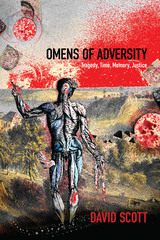 Omens of Adversity: Tragedy, Time, Memory, Justice
David Scott
Duke University Press, 2014 Omens of Adversity is a profound critique of the experience of postcolonial, postsocialist temporality. The case study at its core is the demise of the Grenada Revolution (1979–1983), and the repercussions of its collapse. In the Anglophone Caribbean, the Grenada Revolution represented both the possibility of a break from colonial and neocolonial oppression, and hope for egalitarian change and social and political justice. The Revolution's collapse in 1983 was devastating to a revolutionary generation. In hindsight, its demise signaled the end of an era of revolutionary socialist possibility. Omens of Adversity is not a history of the Revolution or its fallout. Instead, by examining related texts and phenomena, David Scott engages with broader, enduring issues of political action and tragedy, generations and memory, liberalism and transitional justice, and the possibility of forgiveness. Ultimately, Scott argues that the palpable sense of the neoliberal present as time stalled, without hope for emancipatory futures, has had far-reaching effects on how we think about the nature of political action and justice.
Omer: A Counting
Rabbi Karyn D. Kedar
Central Conference of American Rabbis, 2014 The counting of the Omer begins with the escape from enslavement to the wandering path of freedom, leading to a mystical encounter with God, Sinai, and Torah. This volume, beginning with its informative contextual introduction, provides a spiritual guide for a personal journey through the Omer toward meaningful and purposeful living. Beautiful and evocative readings for each day matched with the daily Omer blessing, offer a transformative path from Passover to Shavuot.
 Omertà: A Book of Silences
Andrea Tompa
Seagull Books, 2024 A rich, layered narrative that explores the indomitable human spirit against the backdrop of Romania’s complex history in the 1950s and ’60s.
A rural area not far from the city of Cluj-Napoca, a former Hungarian province that has been part of Romania since 1920. World War II has ended and the region is under the firm clasp of Stalinist collectivization. In the atmospheric village of Kolozsvár, Omertà unfolds a riveting tale through four poignant perspectives, each peeling back the layers of its central characters’ lives against the backdrop of a tumultuous Eastern Europe in the mid-twentieth century.
Kali, a peasant woman, escapes an abusive marriage to embark on a transformative journey to Kolozsvár, seeking refuge and purpose. She is employed as a maid by Vilmos, a reluctant Communist Party member with an unwavering dedication to his garden. As Vilmos’s botanical brilliance attracts the state’s attention, a clash between personal desires and political obligations ensues. Annush, the third narrator, a lovestruck teenager, becomes entangled in a complex web of emotions, grappling with love, loss, and the evolving landscape of her homeland. The tale deepens with Eleonora, who, seeking solace in a monastery, becomes a casualty of political purges and the suppression of religious faith under Romania’s oppressive regime.
In this epic novel, Romanian-born Hungarian author Andrea Tompa skillfully intertwines these tales, shedding light on the injustices and corruption of a regime that sought to extinguish cultural identities. The lives of Kali, Vilmos, Annush, and Eleonora weave a tapestry of love, resilience, the virtue of roses, and the quiet strength required to endure in the face of political turmoil.
Omitting All That Is Usually Said
Robin Caton
Omnidawn, 2024 Poems that consider the complexities of human life and the ways that we perceive reality.
In Omitting All That is Usually Said, Robin Caton explores the nature of light, form, language, meaning, and thought, alongside the complexity of their interwoven relationships. Caton interrogates the workings of the human mind and explores the way we integrate disparate perceptions. Caton questions whether we can be certain that things really exist and that all we experience isn’t simply a play of light and shadow. She considers how we live with all the limitations and emotional turmoil imbedded in humanity, while also maintaining a sense of something we call perfection. The poems of Omitting All That is Usually Said investigate how we might capture the depths of conflicting experiences and lived knowledge in ways that we can comprehend, and they marvel at how we find delight in all of it.
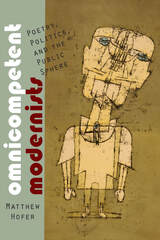 Omnicompetent Modernists: Poetry, Politics, and the Public Sphere
Matthew Hofer
University of Alabama Press, 2022 An innovative exploration of early twentieth-century avant-garde poetry’s relationship to the public sphere
“It is difficult / to get the news from poems / yet men die miserably every day / for lack / of what is found there,” as the poet William Carlos Williams memorably declared. In Omnicompetent Modernists: Poetry, Politics, and the Public Sphere, Matthew Hofer examines, through a multilayered literary critique of interwar modernist poetry, what it might mean to get the news, and more, from a poet.
Using pragmatist ideas about the public sphere as a tool, Hofer reveals how Langston Hughes, Ezra Pound, and Mina Loy sought to use literature to both express and enable thought. In Hughes, Pound, and Loy, Hofer attends to poets whose work vigorously imagined possible new relationships between language, thinking, and public society. Each poet had different goals and used different methods, but all found both inspiration and encouragement in popular political theory. Hughes advocated for a more just vision of color and class in the United States. Pound sought to condemn those whom he associated with public harm, linguistically, socially, economically, and politically. Loy championed the “psycho-democratic” representation of women, in both public and private life.
Although Hughes, Pound, and Loy are rarely considered together, what unites these three writers is how each reconceived the public realm, and revolutionized aesthetic form to articulate those visions. Hofer combines sharp intellectual historiography with rigorous literary criticism and the result is a study that reinvigorates both the poems and poets under consideration and speaks to the immense power of language in manipulating public opinion—with pertinent implications for the politics of the present.
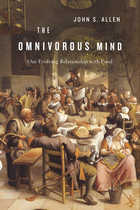 The Omnivorous Mind: Our Evolving Relationship with Food
John S. Allen
Harvard University Press, 2012 In this gustatory tour of human history, John S. Allen demonstrates that the everyday activity of eating offers deep insights into human beings’ biological and cultural heritage.
We humans eat a wide array of plants and animals, but unlike other omnivores we eat with our minds as much as our stomachs. This thoughtful relationship with food is part of what makes us a unique species, and makes culinary cultures diverse. Not even our closest primate relatives think about food in the way Homo sapiens does. We are superomnivores whose palates reflect the natural history of our species.
Drawing on the work of food historians and chefs, anthropologists and neuroscientists, Allen starts out with the diets of our earliest ancestors, explores cooking’s role in our evolving brain, and moves on to the preoccupations of contemporary foodies. The Omnivorous Mind delivers insights into food aversions and cravings, our compulsive need to label foods as good or bad, dietary deviation from “healthy” food pyramids, and cross-cultural attitudes toward eating (with the French, bien sûr, exemplifying the pursuit of gastronomic pleasure).
To explain, for example, the worldwide popularity of crispy foods, Allen considers first the food habits of our insect-eating relatives. He also suggests that the sound of crunch may stave off dietary boredom by adding variety to sensory experience. Or perhaps fried foods, which we think of as bad for us, interject a frisson of illicit pleasure. When it comes to eating, Allen shows, there’s no one way to account for taste.
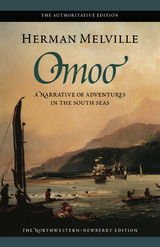 Omoo: A Narrative of Adventures in the South Seas, Volume Two
Herman Melville
Northwestern University Press, 1999 Melville's second book, Omoo, begins where his first book, Typee, left off. As the author said, "It embraces adventures in the South Seas (of a totally different character from 'Typee') and includes an eventful cruise in an English Colonial Whaleman (a Sydney Ship) and a comical residence on the island of Tahiti." The popular success of his first novel encouraged Melville to write a sequel, hoping it would be "a fitting successor." Typee describes Polynesian life in its "primitive" state, while Omoo represents it as affected by non-native influences.
Whitman praised its "good-natured style." But many reviewers doubted Melville's veracity, and some objected to his "raciness" and "indecencies." Some also denounced his criticism of missionary endeavors, for his attacks on missionaries were more polemical than those undertaken in the earlier book. Omoo, however, influenced later visitors to Tahiti such as Pierre Loti, Henry Adams, John La Farge, and Jack London; it was the book that sent Robert Louis Stevenson to the South Seas.
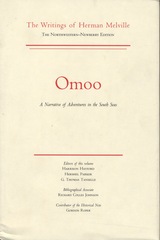 Omoo: A Narrative of Adventures in the South Seas, Volume Two, Scholarly Edition
Herman Melville
Northwestern University Press, 1968 Melville's second book, Omoo, begins where his first book, Typee, left off. As the author said, "It embraces adventures in the South Seas (of a totally different character from 'Typee') and includes an eventful cruise in an English Colonial Whaleman (a Sydney Ship) and a comical residence on the island of Tahiti." The popular success of his first novel encouraged Melville to write a sequel, hoping it would be "a fitting successor." Typee describes Polynesian life in its "primitive" state, while Omoo represents it as affected by non-native influences.
This scholarly edition aims to present a text as close to the author's intention as surviving evidence permits. Based on collations of all editions publishing during Melville's lifetime, it incorporates author corrections and many emendations made by the present editors. This edition of Omoo is an Approved Text of the Center for Editions of American Authors (Modern Language Association of America).
On "A Being" and "An Essence" (De ente et essentia)
Thomas Aquinas
Catholic University of America Press, 2026 The In De Ente et Essentia is a polemical work of a brilliant young Dominican professor, Thomas de Vio Cajetan (1469-1534), eager to defend the philosophical legacy of Thomas Aquinas. Drawing from the full range of St. Thomas's writings, the work offers a coherent Thomistic metaphysical theory set against the rival Scotist and Averroist positions defended at Italian Universities in the 1490s. This new English translation is an invitation to philosophers and historians to re-engage with Cajetan, with his 15th Century rivals, and, of course, with Thomas Aquinas himself. It is also a challenge and inspiration to do metaphysics through dialectical engagement with the greatest rival theories of our own time and place.
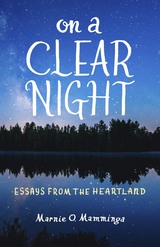 On a Clear Night: Essays from the Heartland
Marnie O. Mamminga
Wisconsin Historical Society Press, 2017 In this dazzling collection, best-selling author Marnie O. Mamminga details the common experiences that unite those of us who live, love, and work in the heart of the country. With insight and humor, Mamminga chronicles a wide range of small but significant everyday moments: the anxiety of taking a teenager out for driving lessons, the nostalgic pleasure of watching the Cubs at Wrigley Field, the heartache of moving an aging parent into a nursing home, and the quiet bliss of sitting on a cabin’s porch, listening for loons and wolves under the Northwoods’ starry sky.
Combining elements of the personal and the universal, these essays chart the passage of time from childhood to adulthood, sickness to health, working life to retirement, parenthood to grandparenthood, and everything in between. These sharply observed vignettes highlight the importance of taking time to appreciate the ordinary occurrences that profoundly shape our lives and the places we call home.
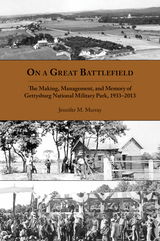 On a Great Battlefield: The Making, Management, and Memory of Gettysburg National Military Park, 1933–2013
Jennifer M. Murray
University of Tennessee Press, 2014
Of the more than seventy sites associated with the Civil War era that the National Park
Service manages, none hold more national appeal and recognition than Gettysburg National
Military Park. Welcoming more than one million visitors annually from across the
nation and around the world, the National Park Service at Gettysburg holds the enormous
responsibility of preserving the war’s “hallowed ground” and educating the public, not
only on the battle, but also about the Civil War as the nation’s defining moment. Although
historians and enthusiasts continually add to the shelves of Gettysburg scholarship, they
have paid only minimal attention to the battlefield itself and the process of preserving,
interpreting, and remembering the bloodiest battle of the Civil War. In On a Great Battlefield,
Jennifer M. Murray provides a critical perspective to Gettysburg historiography by
offering an in-depth exploration of the national military park and how the Gettysburg
battlefield has evolved since the National Park Service acquired the site in August 1933.
As Murray reveals, the history of the Gettysburg battlefield underscores the complexity
of preserving and interpreting a historic landscape. After a short overview of early
efforts to preserve the battlefield by the Gettysburg Battlefield Memorial Association
(1864–1895) and the United States War Department (1895–1933), Murray chronicles the
administration of the National Park Service and the multitude of external factors—including
the Great Depression, the New Deal, World War II, the Civil War Centennial, and
recent sesquicentennial celebrations—that influenced operations and molded Americans’
understanding of the battle and its history. Haphazard landscape practices, promotion of
tourism, encouragement of recreational pursuits, ill-defined policies of preserving cultural
resources, and the inevitable turnover of administrators guided by very different
preservation values regularly influenced the direction of the park and the presentation
of the Civil War’s popular memory. By highlighting the complicated nexus between preservation,
tourism, popular culture, interpretation, and memory, On a Great Battlefield
provides a unique perspective on the Mecca of Civil War landscapes.
Jennifer M. Murray, assistant professor of history at the University of Virginia’s College
at Wise, is the author of The Civil War Begins. Her articles have appeared in Civil War
History, Civil War Times, and Civil War Times Illustrated.
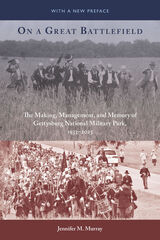 On a Great Battlefield: The Making, Management, and Memory of Gettysburg National Military Park, 1933–2013
Jennifer M. Murray
University of Tennessee Press, 2023 Of the more than seventy sites associated with the Civil War era that the National Park Service manages, none hold more national appeal and recognition than Gettysburg National Military Park. Welcoming more than one million visitors annually from across the nation and around the world, the National Park Service at Gettysburg holds the enormous responsibility of preserving the war’s “hallowed ground” and educating the public, not only on the battle, but also about the Civil War as the nation’s defining moment. Although historians and enthusiasts continually add to the shelves of Gettysburg scholarship, they have paid only minimal attention to the battlefield itself and the process of preserving, interpreting, and remembering the bloodiest battle of the Civil War. In On a Great Battlefield, Jennifer M. Murray provides a critical perspective to Gettysburg historiography by offering an in-depth exploration of the national military park and how the Gettysburg battlefield has evolved since the National Park Service acquired the site in August 1933.
As Murray reveals, the history of the Gettysburg battlefield underscores the complexity of preserving and interpreting a historic landscape. After a short overview of early efforts to preserve the battlefield by the Gettysburg Battlefield Memorial Association (1864–1895) and the United States War Department (1895–1933), Murray chronicles the administration of the National Park Service and the multitude of external factors—including the Great Depression, the New Deal, World War II, the Civil War Centennial, and recent sesquicentennial celebrations—that influenced operations and molded Americans’ understanding of the battle and its history. Haphazard landscape practices, promotion of tourism, encouragement of recreational pursuits, ill-defined policies of preserving cultural resources, and the inevitable turnover of administrators guided by very different preservation values regularly influenced the direction of the park and the presentation of the Civil War’s popular memory. By highlighting the complicated nexus between preservation, tourism, popular culture, interpretation, and memory, On a Great Battlefield provides a unique perspective on the Mecca of Civil War landscapes.
Jennifer M. Murray, assistant professor of history at the University of Virginia’s College at Wise, is the author of The Civil War Begins. Her articles have appeared in Civil War History, Civil War Times, and Civil War Times Illustrated.
 On a Great Battlefield: The Making, Management, and Memory of Gettysburg National Military Park, 1933–2013
Jennifer M. Murray
University of Tennessee Press, 2014 Of the more than seventy sites associated with the Civil War era that the National Park Service manages, none hold more national appeal and recognition than Gettysburg National Military Park. Welcoming more than one million visitors annually from across the nation and around the world, the National Park Service at Gettysburg holds the enormous responsibility of preserving the war’s “hallowed ground” and educating the public, not only on the battle, but also about the Civil War as the nation’s defining moment. Although historians and enthusiasts continually add to the shelves of Gettysburg scholarship, they have paid only minimal attention to the battlefield itself and the process of preserving, interpreting, and remembering the bloodiest battle of the Civil War. In On a Great Battlefield, Jennifer M. Murray provides a critical perspective to Gettysburg historiography by offering an in-depth exploration of the national military park and how the Gettysburg battlefield has evolved since the National Park Service acquired the site in August 1933.
As Murray reveals, the history of the Gettysburg battlefield underscores the complexity of preserving and interpreting a historic landscape. After a short overview of early efforts to preserve the battlefield by the Gettysburg Battlefield Memorial Association (1864–1895) and the United States War Department (1895–1933), Murray chronicles the administration of the National Park Service and the multitude of external factors—including the Great Depression, the New Deal, World War II, the Civil War Centennial, and recent sesquicentennial celebrations—that influenced operations and molded Americans’ understanding of the battle and its history. Haphazard landscape practices, promotion of tourism, encouragement of recreational pursuits, ill-defined policies of preserving cultural resources, and the inevitable turnover of administrators guided by very different preservation values regularly influenced the direction of the park and the presentation of the Civil War’s popular memory. By highlighting the complicated nexus between preservation, tourism, popular culture, interpretation, and memory, On a Great Battlefield provides a unique perspective on the Mecca of Civil War landscapes.
Jennifer M. Murray, assistant professor of history at the University of Virginia’s College at Wise, is the author of The Civil War Begins. Her articles have appeared in Civil War History, Civil War Times, and Civil War Times Illustrated.
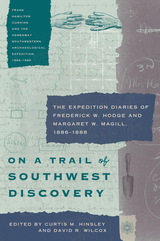 On a Trail of Southwest Discovery: The Expedition Diaries of Frederick W. Hodge and Margaret W. Magill, 1886–1888
Curtis M. Hinsley and David R. Wilcox
University of Arizona Press, 2024 The Hemenway Southwestern Archaeological Expedition (1886–1889), directed by Frank Hamilton Cushing, was the first privately funded expedition to the American Southwest. This volume examines the expedition through the diaries of two participants who fell in love on the expedition: the field secretary, Fred Hodge, and the expedition artist, Margaret Magill—who was also Cushing’s sister-in-law. It also presents the first biographical treatment of Hodge, who became a major figure in early twentieth-century anthropology. The book’s first two sections chronicle the field operations of the expedition, while the third describes the long anthropological career of Hodge after the end of the expedition. Through deep research in primary and secondary sources and archival materials, the book details both the daily operations of the expedition and the growing romantic relationship between Hodge and Magill. For those interested in settlements in early Arizona and Zuni Pueblo, the book provides rare insights into the lives of both men and women, offering an intimate view of an enterprise that is now considered a foundation of Hohokam archaeology—even as it reveals deep love and persistent personal conflicts.
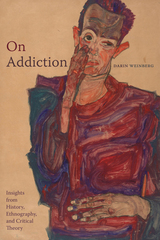 On Addiction: Insights from History, Ethnography, and Critical Theory
Darin Weinberg
Duke University Press, 2024 Mainstream addiction science sees addiction either as a biomedical disease that renders one incapable of self-control or as a voluntary practice engaged in freely. In On Addiction, Darin Weinberg shows how this dynamic is deeply influenced by a series of binaries (free will/determinism, mind/body, objectivity/subjectivity) that hinder our understanding of addiction. Here, he offers a new theorization of addiction in which he breaks down these contradictions and incompatibilities, calling into question the taken-for-granted distinction between the “biological” and the “social.” To the extent that it is understood as a loss of self-control over one’s behavior, addiction, Weinberg contends, requires a supple theoretical framework that provides for movements into and out of self-control, for the social and natural processes that influence these movements, for the historical contexts within which they occur, and for the ethical ramifications of taking them seriously. To create this framework, Weinberg brings together history, ethnography, and critical theory as well as the clinical and social sciences. In this way, Weinberg takes a more holistic approach to examining the fundamental nature and ethics of addiction.
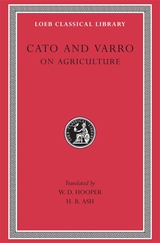 On Agriculture
Cato and Varro
Harvard University Press Cultivated farming advice.
Cato (M. Porcius Cato) the elder (234–149 BC) of Tusculum, statesman and soldier, was the first important writer in Latin prose. His speeches, works on jurisprudence and the art of war, his precepts to his son on various subjects, and his great historical work on Rome and Italy are lost. But we have his De Agricultura; terse, severely wise, grimly humorous, it gives rules in various aspects of a farmer’s economy, including even medical and cooking recipes, and reveals interesting details of domestic life.
Varro (M. Terentius) of Reate (116–27 BC), renowned for his vast learning, was an antiquarian, historian, philologist, student of science, agriculturist, and poet. He was a republican who was reconciled to Julius Caesar and was marked out by him to supervise an intended national library. Of Varro’s more than seventy works involving hundreds of volumes we have only one on agriculture and country affairs (Rerum Rusticarum) and part of his work on the Latin language (De Lingua Latina; LCL 333, 334), though we know much about his Satires. Each of the three books on country affairs begins with an effective mise en scene and uses dialogue. The first book deals with agriculture and farm management, the second with sheep and oxen, the third with poultry and the keeping of other animals large and small, including bees and fish ponds. There are lively interludes and a graphic background of political events.
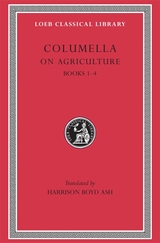 On Agriculture, Volume I: Books 1–4
Columella
Harvard University Press A Roman farmer on farming.
Columella (Lucius Iunius Moderatus) of Gades (Cadiz) lived in the reigns of the first emperors to about AD 70. He moved early in life to Italy where he owned farms and lived near Rome. It is probable that he did military service in Syria and Cilicia and that he died at Tarentum.
Columella’s On Agriculture (De re rustica) is the most comprehensive, systematic, and detailed of Roman agricultural works. Book 1 covers choice of farming site; water supply; buildings; staff. 2: Plowing; fertilizing; care of crops. 3–5: Cultivation, grafting, and pruning of fruit trees, vines, and olives. 6: Acquisition, breeding, and rearing of oxen, horses, and mules; veterinary medicine. 7: Sheep, goats, pigs, and dogs. 8: Poultry; fish ponds. 9: Bee-keeping. 10 (in hexameter poetry): Gardening. 11: Duties of the overseer of a farm; calendar for farm work; more on gardening. 12: Duties of the overseer’s wife; manufacture of wines; pickling; preserving. There is also a separate treatise, Trees (De arboribus), on vines and olives and various trees, perhaps part of an otherwise lost work written before On Agriculture.
The Loeb Classical Library edition of Columella is in three volumes.
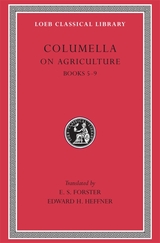 On Agriculture, Volume II: Books 5–9
Columella
Harvard University Press A Roman farmer on farming.
Columella (Lucius Iunius Moderatus) of Gades (Cadiz) lived in the reigns of the first emperors to about AD 70. He moved early in life to Italy where he owned farms and lived near Rome. It is probable that he did military service in Syria and Cilicia and that he died at Tarentum.
Columella’s On Agriculture (De re rustica) is the most comprehensive, systematic, and detailed of Roman agricultural works. Book 1 covers choice of farming site; water supply; buildings; staff. 2: Plowing; fertilizing; care of crops. 3–5: Cultivation, grafting, and pruning of fruit trees, vines, and olives. 6: Acquisition, breeding, and rearing of oxen, horses, and mules; veterinary medicine. 7: Sheep, goats, pigs, and dogs. 8: Poultry; fish ponds. 9: Bee-keeping. 10 (in hexameter poetry): Gardening. 11: Duties of the overseer of a farm; calendar for farm work; more on gardening. 12: Duties of the overseer’s wife; manufacture of wines; pickling; preserving. There is also a separate treatise, Trees (De arboribus), on vines and olives and various trees, perhaps part of an otherwise lost work written before On Agriculture.
The Loeb Classical Library edition of Columella is in three volumes.
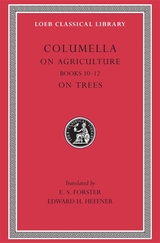 On Agriculture, Volume III: Books 10–12. On Trees
Columella
Harvard University Press A Roman farmer on farming.
Columella (Lucius Iunius Moderatus) of Gades (Cadiz) lived in the reigns of the first emperors to about AD 70. He moved early in life to Italy where he owned farms and lived near Rome. It is probable that he did military service in Syria and Cilicia and that he died at Tarentum.
Columella’s On Agriculture (De re rustica) is the most comprehensive, systematic, and detailed of Roman agricultural works. Book 1 covers choice of farming site; water supply; buildings; staff. 2: Plowing; fertilizing; care of crops. 3–5: Cultivation, grafting, and pruning of fruit trees, vines, and olives. 6: Acquisition, breeding, and rearing of oxen, horses, and mules; veterinary medicine. 7: Sheep, goats, pigs, and dogs. 8: Poultry; fish ponds. 9: Bee-keeping. 10 (in hexameter poetry): Gardening. 11: Duties of the overseer of a farm; calendar for farm work; more on gardening. 12: Duties of the overseer’s wife; manufacture of wines; pickling; preserving. There is also a separate treatise, Trees (De arboribus), on vines and olives and various trees, perhaps part of an otherwise lost work written before On Agriculture.
The Loeb Classical Library edition of Columella is in three volumes.
On American Fiction
Jean-Paul Sartre
Seagull Books, 2021 A brief, powerful analysis of three major twentieth-century writers: Dos Passos, Nabokov, and Faulkner.
Iconic French novelist, playwright, and essayist Jean-Paul Sartre is widely recognized as one of the most important philosophers of the twentieth century, and his work has remained relevant and thought-provoking through the decades. The Seagull Sartre Library now presents some of his most incisive philosophical, cultural, and literary critical essays in twelve newly designed and affordable editions.
Sartre’s engagement with the literature of his day extended well beyond the works of his French contemporaries. This short volume testifies to his astonishing grasp of the nuances of American fiction, as he analyzes three of the most important twentieth-century writers: John Dos Passos, Vladimir Nabokov, and William Faulkner, whose “humanism,” writes Sartre, “is the only acceptable sort.”
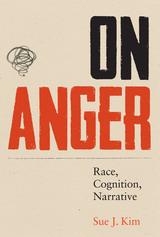 On Anger: Race, Cognition, Narrative
By Sue Kim
University of Texas Press, 2013 Anger is an emotion that affects everyone regardless of culture, class, race, or gender—but at the same time, being angry always results from the circumstances in which people find themselves. In On Anger, Sue J. Kim opens a stimulating dialogue between cognitive studies and cultural studies to argue that anger is always socially and historically constructed and complexly ideological, and that the predominant individualistic conceptions of anger are insufficient to explain its collective, structural, and historical nature. On Anger examines the dynamics of racial anger in global late capitalism, bringing into conversation work on political anger in ethnic, postcolonial, and cultural studies with recent studies on emotion in cognitive studies. Kim uses a variety of literary and media texts to show how narratives serve as a means of reflecting on experiences of anger and also how we think about anger—its triggers, its deeper causes, its wrongness or rightness. The narratives she studies include the film Crash, Maxine Hong Kingston’s The Woman Warrior, Tsitsi Dangarembga’s Nervous Conditions and The Book of Not, Ngugi wa Thiong’o’s Devil on the Cross and Wizard of the Crow, and the HBO series The Wire. Kim concludes by distinguishing frustration and outrage from anger through a consideration of Stéphane Hessel’s call to arms, Indignez-vous! One of the few works that focuses on both anger and race, On Anger demonstrates that race—including whiteness—is central to our conceptions and experiences of anger.
 On Animals, Volume I: Books 1–5
Aelian
Harvard University Press Occasionally zany zoological lore.
Aelian (Claudius Aelianus), a Roman born ca. AD 170 at Praeneste, was a pupil of the rhetorician Pausanias of Caesarea, and taught and practiced rhetoric. Expert in Attic Greek, he became a serious scholar and studied history under the patronage of the Roman empress Julia Domna. He apparently spent all his life in Italy where he died after AD 230.
Aelian’s On the Characteristics of Animals, in 17 books, is a collection of facts and beliefs concerning the habits of animals drawn from Greek authors and some personal observation. Fact, fancy, legend, stories, and gossip all play their part in a narrative that is meant to entertain. If there is any ethical motive, it is that the virtues of untaught yet reasoning animals can be a lesson to thoughtless and selfish mankind. The Loeb Classical Library edition of this work is in three volumes.
The Historical Miscellany (LCL 486) is of similar nature. In 14 books, it consists mainly of historical and biographical anecdotes and retellings of legendary events. Some of Aelian’s material is drawn from authors whose works are lost.
Aelian’s Letters—portraying the affairs and country ways of a series of fictitious writers—offer engaging vignettes of rural life. These are available in LCL 383.
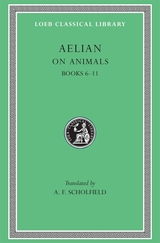 On Animals, Volume II: Books 6–11
Aelian
Harvard University Press Occasionally zany zoological lore.
Aelian (Claudius Aelianus), a Roman born ca. AD 170 at Praeneste, was a pupil of the rhetorician Pausanias of Caesarea, and taught and practiced rhetoric. Expert in Attic Greek, he became a serious scholar and studied history under the patronage of the Roman empress Julia Domna. He apparently spent all his life in Italy where he died after AD 230.
Aelian’s On the Characteristics of Animals, in 17 books, is a collection of facts and beliefs concerning the habits of animals drawn from Greek authors and some personal observation. Fact, fancy, legend, stories, and gossip all play their part in a narrative that is meant to entertain. If there is any ethical motive, it is that the virtues of untaught yet reasoning animals can be a lesson to thoughtless and selfish mankind. The Loeb Classical Library edition of this work is in three volumes.
The Historical Miscellany (LCL 486) is of similar nature. In 14 books, it consists mainly of historical and biographical anecdotes and retellings of legendary events. Some of Aelian’s material is drawn from authors whose works are lost.
Aelian’s Letters—portraying the affairs and country ways of a series of fictitious writers—offer engaging vignettes of rural life. These are available in LCL 383.
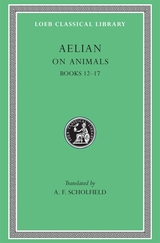 On Animals, Volume III: Books 12–17
Aelian
Harvard University Press Occasionally zany zoological lore.
Aelian (Claudius Aelianus), a Roman born ca. AD 170 at Praeneste, was a pupil of the rhetorician Pausanias of Caesarea, and taught and practiced rhetoric. Expert in Attic Greek, he became a serious scholar and studied history under the patronage of the Roman empress Julia Domna. He apparently spent all his life in Italy where he died after AD 230.
Aelian’s On the Characteristics of Animals, in 17 books, is a collection of facts and beliefs concerning the habits of animals drawn from Greek authors and some personal observation. Fact, fancy, legend, stories, and gossip all play their part in a narrative that is meant to entertain. If there is any ethical motive, it is that the virtues of untaught yet reasoning animals can be a lesson to thoughtless and selfish mankind. The Loeb Classical Library edition of this work is in three volumes.
The Historical Miscellany (LCL 486) is of similar nature. In 14 books, it consists mainly of historical and biographical anecdotes and retellings of legendary events. Some of Aelian’s material is drawn from authors whose works are lost.
Aelian’s Letters—portraying the affairs and country ways of a series of fictitious writers—offer engaging vignettes of rural life. These are available in LCL 383.
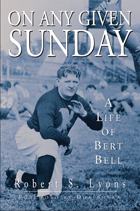 On Any Given Sunday: A Life of Bert Bell
Robert S. Lyons, Foreword by Don Shula
Temple University Press, 2009 Bert Bell, a native of Philadelphia, has been called the most powerful executive figure in the history of professional football. He was responsible for helping to transform the game from a circus sideshow into what has become the most popular spectator sport in America. In On Any Given Sunday, the first biography of this important sports figure, historian Robert Lyons recounts the remarkable story of how de Benneville “Bert” Bell rejected the gentility of a high society lifestyle in favor of the tougher gridiron, and rose to become the founder of the Philadelphia Eagles and Commissioner of the National Football League.
Bell, who arguably saved the league from bankruptcy by conceiving the idea for the annual player draft, later made the historic decision to introduce “sudden death” overtime—a move that propelled professional football into the national consciousness. He coined the phrase “on any given sunday” and negotiated the league’s first national TV contract. Lyons also describes in fascinating detail Bell’s relationships with leading figures ranging from such Philadelphia icons as Walter Annenberg and John B. Kelly to national celebrities and U.S. Presidents. He also provides insight into Bell’s colorful personal life—including his hell-raising early years and his secret marriage to Frances Upton, a golden name in show business.
On Any Given Sunday is being published on the 50th anniversary of Bell’s death.
 On Architecture, Volume I: Books 1–5
Vitruvius
Harvard University Press The Renaissance man avant la lettre.
Vitruvius (Marcus V. Pollio), Roman architect and engineer, studied Greek philosophy and science and gained experience in the course of professional work. He was one of those appointed to be overseers of imperial artillery or military engines, and was architect of at least one unit of buildings for Augustus in the reconstruction of Rome. Late in life and in ill health he completed, sometime before 27 BC, De Architectura which, after its rediscovery in the fifteenth century, was influential enough to be studied by architects from the early Renaissance to recent times.
In On Architecture Vitruvius adds to the tradition of Greek theory and practice the results of his own experience. The contents of this treatise in ten books are as follows. Book 1: Requirements for an architect; town planning; design, cities, aspects; temples. 2: Materials and their treatment. Greek systems. 3: Styles. Forms of Greek temples. Ionic. 4: Styles. Corinthian, Ionic, Doric; Tuscan; altars. 5: Other public buildings (fora, basilicae, theaters, colonnades, baths, harbors). 6: Sites and planning, especially of houses. 7: Construction of pavements, roads, mosaic floors, vaults. Decoration (stucco, wall painting, colors). 8: Hydraulic engineering; water supply; aqueducts. 9: Astronomy. Greek and Roman discoveries; signs of the zodiac, planets, moon phases, constellations, astrology, gnomon, sundials. 10: Machines for war and other purposes.
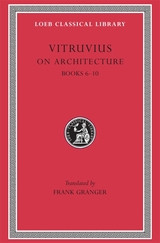 On Architecture, Volume II: Books 6–10
Vitruvius
Harvard University Press The Renaissance man avant la lettre.
Vitruvius (Marcus V. Pollio), Roman architect and engineer, studied Greek philosophy and science and gained experience in the course of professional work. He was one of those appointed to be overseers of imperial artillery or military engines, and was architect of at least one unit of buildings for Augustus in the reconstruction of Rome. Late in life and in ill health he completed, sometime before 27 BC, De Architectura which, after its rediscovery in the fifteenth century, was influential enough to be studied by architects from the early Renaissance to recent times.
In On Architecture Vitruvius adds to the tradition of Greek theory and practice the results of his own experience. The contents of this treatise in ten books are as follows. Book 1: Requirements for an architect; town planning; design, cities, aspects; temples. 2: Materials and their treatment. Greek systems. 3: Styles. Forms of Greek temples. Ionic. 4: Styles. Corinthian, Ionic, Doric; Tuscan; altars. 5: Other public buildings (fora, basilicae, theaters, colonnades, baths, harbors). 6: Sites and planning, especially of houses. 7: Construction of pavements, roads, mosaic floors, vaults. Decoration (stucco, wall painting, colors). 8: Hydraulic engineering; water supply; aqueducts. 9: Astronomy. Greek and Roman discoveries; signs of the zodiac, planets, moon phases, constellations, astrology, gnomon, sundials. 10: Machines for war and other purposes.
 On Art
Ilya Kabakov
University of Chicago Press, 2018 During the 1960s and 1970s, the Russian conceptual artist Ilya Kabakov was a galvanizing figure in Moscow's underground art community, ultimately gaining international prominence as the “leader” of a band of artists known as the Moscow Conceptual Circle. Throughout this time, he created texts that he would distribute among his friends, and by the late 1990s his written production amounted to hundreds of pages.
Devoted to themes that range from the “cosmism” of pre-Revolutionary Russian modernism to the philosophical implications of Moscow’s garbage, Kabakov’s handmade booklets were typed out on paper, then stapled or sewn together using rough butcher paper for their covers. Among these writings are faux Socialist Realist verses, theoretical explorations, art historical analyses, accompaniments to installation projects, and transcripts of dialogues between the artist and literary theorists, critics, journalists, and other artists.
This volume offers for the first time in English the most significant texts written by Kabakov. The writings have been expressly selected for this English-language volume and there exists no equivalent work in any language.
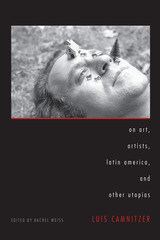 On Art, Artists, Latin America, and Other Utopias
By Luis Camnitzer
University of Texas Press, 2009 Artist, educator, curator, and critic Luis Camnitzer has been writing about contemporary art ever since he left his native Uruguay in 1964 for a fellowship in New York City. As a transplant from the "periphery" to the "center," Camnitzer has had to confront fundamental questions about making art in the Americas, asking himself and others: What is "Latin American art"? How does it relate (if it does) to art created in the centers of New York and Europe? What is the role of the artist in exile? Writing about issues of such personal, cultural, and indeed political import has long been an integral part of Camnitzer's artistic project, a way of developing an idiosyncratic art history in which to work out his own place in the picture. This volume gathers Camnitzer's most thought-provoking essays—"texts written to make something happen," in the words of volume editor Rachel Weiss. They elaborate themes that appear persistently throughout Camnitzer's work: art world systems versus an art of commitment; artistic genealogies and how they are consecrated; and, most insistently, the possibilities for artistic agency. The theme of "translation" informs the texts in the first part of the book, with Camnitzer asking such questions as "What is Latin America, and who asks the question? Who is the artist, there and here?" The texts in the second section are more historically than geographically oriented, exploring little-known moments, works, and events that compose the legacy that Camnitzer draws on and offers to his readers.
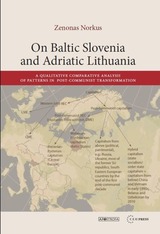 On Baltic Slovenia and Adriatic Lithuania: A Qualitative Comparative Analysis of Patterns in Post-Communist Transformation
Zenonas Norkus
Central European University Press, 2012 A unique application of social science software to generate typology and ranklist of transition models of twenty-nine countries in Europe and Asia, ranging from Estonia to Vietnam, Norkus provides a highly innovative internationally comparative causal analysis of the variation in political and economic outcomes after the first decade of post-communist transformations, using multi-value Qualitative Comparative Analysis and Tosmana programme. The analysis includes a critical revision of received dichotomies (e.g. on gradualism versus “shock therapy”), and contributes to current debates on the varieties of post-communist capitalism.This conceptual framework is applied in national case studies, searching for reasons behind successes and failures, with special consideration given to the possibility of alternatives to the Lithuanian way, and the challenges of populism in this country’s politics.
 On Barbecue
John Shelton Reed
University of Tennessee Press, 2021 John Shelton Reed is one of today’s most knowledgeable authors on the subject of barbecue. Holy Smoke: The Big Book of North Carolina Barbecue, written with his wife, Dale Volberg Reed, won the National Barbecue Association Award of Excellence in 2017 and was a finalist for the 2009 International Associate of Culinary Professionals Cookbook Award. In this collection, On Barbecue, Reed compiles reviews, essays, magazine articles, op-eds, and book extracts from his many-year obsession with the history and culture of barbecue. Brought together, these pieces constitute a broad look at the cultural, culinary, historical, and social aspects of this American institution.
Reed’s original and provocative voice carries through this collection, which spans more than twenty years of barbecue lore. A lover of tradition whose study of regional distinctions has made him prize and defend them, Reed writes with conviction on what “real” barbecue looks, smells, and tastes like. He delves into the history of barbecue and even the origins of the word barbecue itself. Other topics include present-day barbecue, Carolina ’cue and other regional varieties, and even the role of "barbeculture" in the 2016 U.S. presidential elections.
Anyone with an interest in this signature American food will find themselves immersed in this book’s accessible, conversational, and frequently tart pages. From one of the wittiest and most knowledgeable authors writing on the subject, On Barbecue is essential reading.
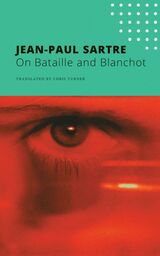 On Bataille and Blanchot
Jean-Paul Sartre
Seagull Books, 2021 An in-depth analysis of two of Sartre’s contemporaries, Bataille and Blanchot.
Iconic French novelist, playwright, and essayist Jean-Paul Sartre is widely recognized as one of the most important philosophers of the twentieth century, and his work has remained relevant and thought-provoking through the decades. The Seagull Sartre Library now presents some of his most incisive philosophical, cultural, and literary critical essays in twelve newly designed and affordable editions.
“There is a crisis of the essay,” begins Sartre as he ventures into a long analysis of the work of one of his contemporaries who he argues might save this form: Georges Bataille. From there, Sartre moves on in this compact volume to consider Aminadab, the most important work of another hugely influential philosopher, Maurice Blanchot, through whom, writes Sartre, “the literature of the fantastic continues the steady progress that will inevitably unite it, ultimately, with what it has always been.”
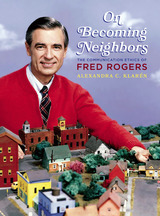 On Becoming Neighbors: The Communication Ethics of Fred Rogers
Alexandra C. Klaren
University of Pittsburgh Press, 2019
Winner, 2020 NCA Top Single-Author Book of the Year Award
Fred Rogers is an American cultural and media icon, whose children’s television program, Mister Rogers’ Neighborhood, ran for more than thirty years (1967-2001) on the Public Broadcasting System. In this highly original book, communication scholar Alexandra C. Klarén shows how Rogers captured the moral, social, and emotional imaginations of multiple generations of Americans. She explores the nuanced complexity of the thought behind the man and the program, the dialogical integration of his various influences, and the intentional ethic of care behind the creation of a program that spoke to the affective, cultural, and educational needs of children (and adults) during a period of cultural and political upheaval. Richly informed by newly available archival materials, On Becoming Neighbors chronicles the evolution of Rogers’ thought on television, children, pedagogy, and the family through a rhetorical, cultural, and ethical lens. Klarén probes how Rogers creates the conditions for dialogue in which participants explore possibilities and questions relating to the social and material world.
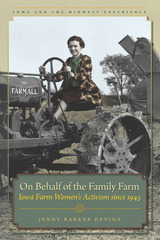 On Behalf of the Family Farm: Iowa Farm Women's Activism since 1945
Jenny Barker Devine
University of Iowa Press, 2013 On Behalf of the Family Farm traces the development of women’s activism and agrarian feminisms in the Midwest after 1945, as farm women’s lives were being transformed by the realities of modern agriculture. Author Jenny Barker Devine demonstrates that in an era when technology, depopulation, and rapid economic change dramatically altered rural life, midwestern women met these challenges with their own feminine vision of farm life. Their “agrarian feminisms” offered an alternative to, but not necessarily a rejection of, second-wave feminism.
Focusing on women in four national farm organizations in Iowa—the Farm Bureau, the Farmers Union, the National Farm Organization, and the Porkettes—Devine highlights specific moments in time when farm women had to reassess their roles and strategies for preserving and improving their way of life. Rather than retreat from the male-dominated world of agribusiness and mechanized production, postwar women increasingly asserted their identities as agricultural producers and demanded access to public spaces typically reserved for men.
Over the course of several decades, they developed agrarian feminisms that combined cherished rural traditions with female empowerment, cooperation, and collaboration. Iowa farm women emphasized working partnerships between husbands and wives, women’s work in agricultural production, and women’s unique ways of understanding large-scale conventional farming.
 On Being Free
Frithjof Bergmann
University of Notre Dame Press, 1977 “A breath of fresh air. Not only does Bergmann give good reasons why standard contemporary philosophical views on freedom are fundamentally off base, but he also displays why current educational disputes over regimented vs. permissive education, and political debates over regulated vs. unregulated society, are grounded in irrelevant and confused notions of freedom. The book is brilliant and terribly exciting.” —-Frederick Suppe
With extraordinary elegance and philosophic power, Frithjof Bergmann presents a genuine rethinking of freedom. By changing the focus from outside to inside the person, Bergmann shows how freedom can be a reality in self-growth, parenting, education, and in shaping a society that stimulates rather than stunts the self. Rejecting the standard views of freedom as an external ideal that progressively removes obstacles or as an irrational, unencumbered act that rejects all order, Bergmann argues that the primary prerequisite of freedom is a self possessed of something that wants to be acted out. An act is free if the agent identifies with the elements from which it flows. Such identification is logically prior to freedom. At the same time, this points to the problem of coming to a true understanding of one’s self and to the difficulty of building a society that contains objects with which a self can identify or, at least, a society of which the self is not ashamed.
On Being Human: Folklore of Mormon Missionaries
William A. Wilson
Utah State University Press, 1981 A collection of narratives, humorous stories, and songs from Mormon missionaries that has become a classic study of narrative folklore. The 64th annual Faculty Honor Lecture, in the Humanities, Utah State University.
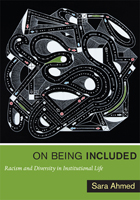 On Being Included: Racism and Diversity in Institutional Life
Sara Ahmed
Duke University Press, 2012 What does diversity do? What are we doing when we use the language of diversity? Sara Ahmed offers an account of the diversity world based on interviews with diversity practitioners in higher education, as well as her own experience of doing diversity work. Diversity is an ordinary, even unremarkable, feature of institutional life. Yet diversity practitioners often experience institutions as resistant to their work, as captured through their use of the metaphor of the "brick wall." On Being Included offers an explanation of this apparent paradox. It explores the gap between symbolic commitments to diversity and the experience of those who embody diversity. Commitments to diversity are understood as "non-performatives" that do not bring about what they name. The book provides an account of institutional whiteness and shows how racism can be obscured by the institutionalization of diversity. Diversity is used as evidence that institutions do not have a problem with racism. On Being Included offers a critique of what happens when diversity is offered as a solution. It also shows how diversity workers generate knowledge of institutions in attempting to transform them.
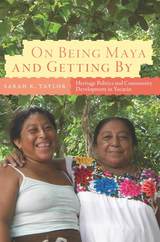 On Being Maya and Getting By: Heritage Politics and Community Development in Yucatán
Sarah R. Taylor
University Press of Colorado, 2018 On Being Maya and Getting By is an ethnographic study of the two Ek’Balams—a notable archaeological site and adjacent village—of the Yucatán Peninsula. When the archaeological site became a tourist destination, the village became the location of a community-based tourism development project funded by the Mexican government. Overt displays of heritage and a connection to Maya antiquity became important and profitable for the modern Maya villagers. Residents of Ek’Balam are now living in a complex ecosystem of natural and cultural resources where the notion and act of “being Maya” is deeply intertwined with economic development.
The book explores how Ek’Balam villagers negotiate and maneuver through a web of social programs, tourists, volunteers, and expectations while living their daily lives. Focusing on the active processes in which residents choose to participate, author Sarah R. Taylor provides insights into how the ideological conflicts surrounding economic development play out in the negotiations between internal community politics and external social actors. The conflicts implicit to conceptions of “community” as a target for development are made explicit through the systematic questioning of what exactly it means to be a member of a local, indigenous, or sustainable community in the process of being developed.
On Being Maya and Getting By is a rich description of how one community is actively negotiating with tourism and development and also a call for a more complex analysis of how rural villages are connected to greater urban, national, and global forces.
 On Being Nonprofit: A Conceptual and Policy Primer
Peter Frumkin
Harvard University Press, 2005 This concise and illuminating book provides a road map to the evolving conceptual and policy terrain of the nonprofit sector. Drawing on prominent economic, political, and sociological explanations of nonprofit activity, Peter Frumkin focuses on four important functions that have come to define nonprofit organizations. The author clarifies the debate over the underlying rationale for the nonprofit and voluntary sector's privileged position in America by examining how nonprofits deliver needed services, promote civic engagement, express values and faith, and channel entrepreneurial impulses. He also exposes the difficult policy questions that have emerged as the boundaries between the nonprofit, business, and government sectors have blurred. Focusing on nonprofits' growing dependence on public funding, tendency toward political polarization, often idiosyncratic missions, and increasing commercialism, Peter Frumkin argues that the long-term challenges facing nonprofit organizations will only be solved when they achieve greater balance among their four central functions. By probing foundational thinking as well as emergent ideas, the book is an essential guide for nonprofit novitiates and experts alike who want to understand the issues propelling public debate about the future of their sector. By virtue of its breadth and insight, Frumkin's book will be an invaluable resource for anyone interested in understanding the complex interplay of public purposes and private values that animate nonprofit organizations.
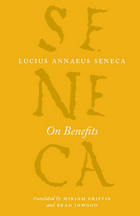 On Benefits
Lucius Annaeus Seneca
University of Chicago Press, 2011 Lucius Annaeus Seneca (4 BCE–65 CE) was a Roman Stoic philosopher, dramatist, statesman, and advisor to the emperor Nero, all during the Silver Age of Latin literature. The Complete Works of Lucius Annaeus Seneca is a fresh and compelling series of new English-language translations of his works in seven accessible volumes. Edited by world-renowned classicists Elizabeth Asmis, Shadi Bartsch, and Martha C. Nussbaum, this engaging collection restores Seneca—whose works have been highly praised by modern authors from Desiderius Erasmus to Ralph Waldo Emerson—to his rightful place among the classical writers most widely studied in the humanities.
On Benefits, written between 56 and 64 CE, is a treatise addressed to Seneca’s close friend Aebutius Liberalis. The longest of Seneca’s works dealing with a single subject—how to give and receive benefits and how to express gratitude appropriately—On Benefits is the only complete work on what we now call “gift exchange” to survive from antiquity. Benefits were of great personal significance to Seneca, who remarked in one of his later letters that philosophy teaches, above all else, to owe and repay benefits well.
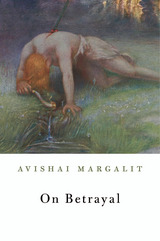 On Betrayal
Avishai Margalit
Harvard University Press, 2017 Adultery, treason, and apostasy no longer carry the weight they once did. Yet we constantly see and hear stories of betrayal, and many people have personally experienced a destructive breach of loyalty. Avishai Margalit argues that the tension between the ubiquity of betrayal and the loosening of its hold is a sign of the strain between ethics and morality, between thick and thin human relations. On Betrayal offers a philosophical account of thick human relations—relationships with friends, family, and core communities—through their pathology, betrayal.
Judgments of betrayal often shift unreliably. A whistle-blower to some is a backstabber to others; a traitor to one side is a hero to the other. Yet the notion of what it means to betray is remarkably consistent across cultures and eras. Betrayal undermines thick trust, dissolving the glue that holds our most meaningful relationships together. Recently, public attention has lingered on trust between strangers—on relations that play a central role in the globalized economy. These, according to Margalit, are guided by morality. On Betrayal is about ethics: what we owe to the people and groups that give us our sense of belonging.
Margalit’s clear-sighted account draws on literary, historical, and personal sources, including stories from his childhood during the 1948 Arab-Israeli War. Through its discussion of betrayal, it examines what our thick relationships are and should be and revives the long-discarded notion of fraternity.
|
|
